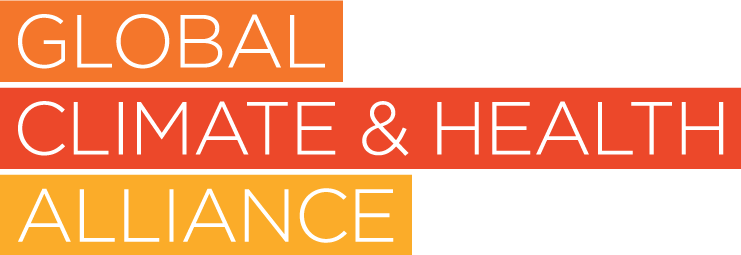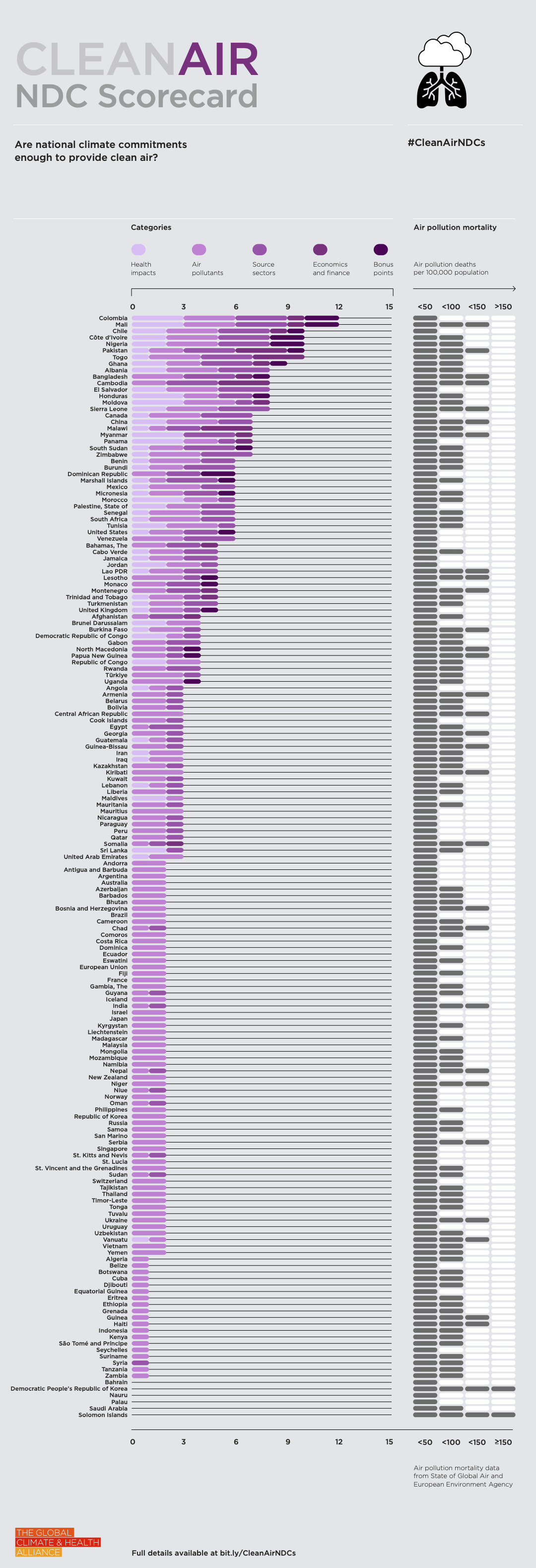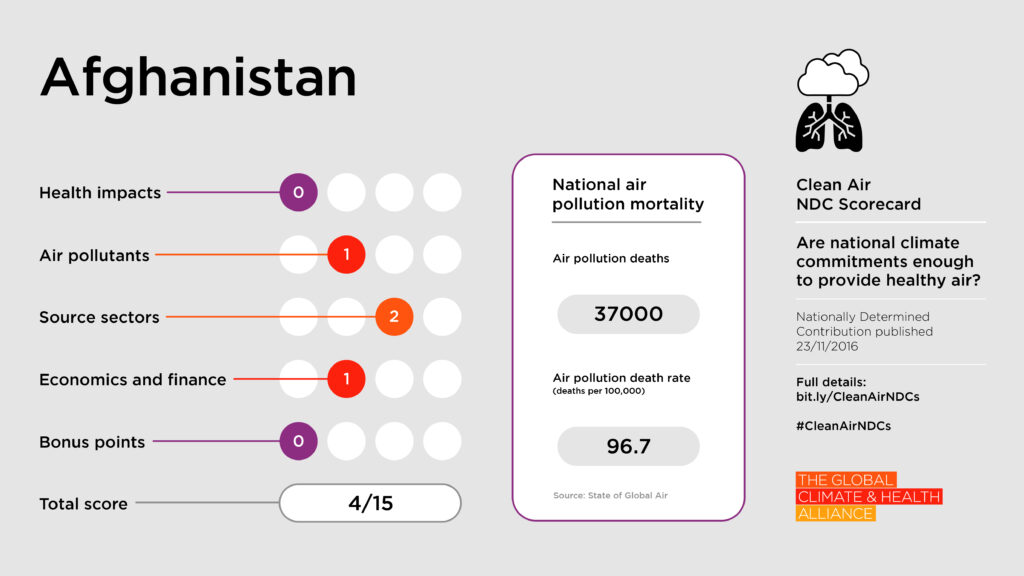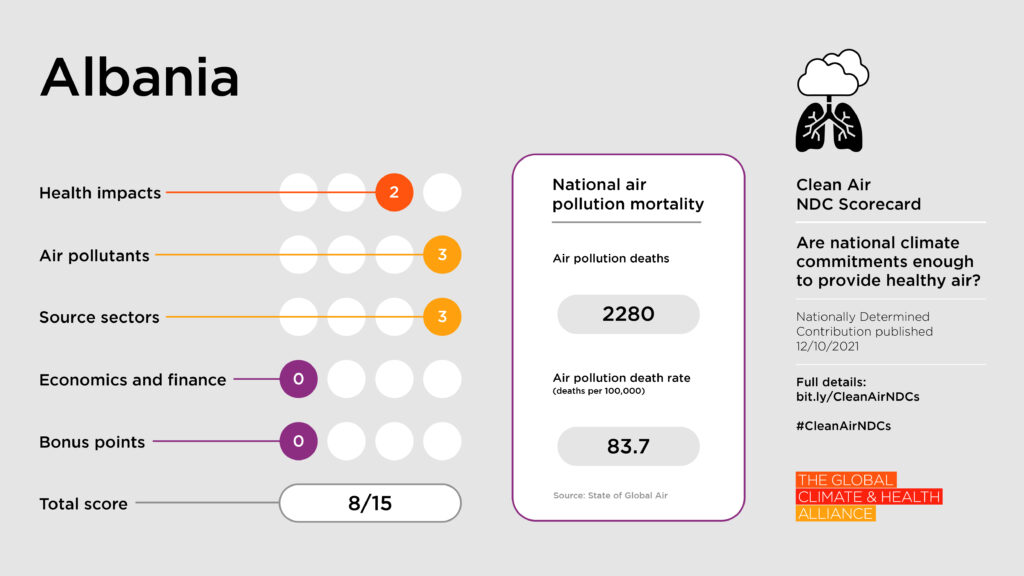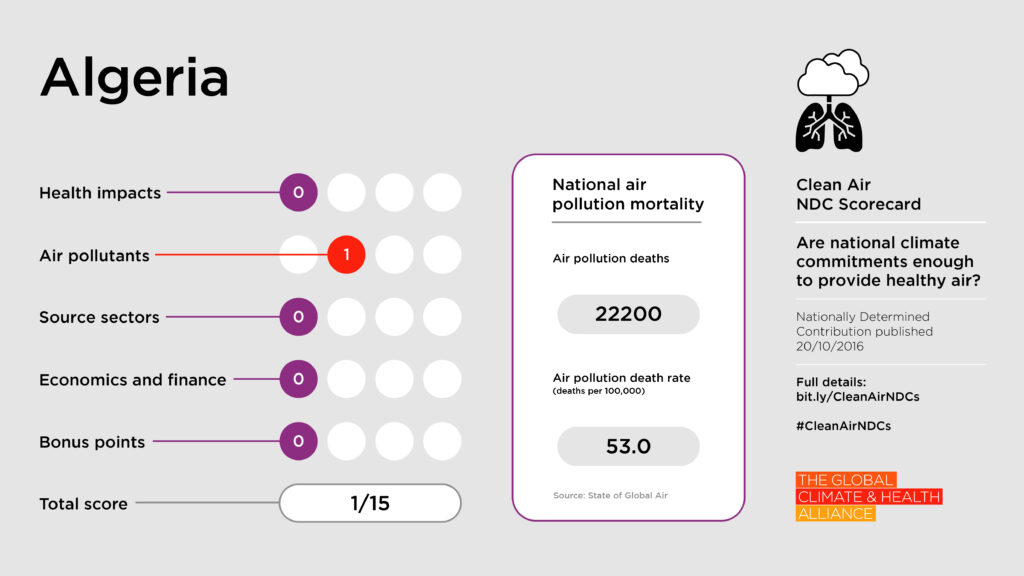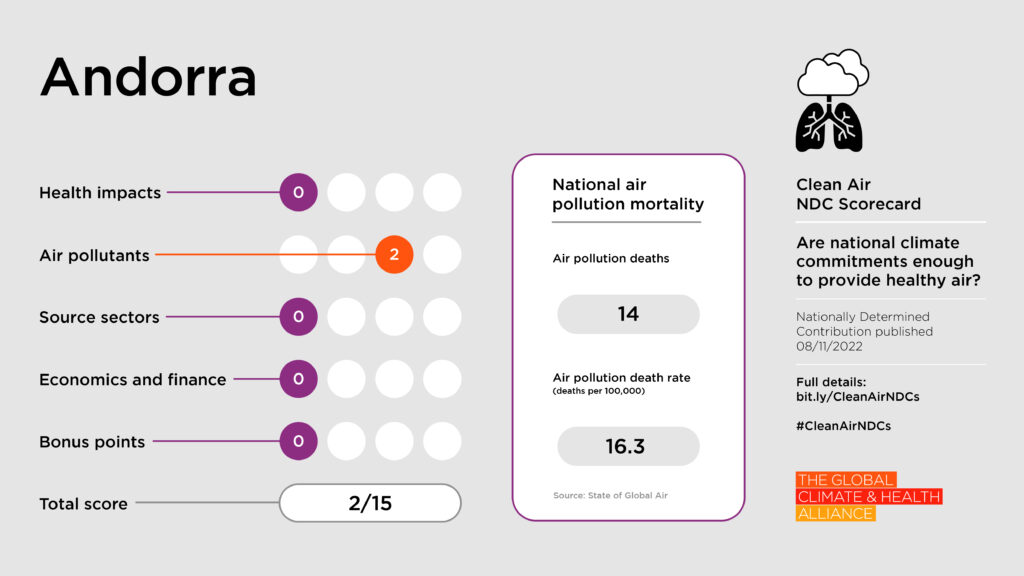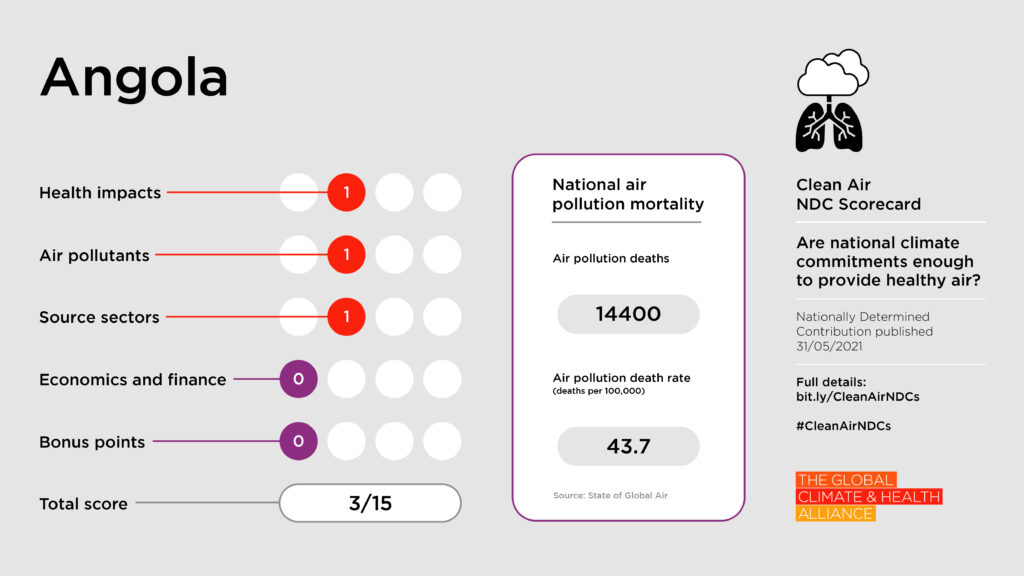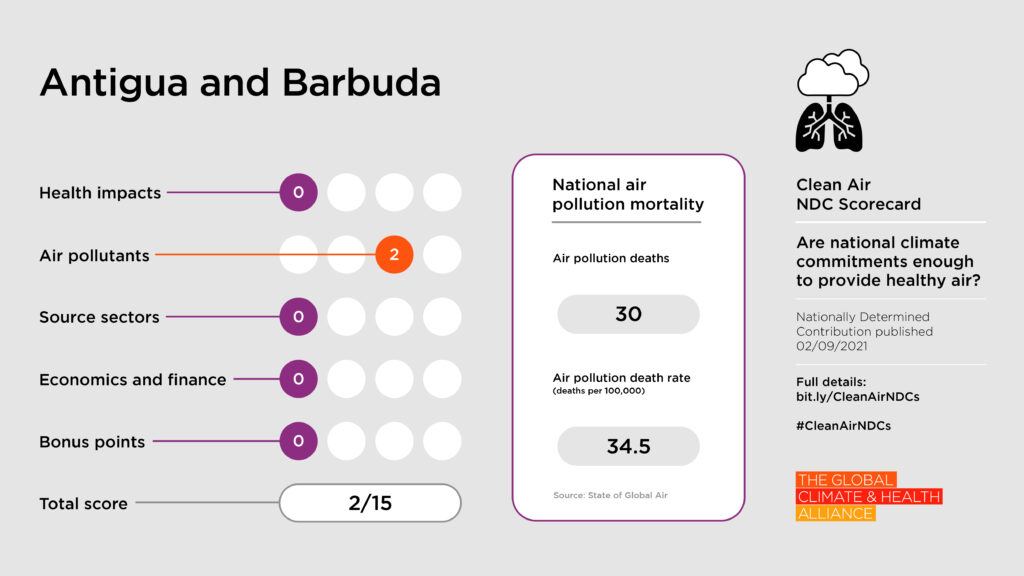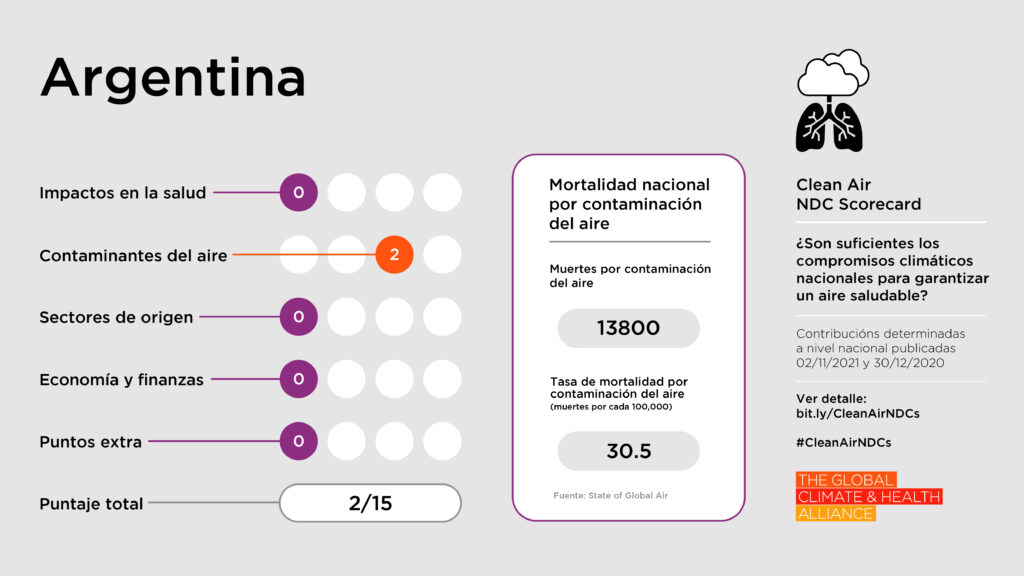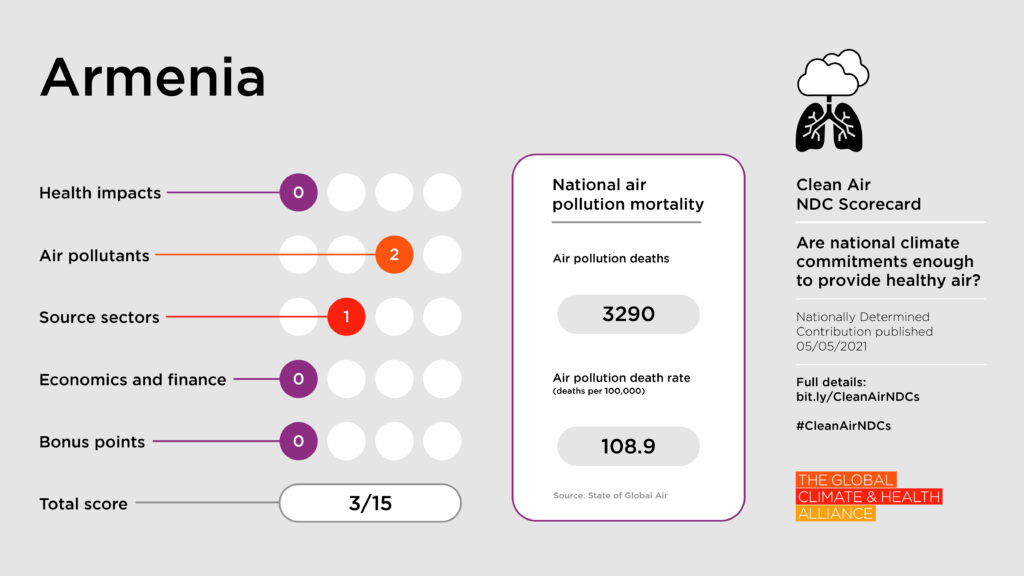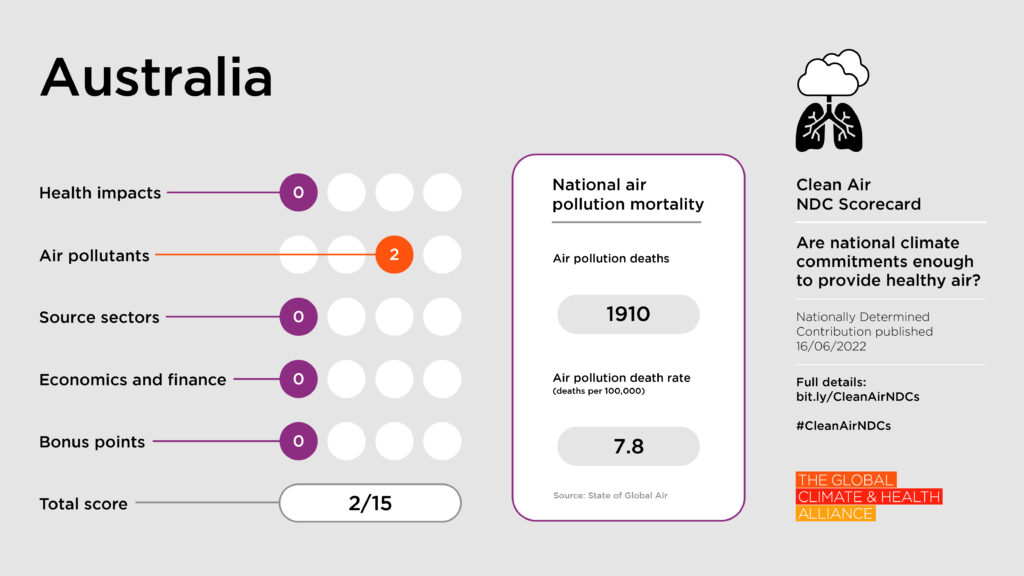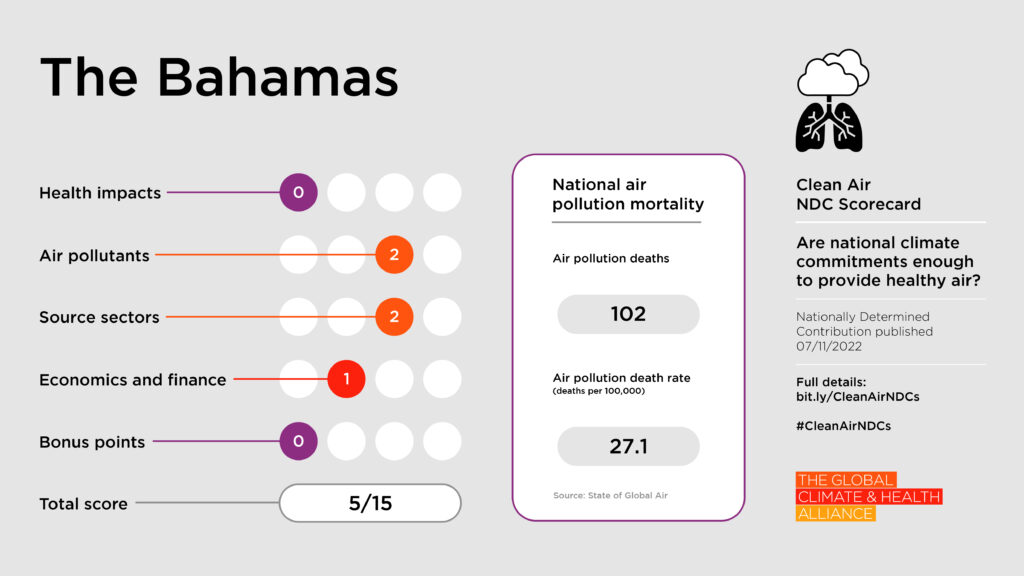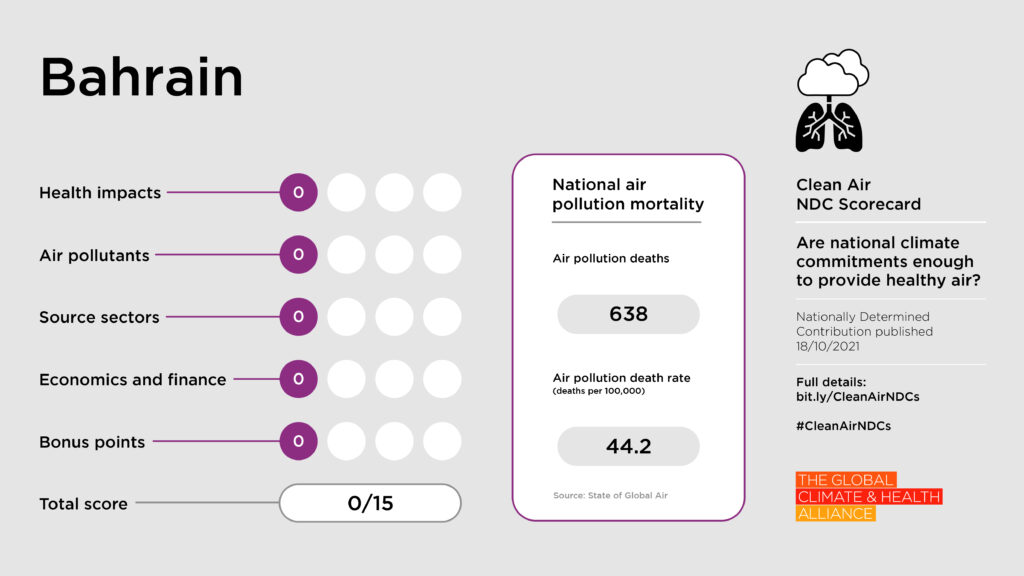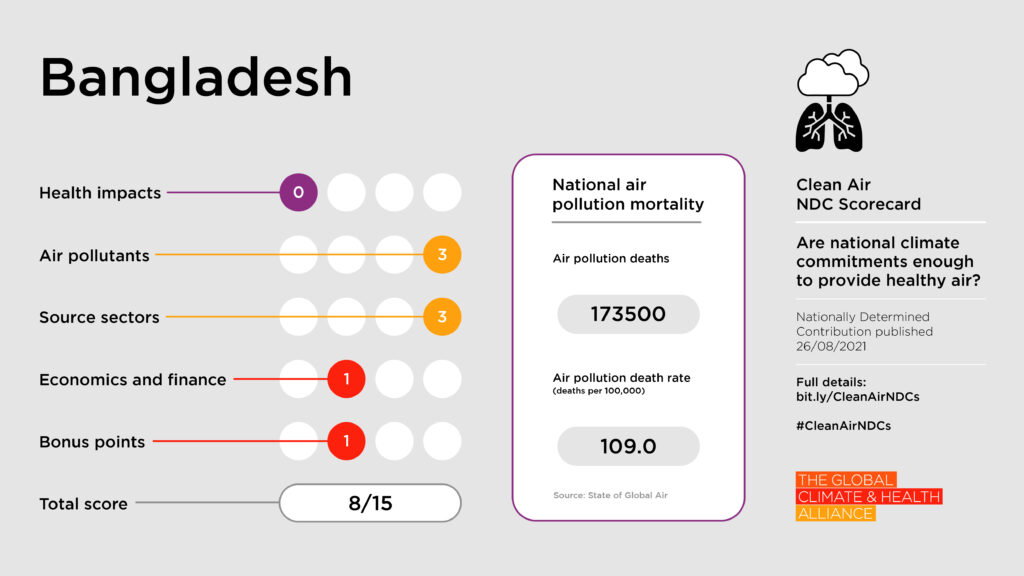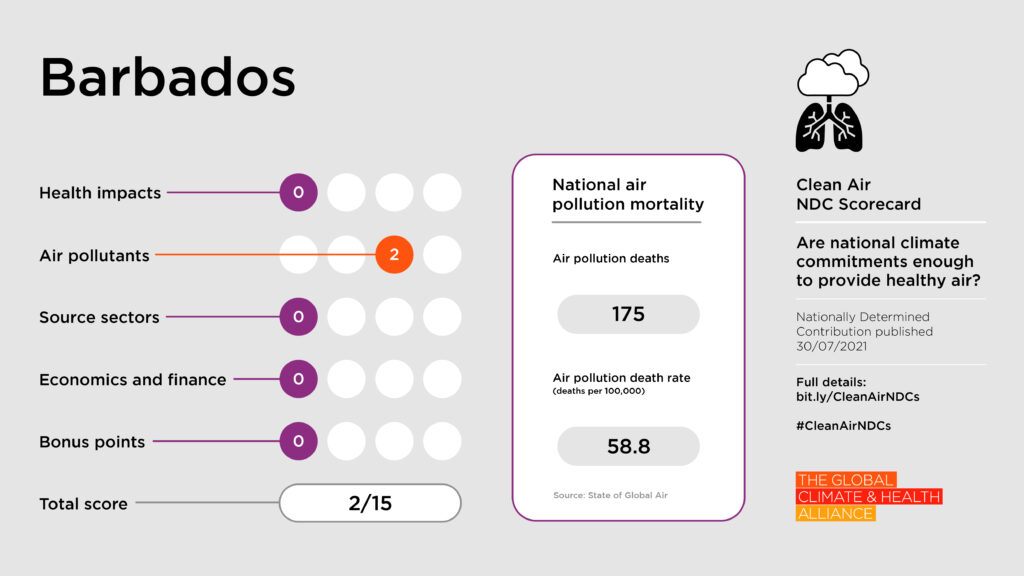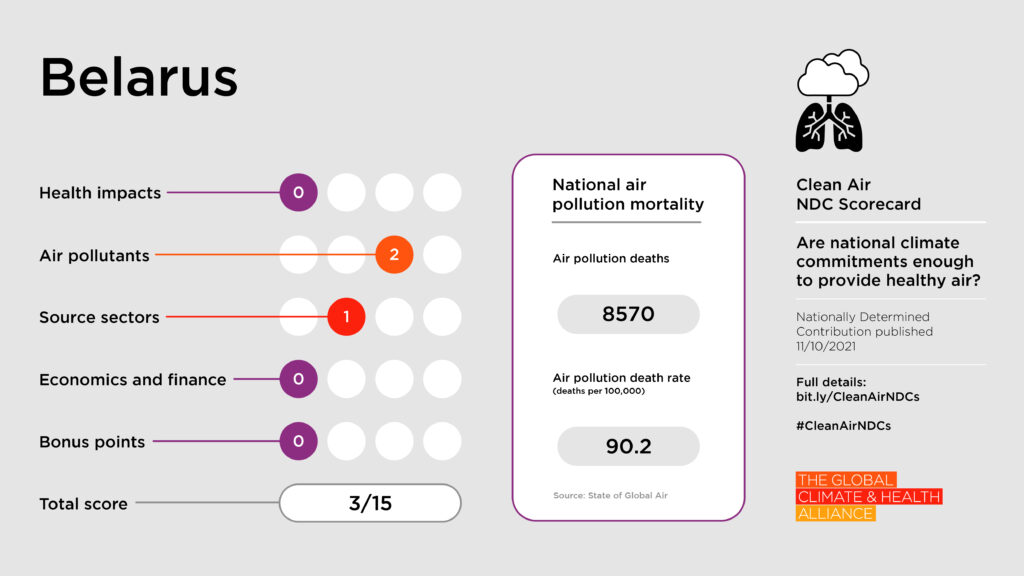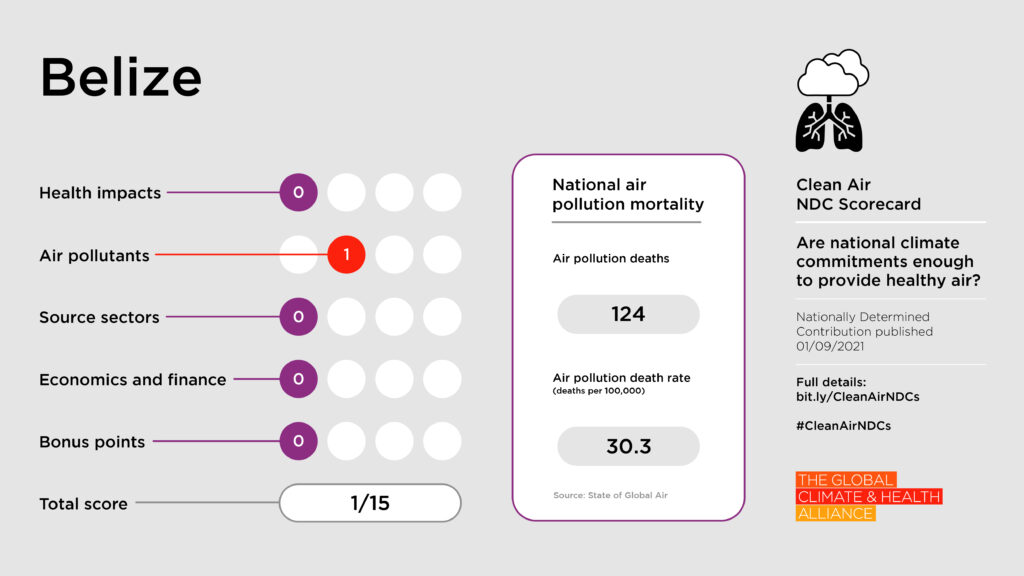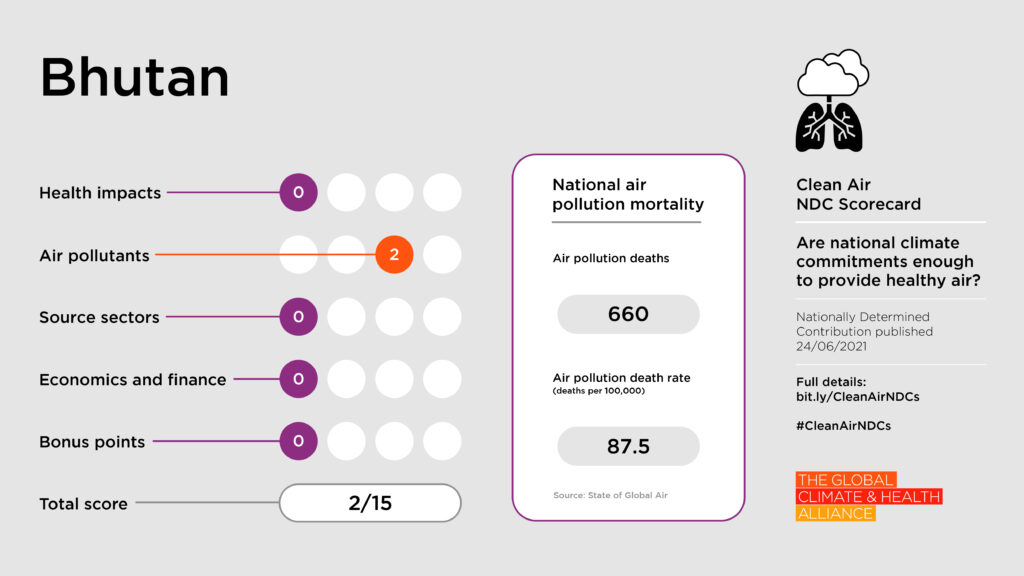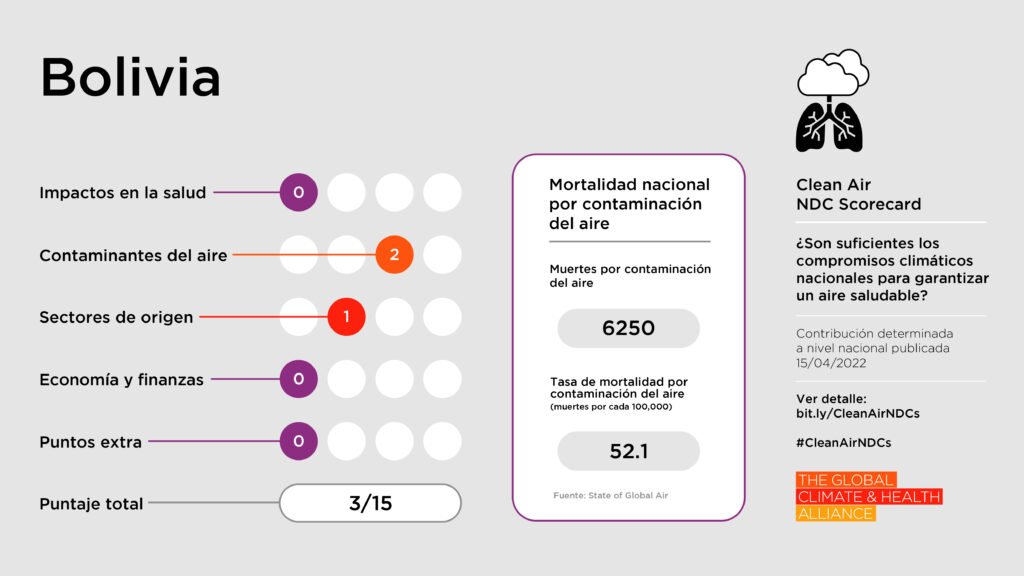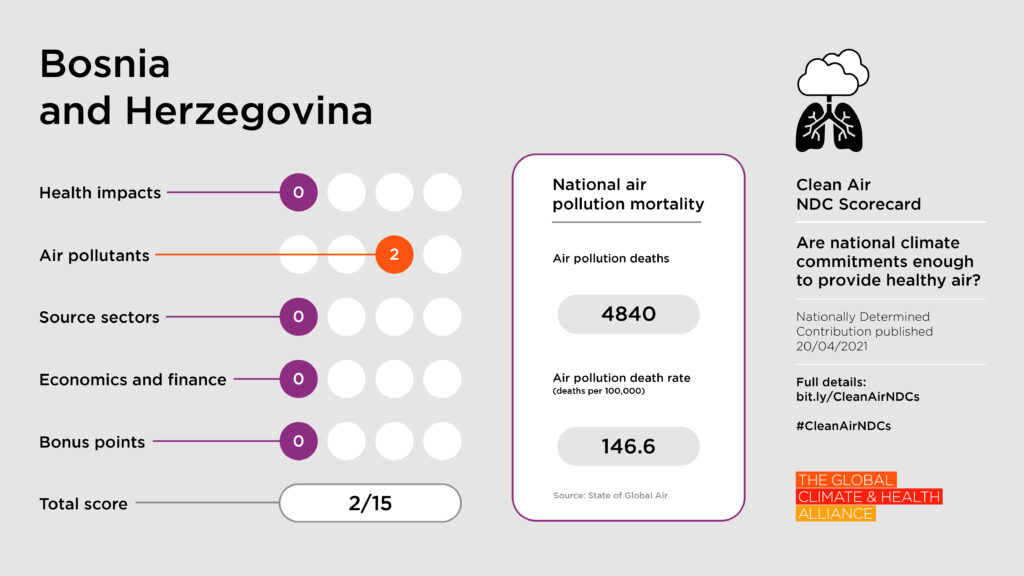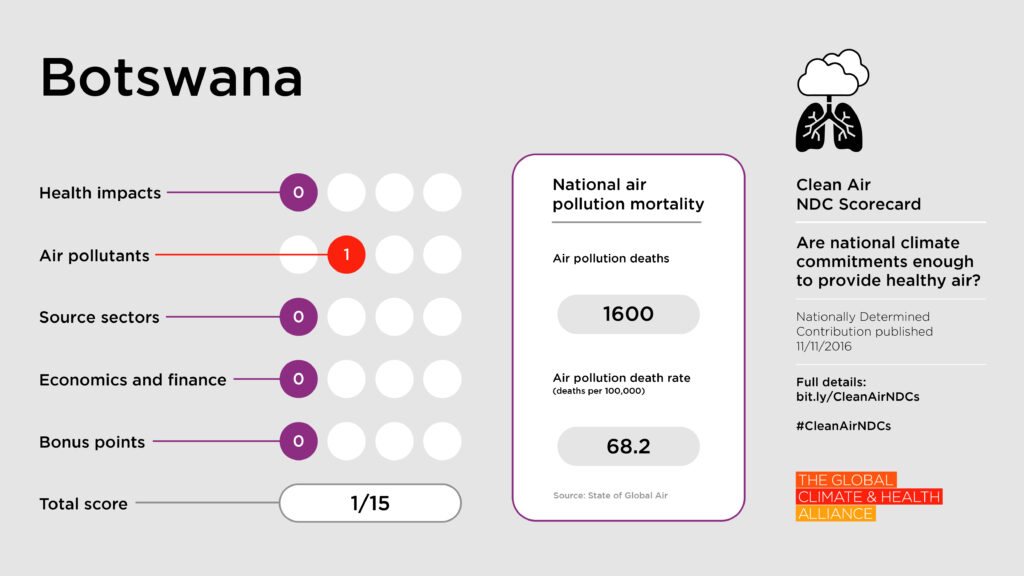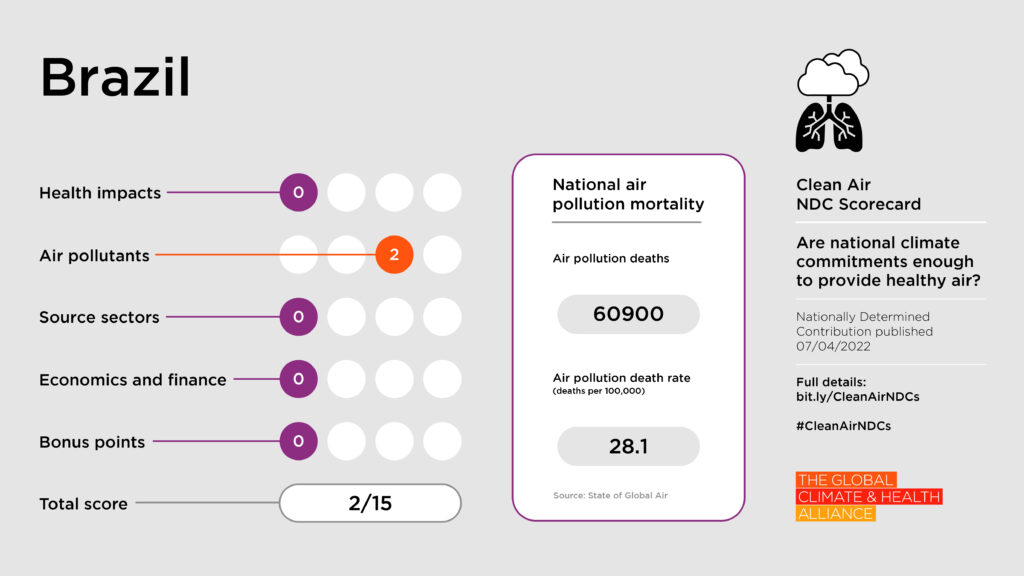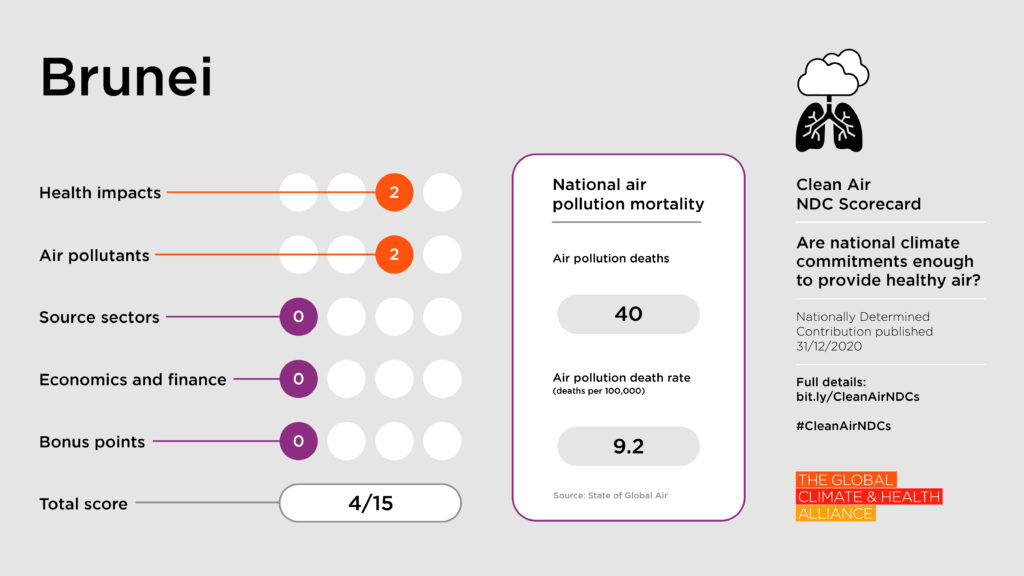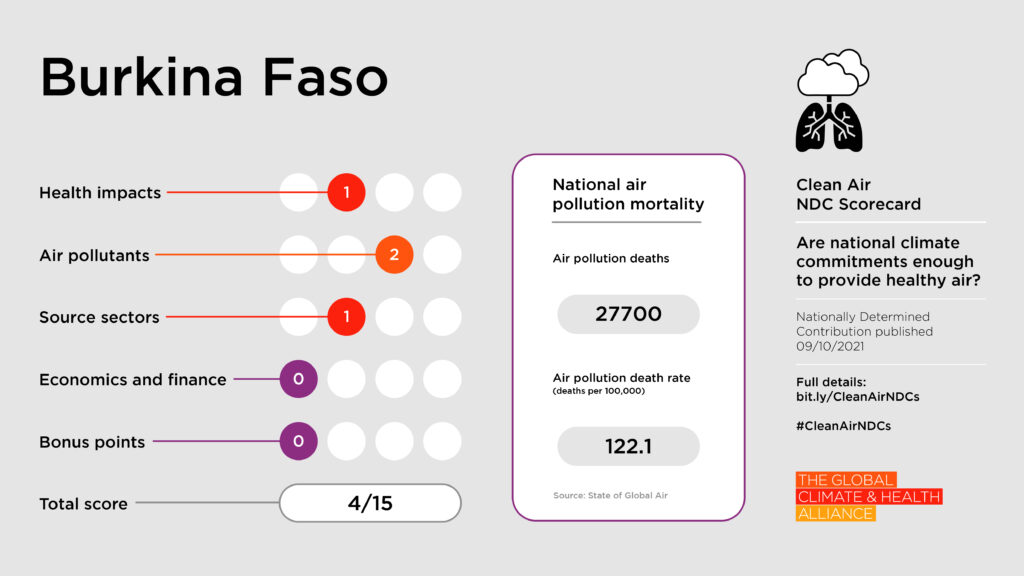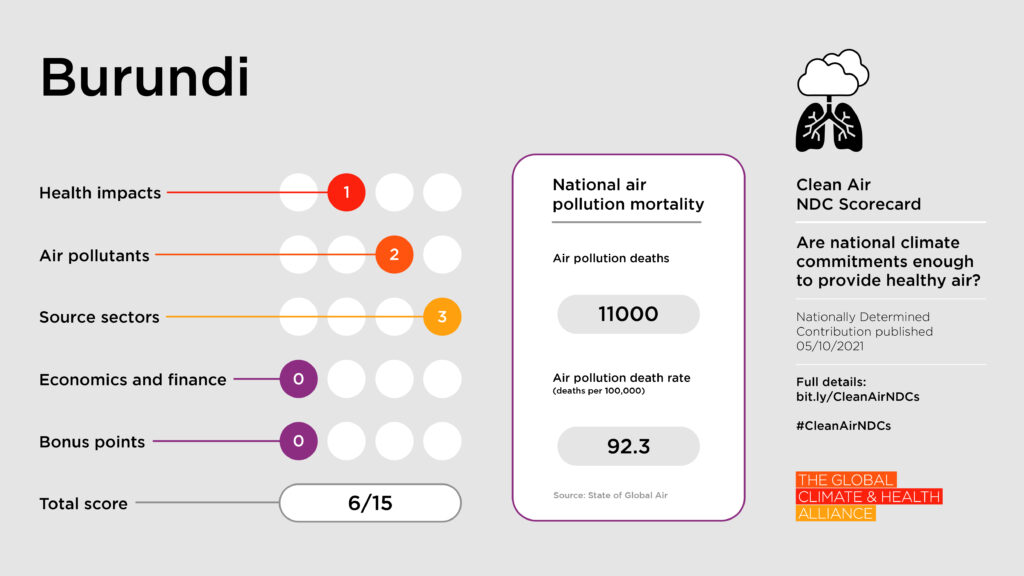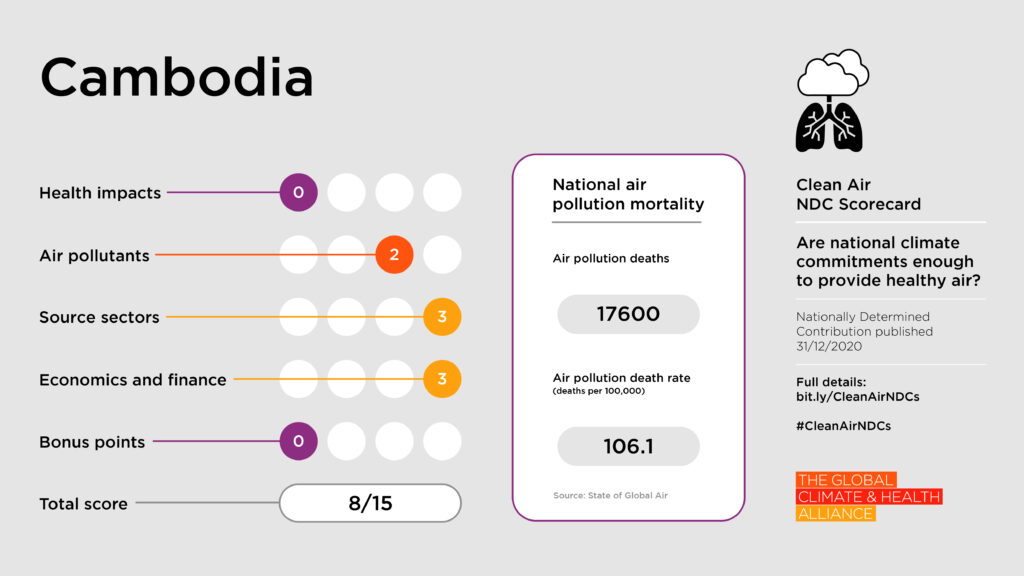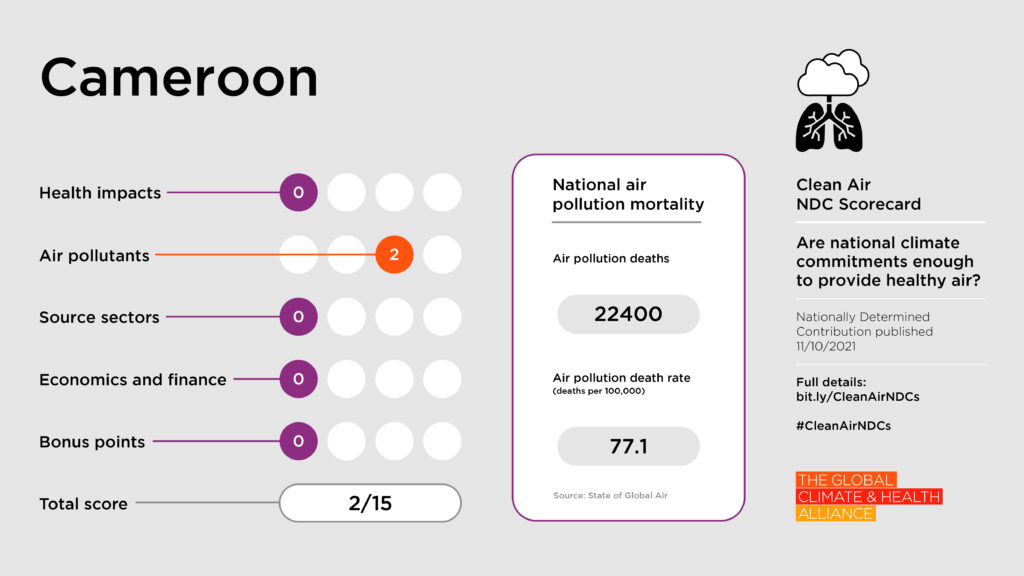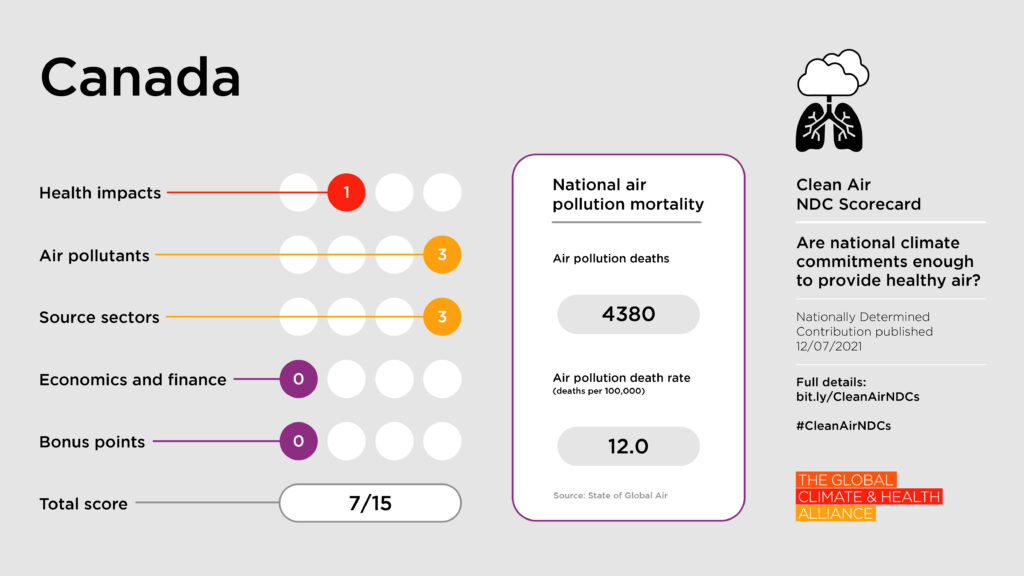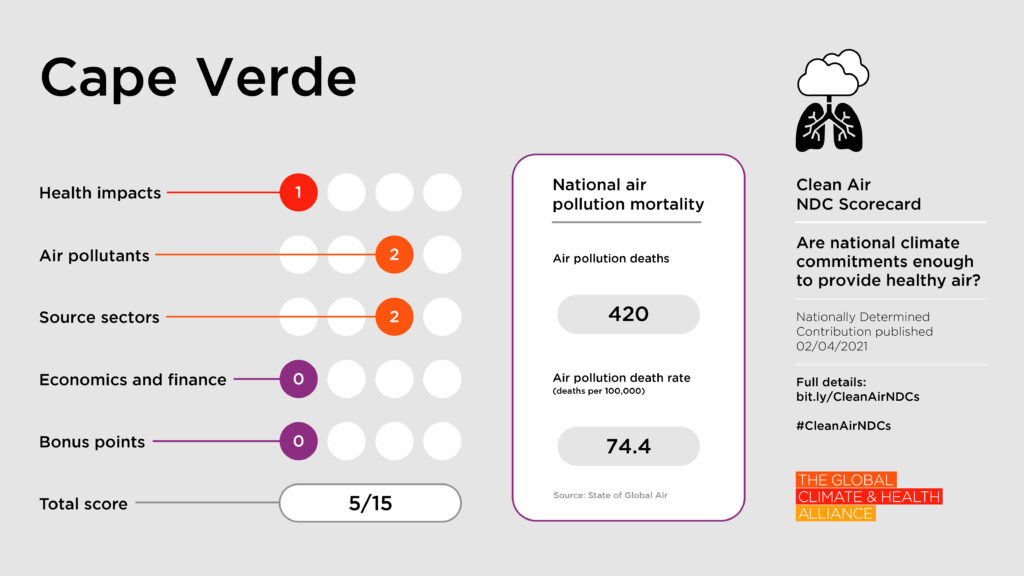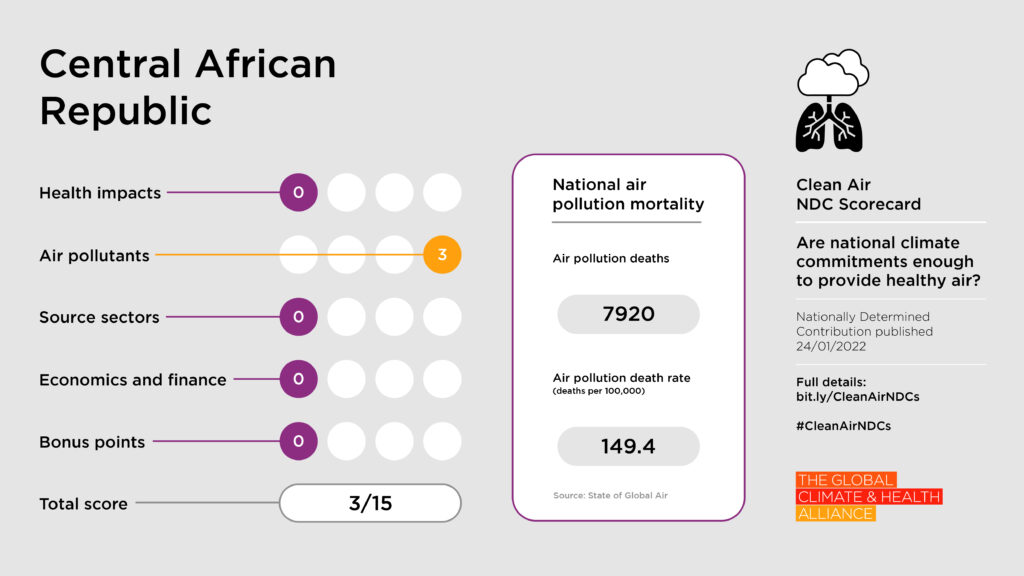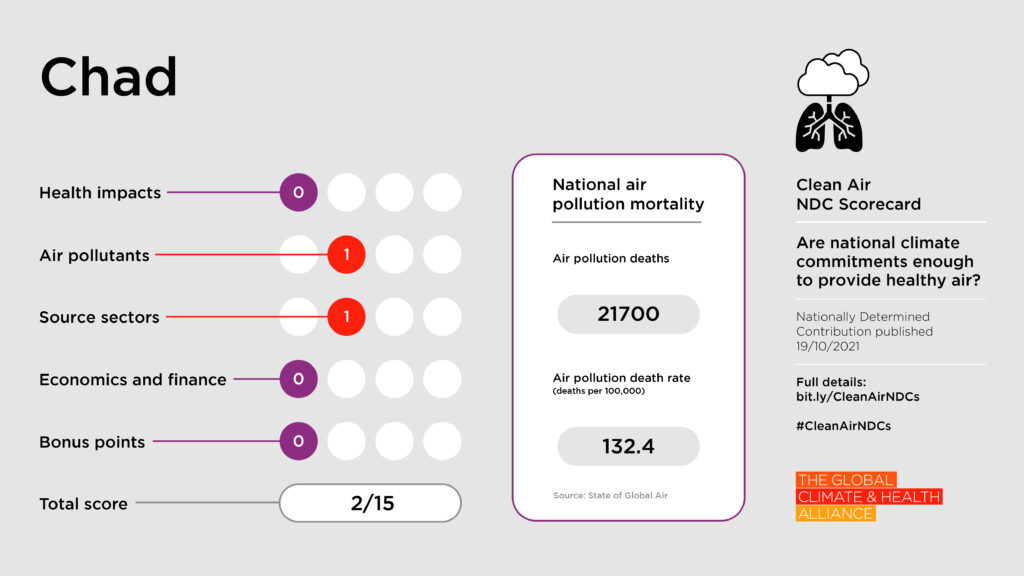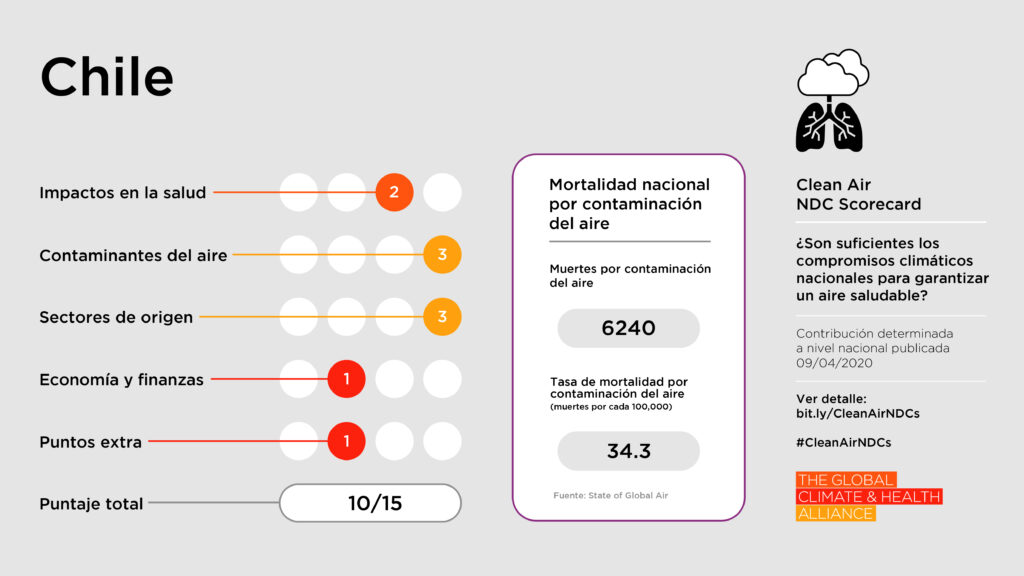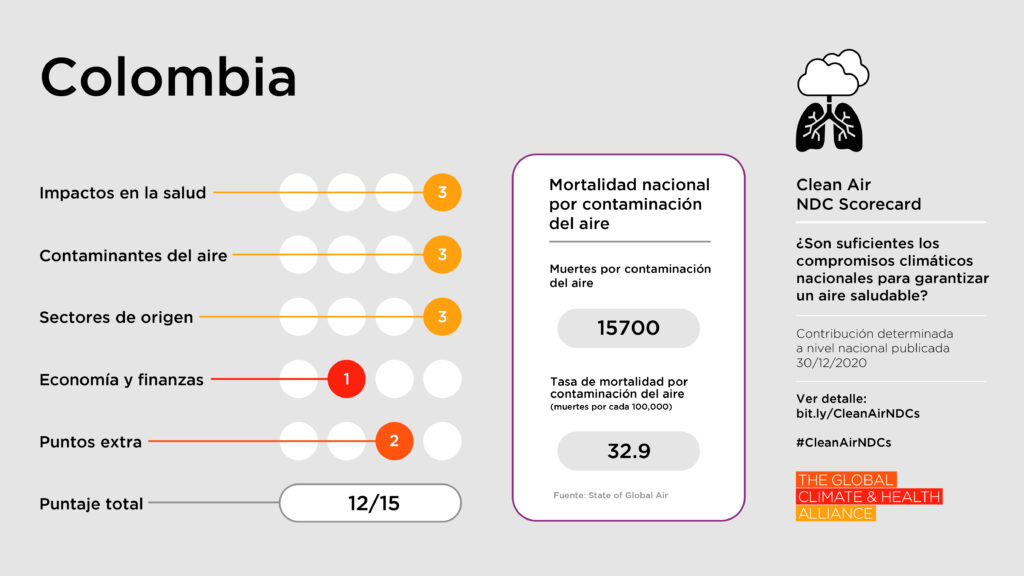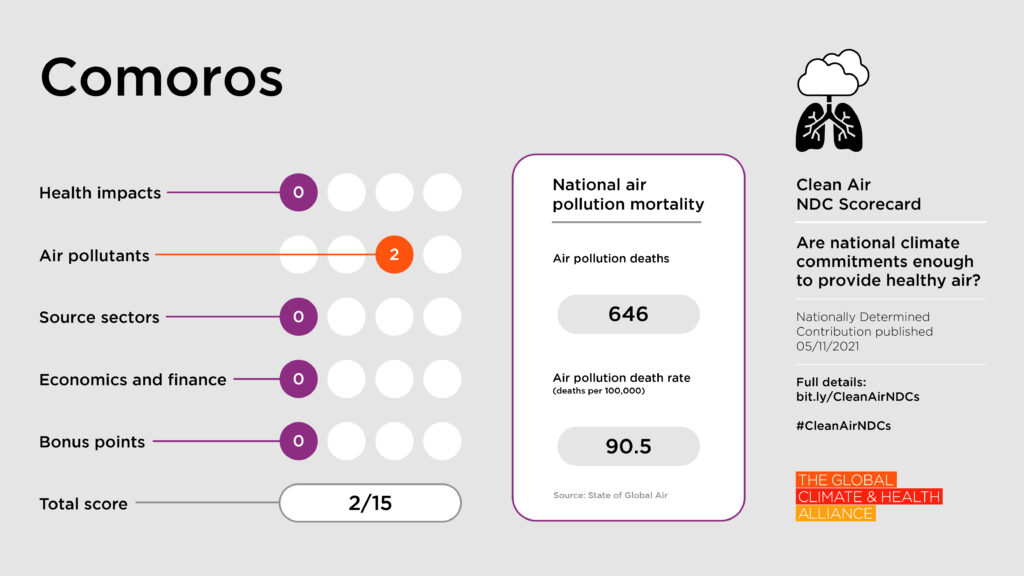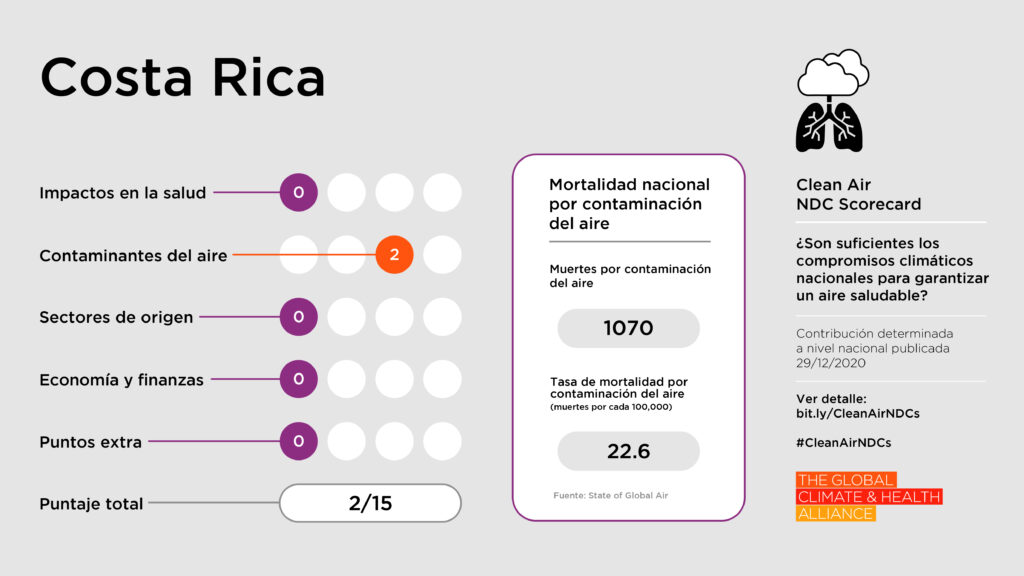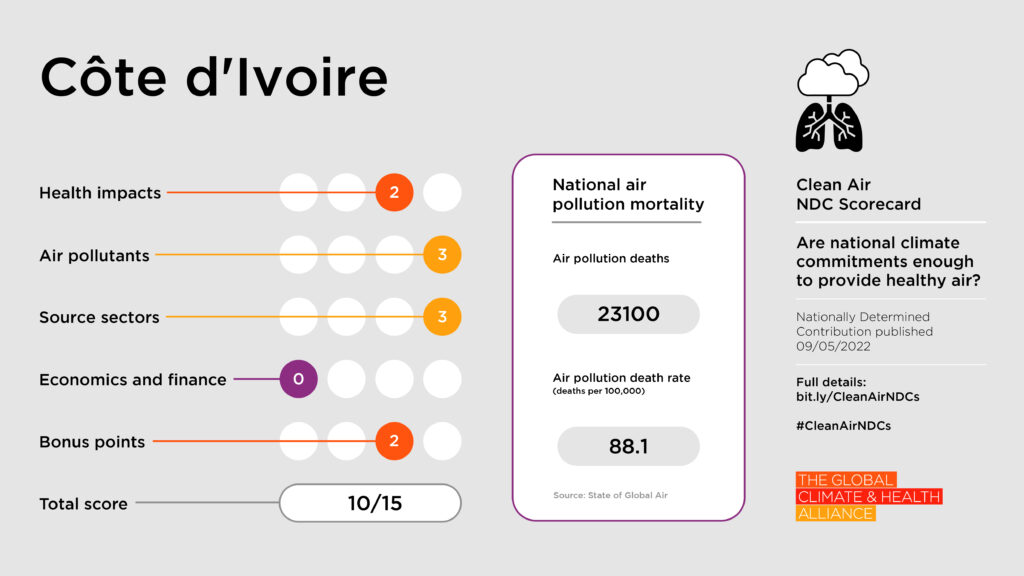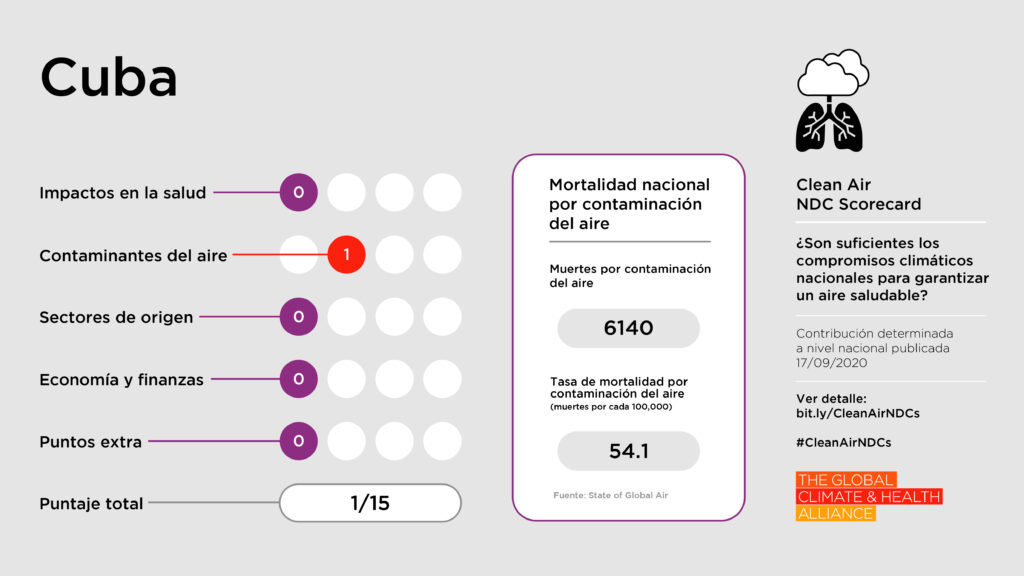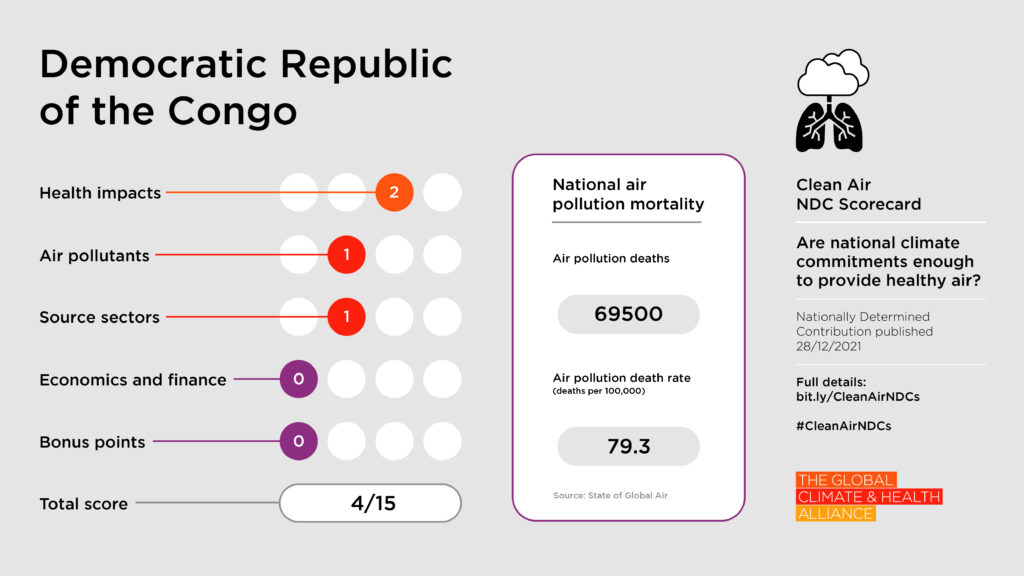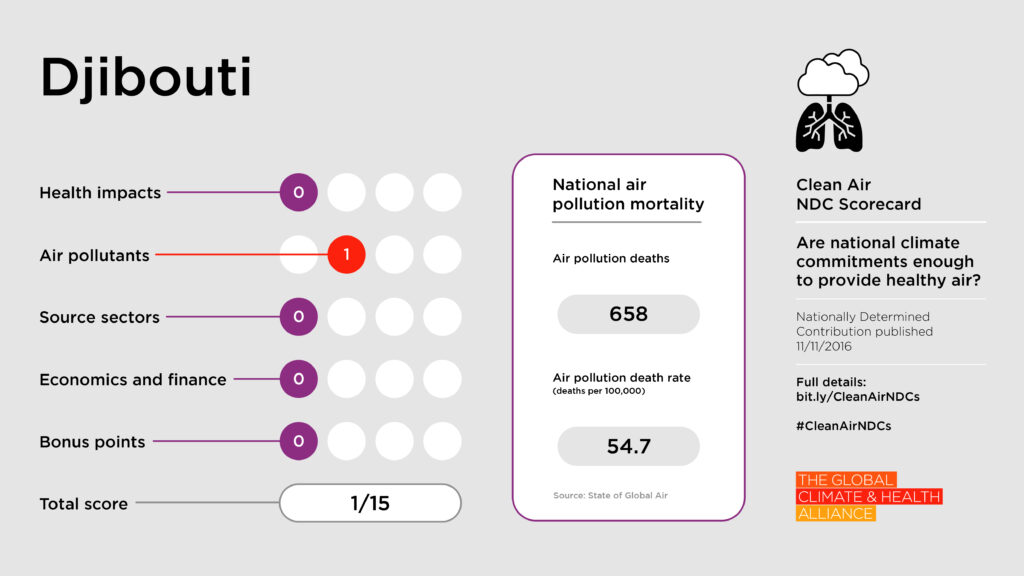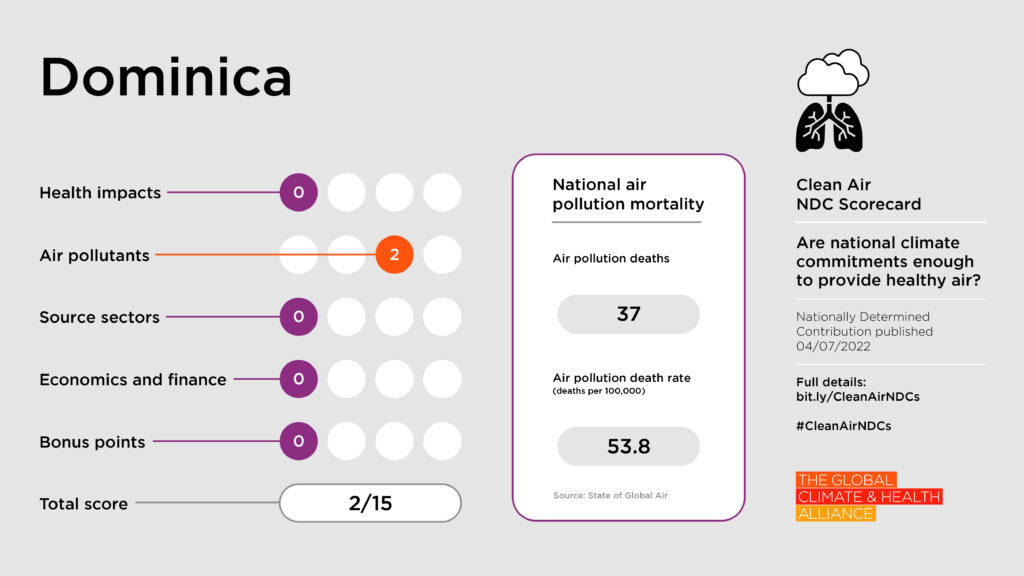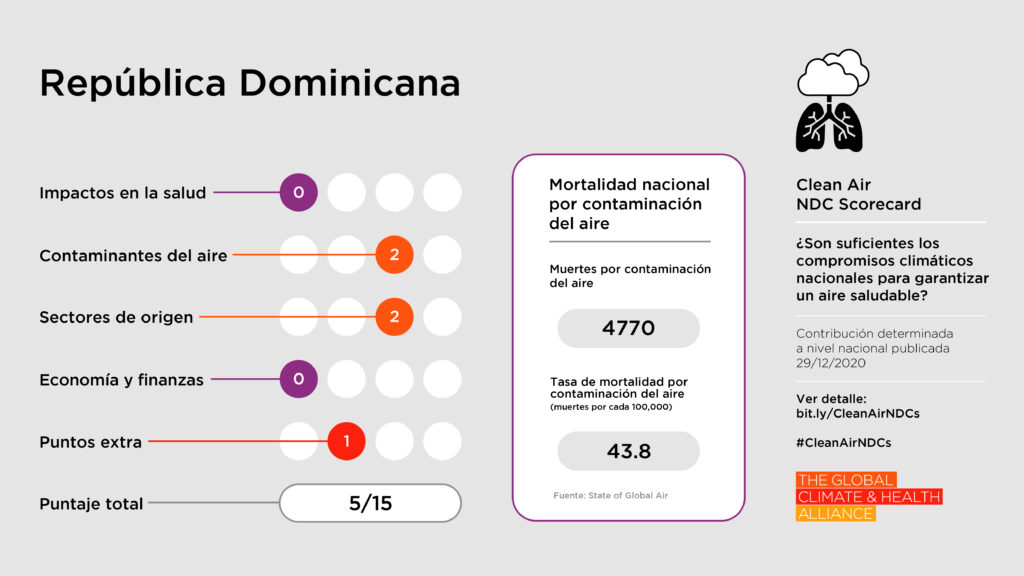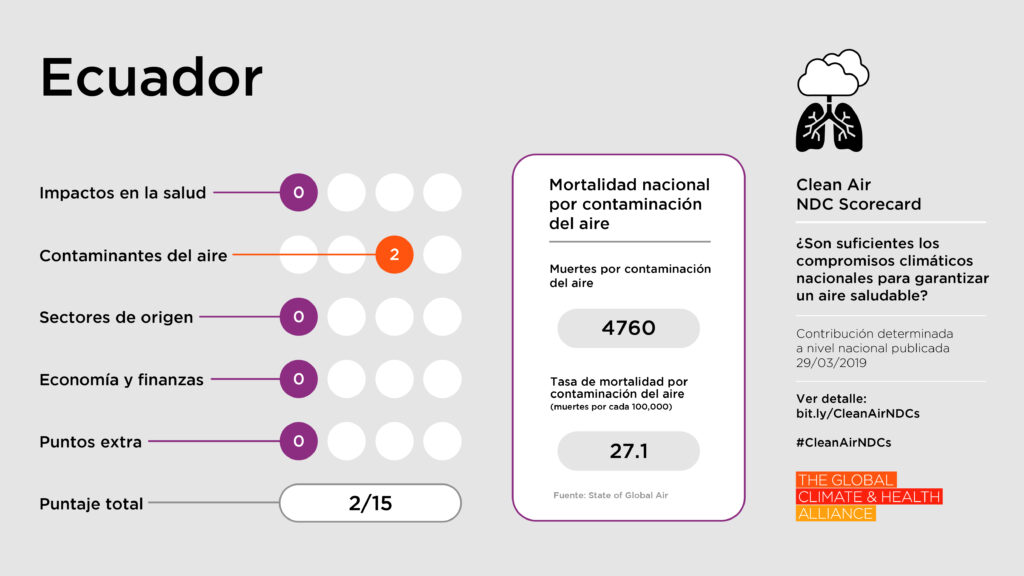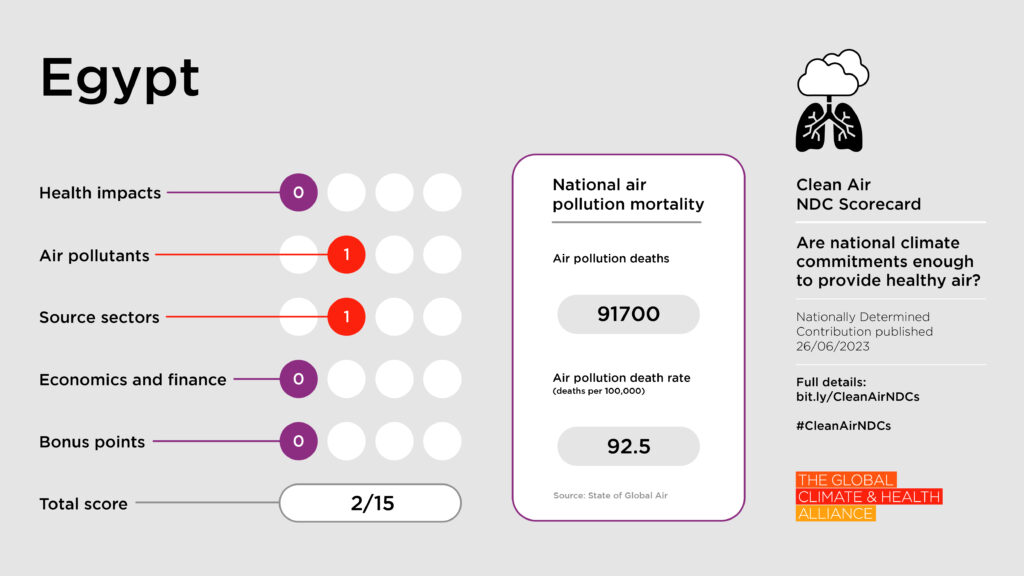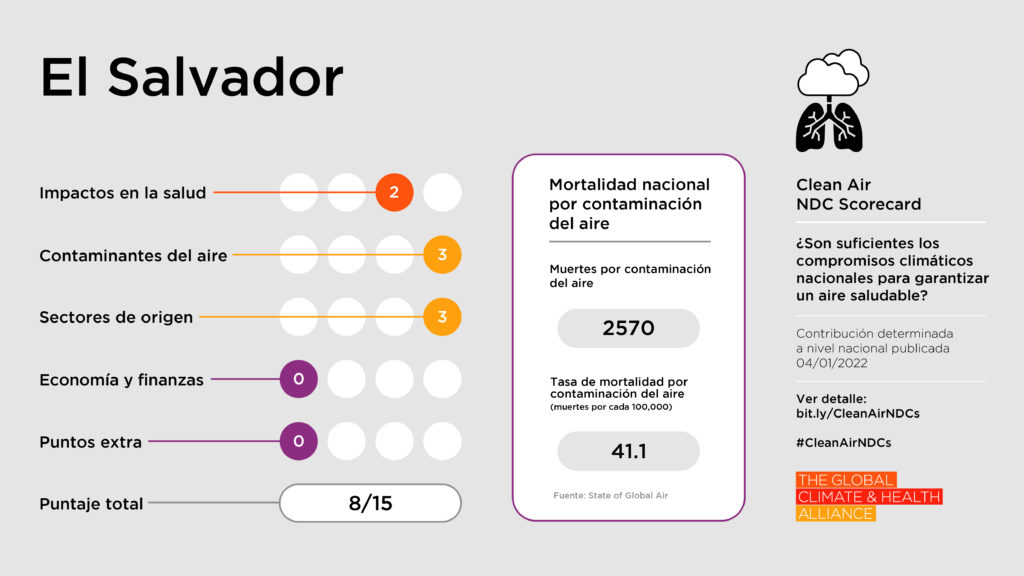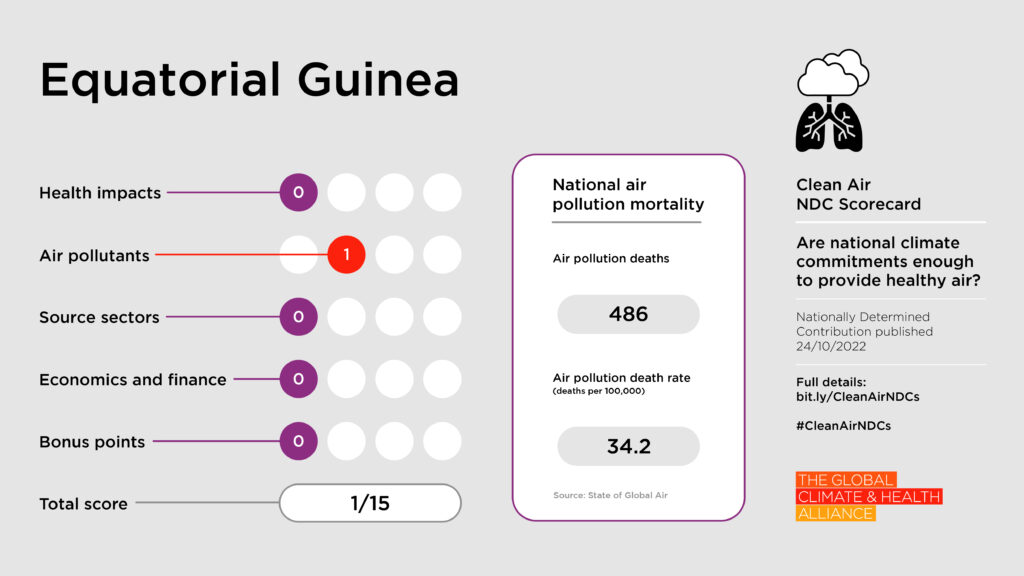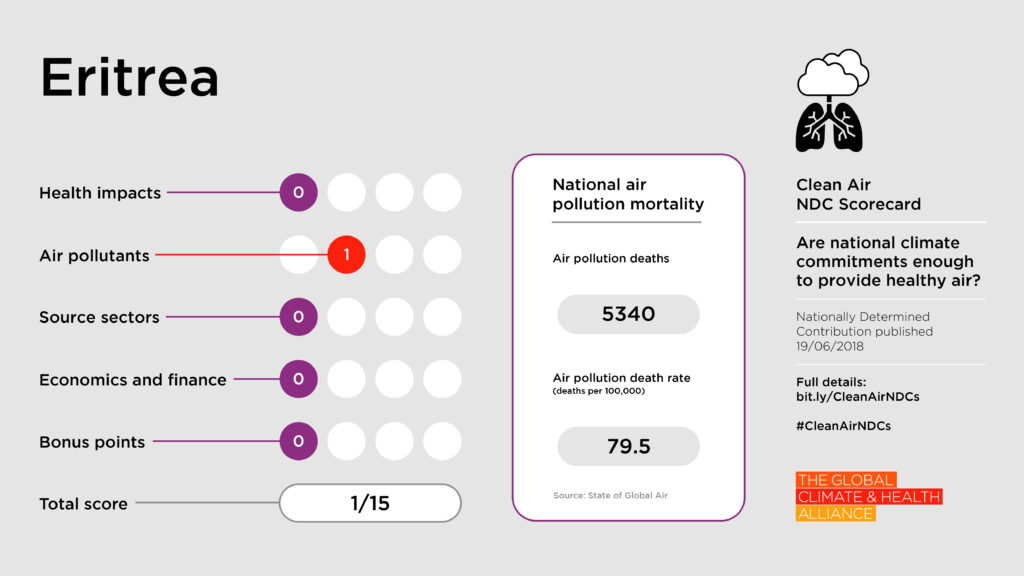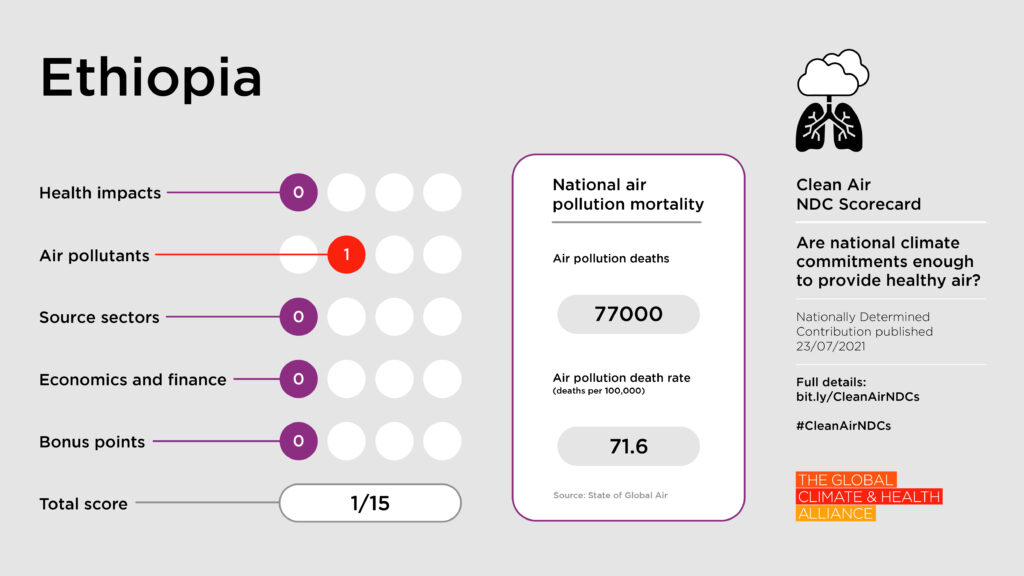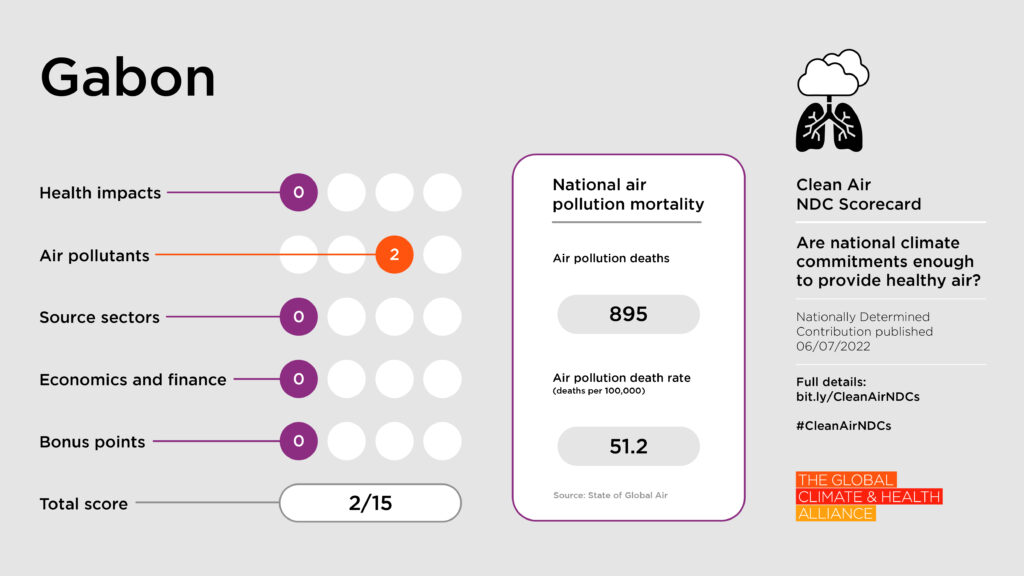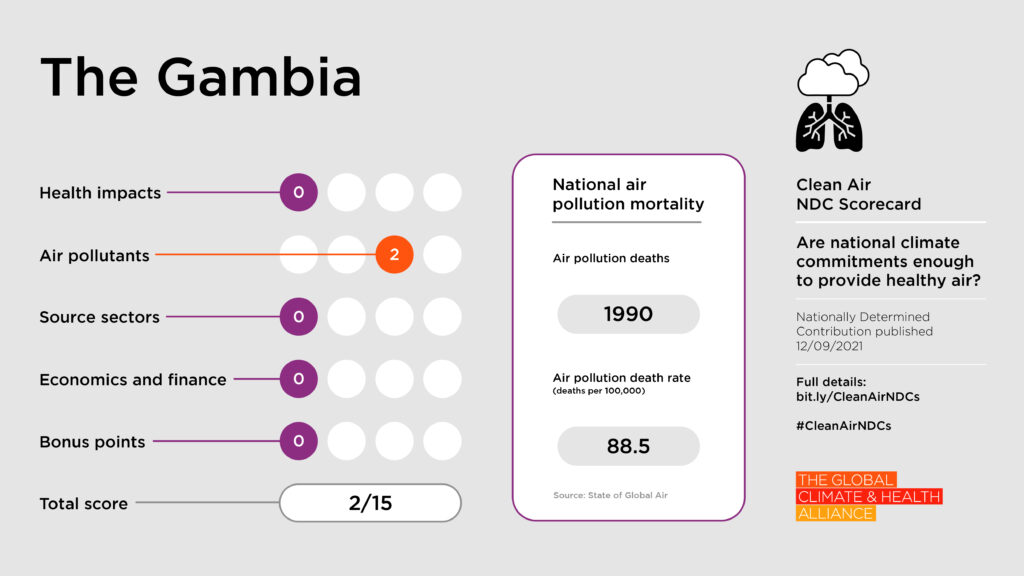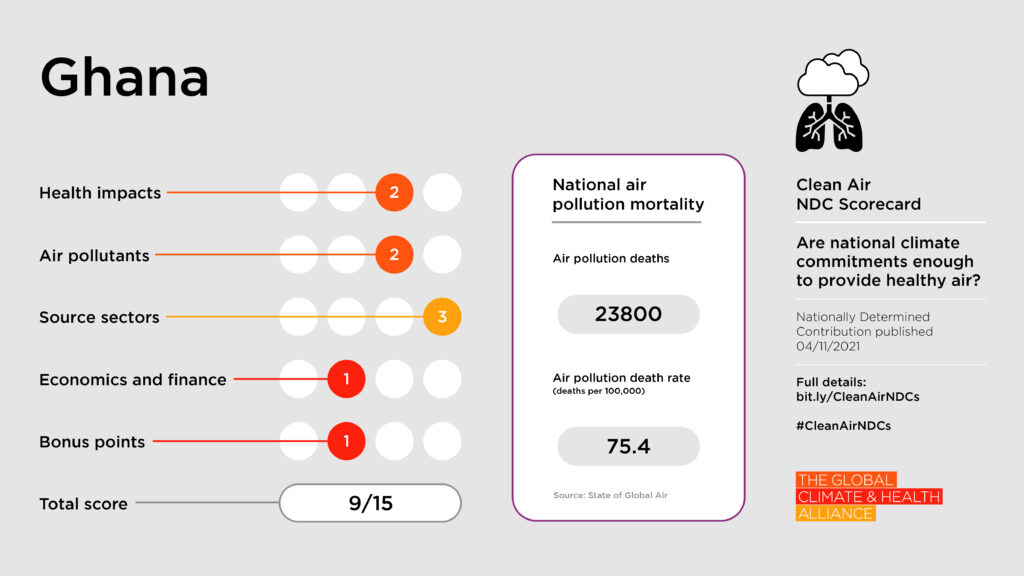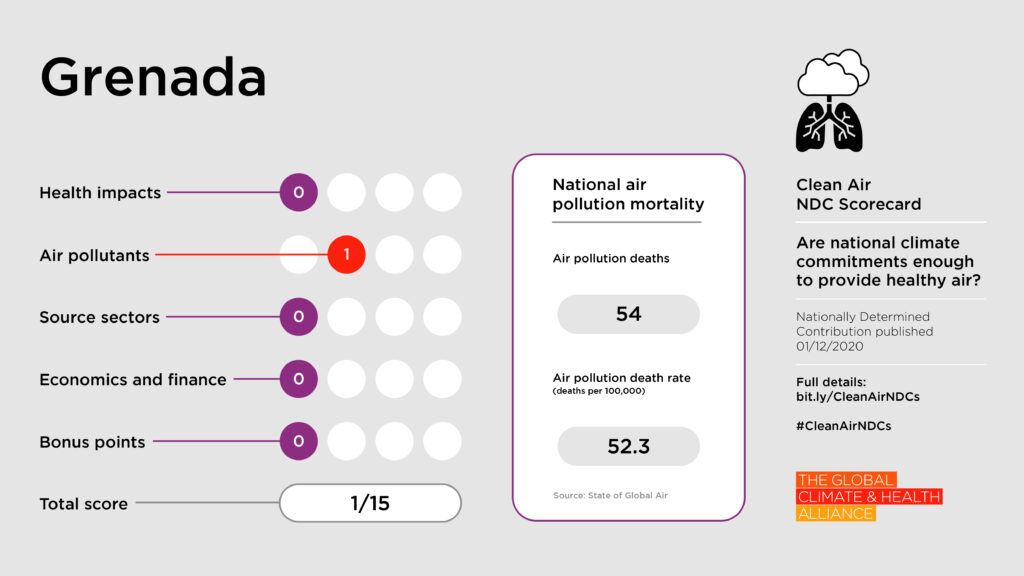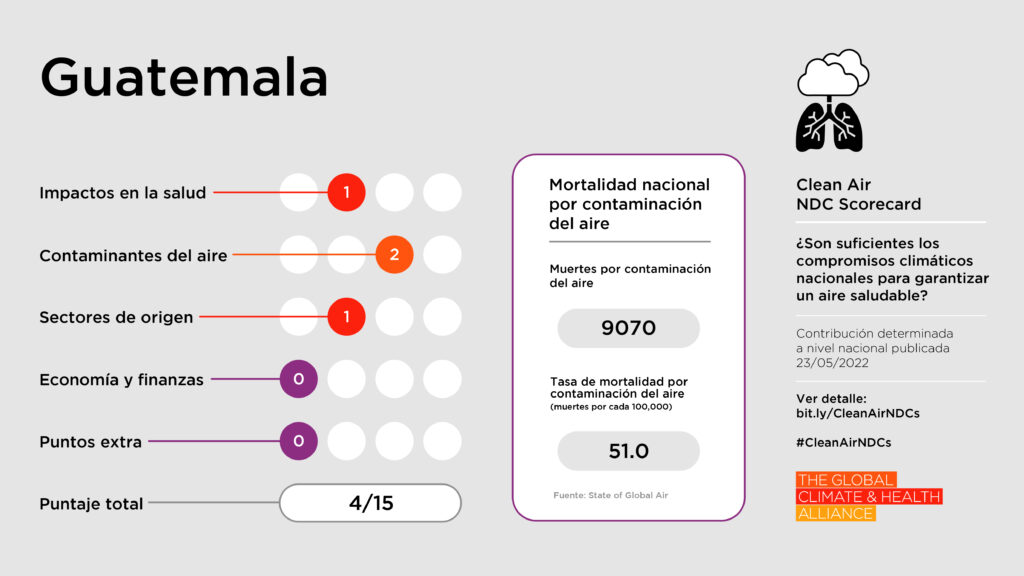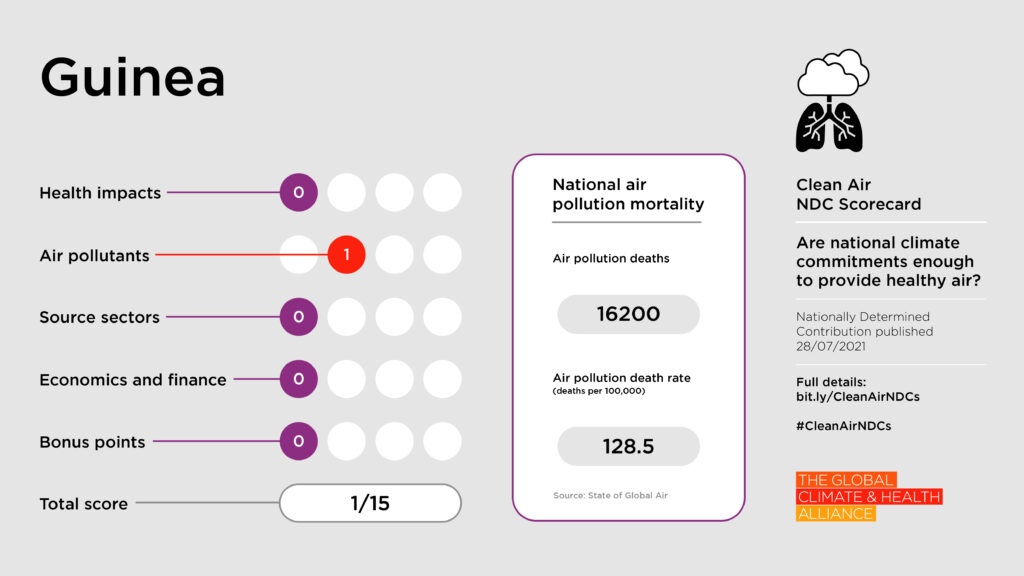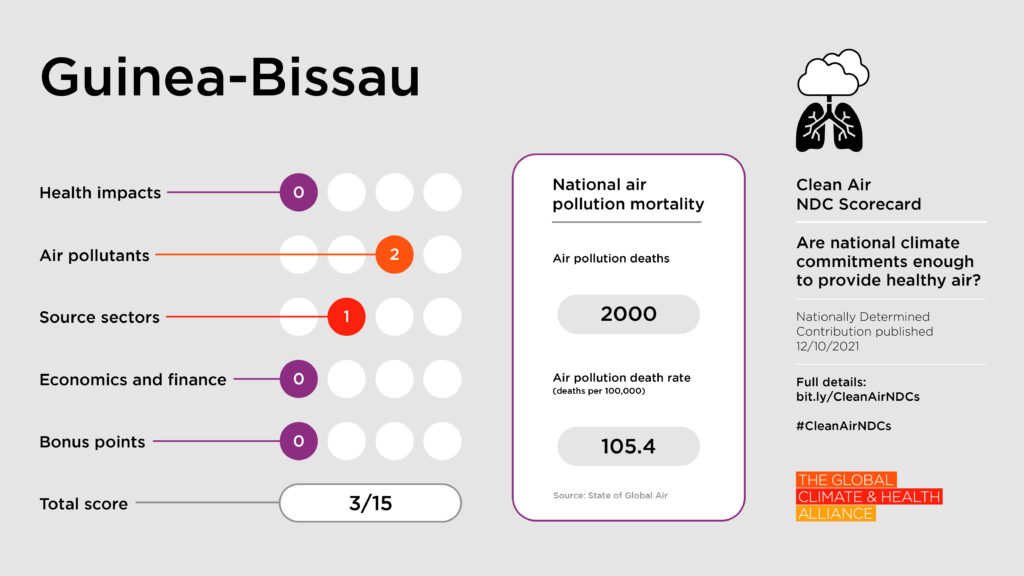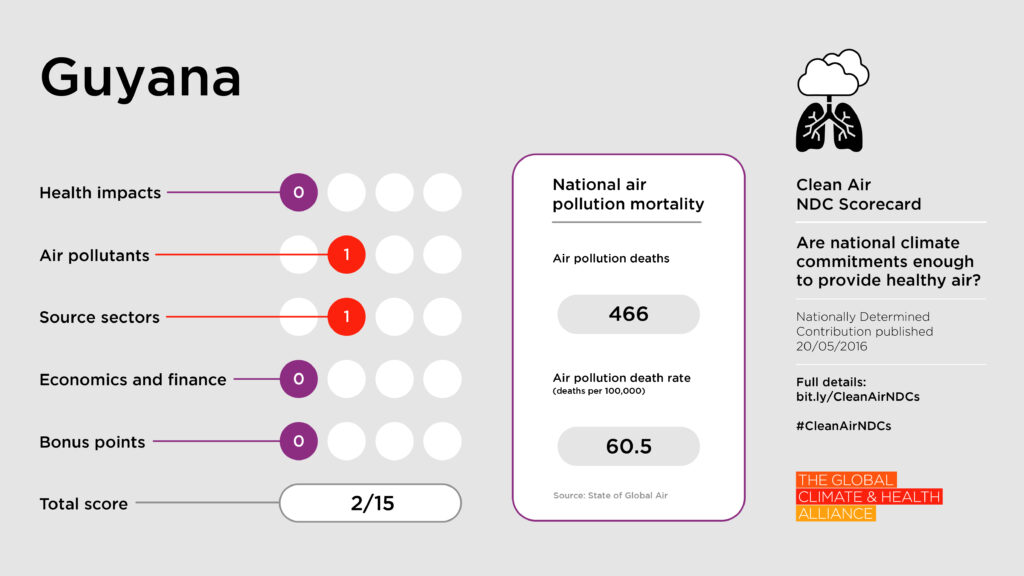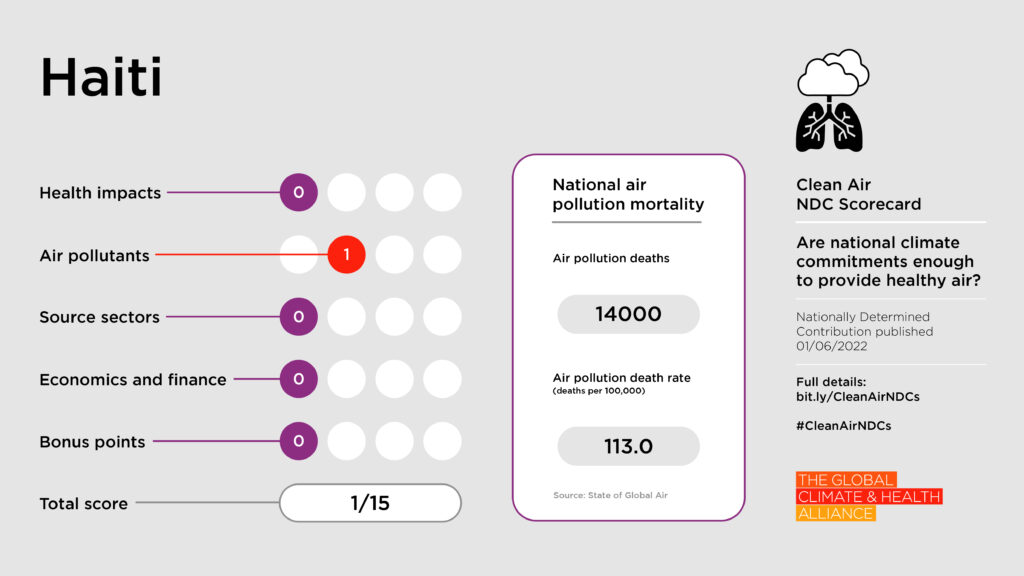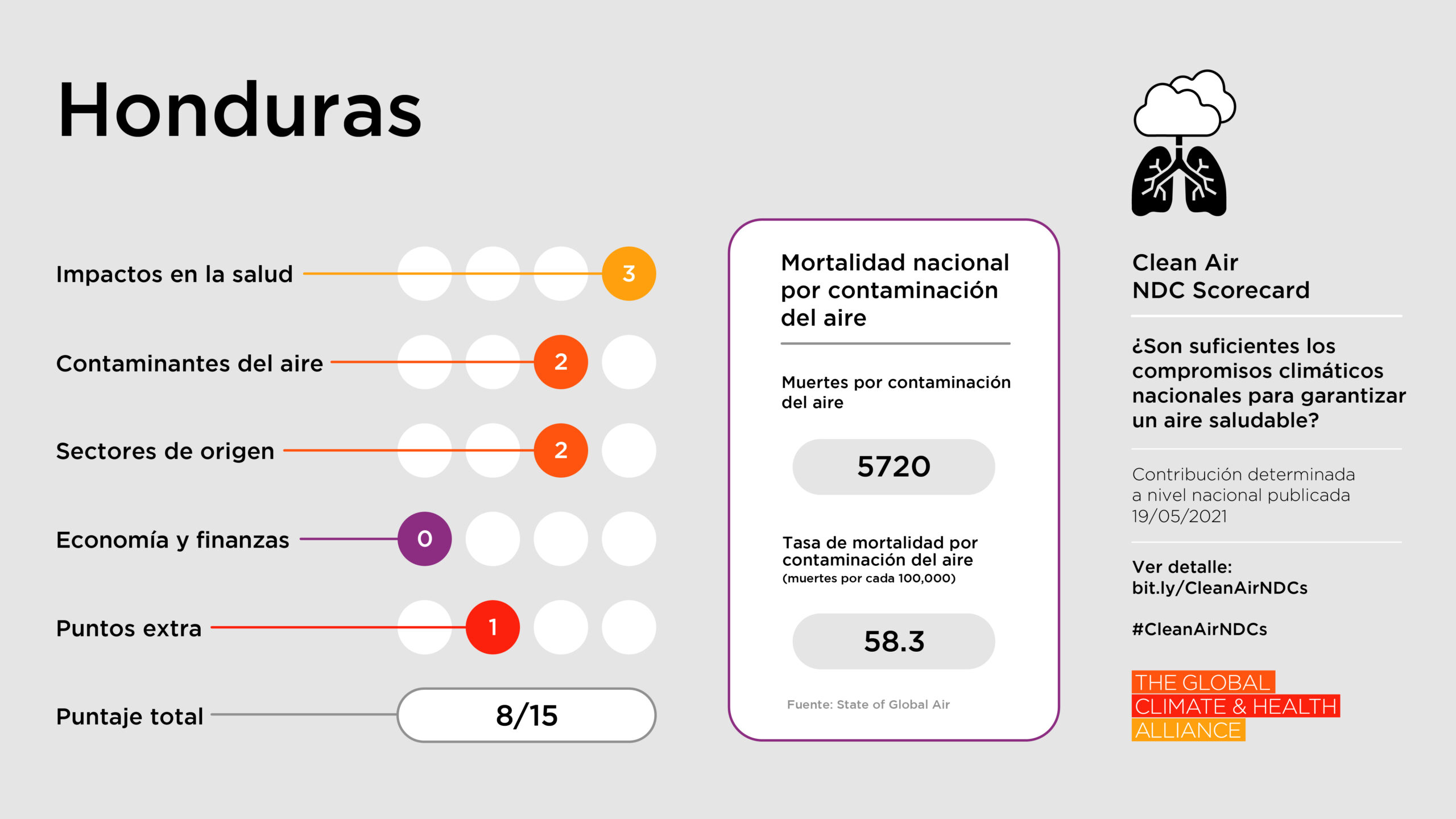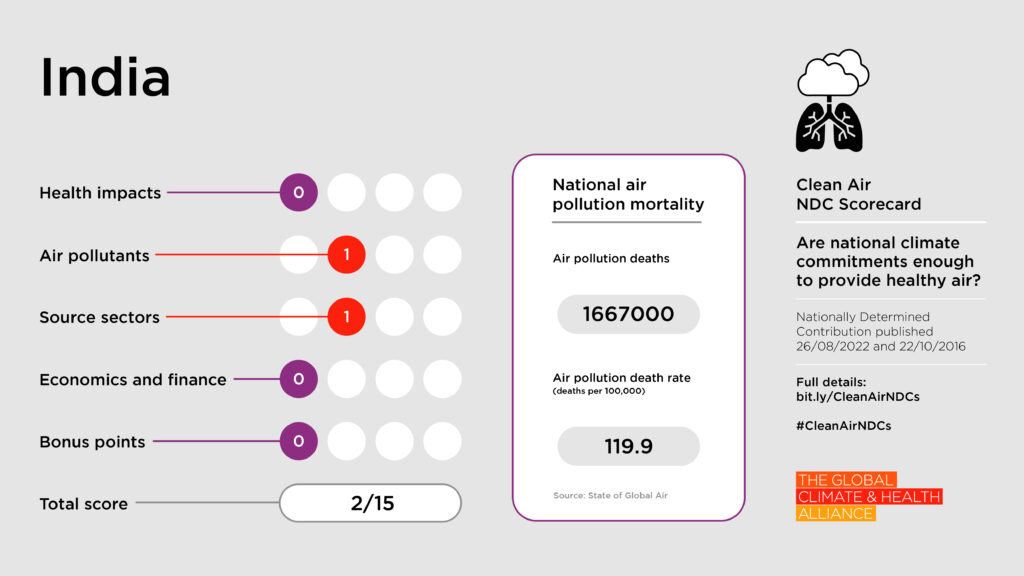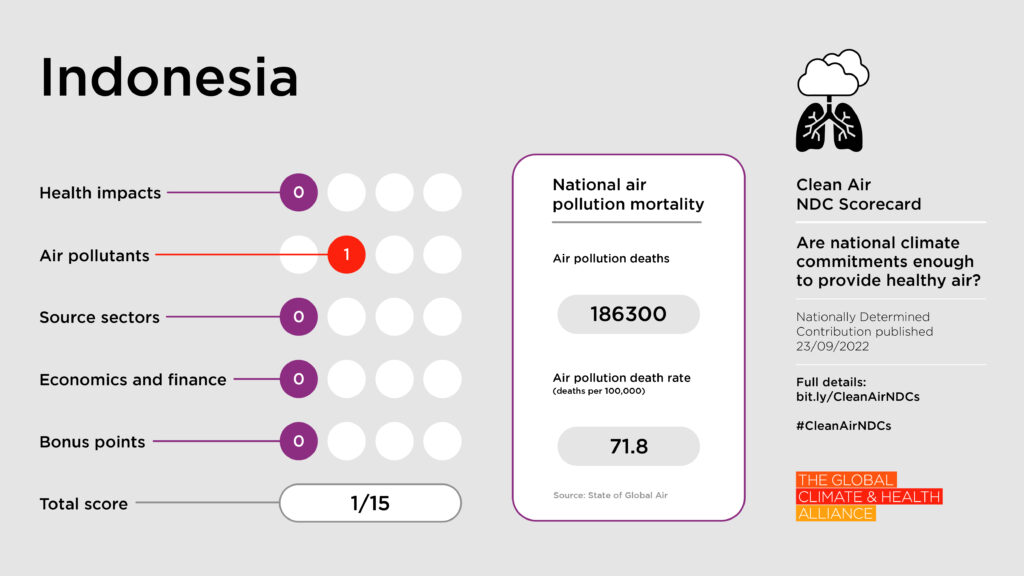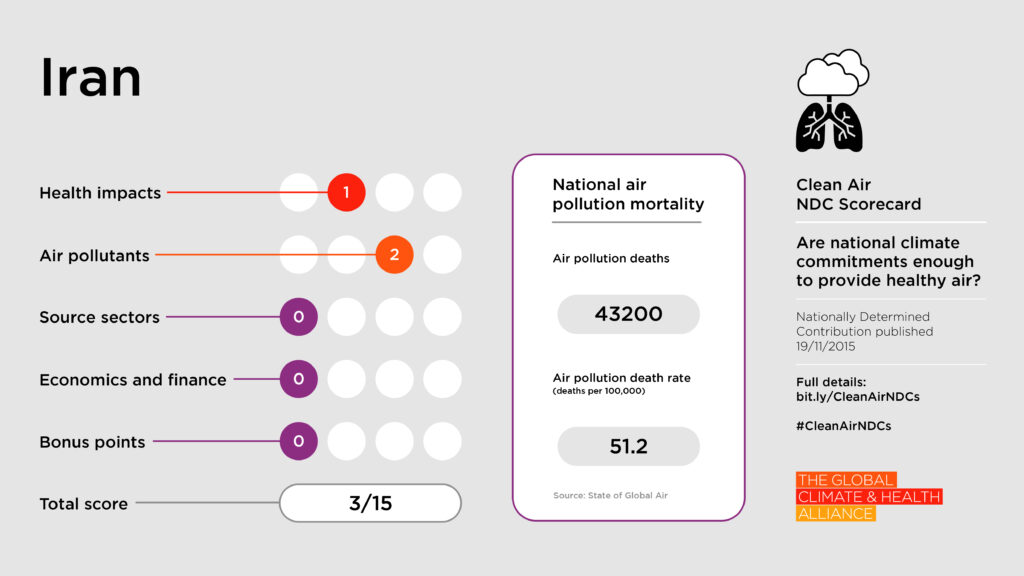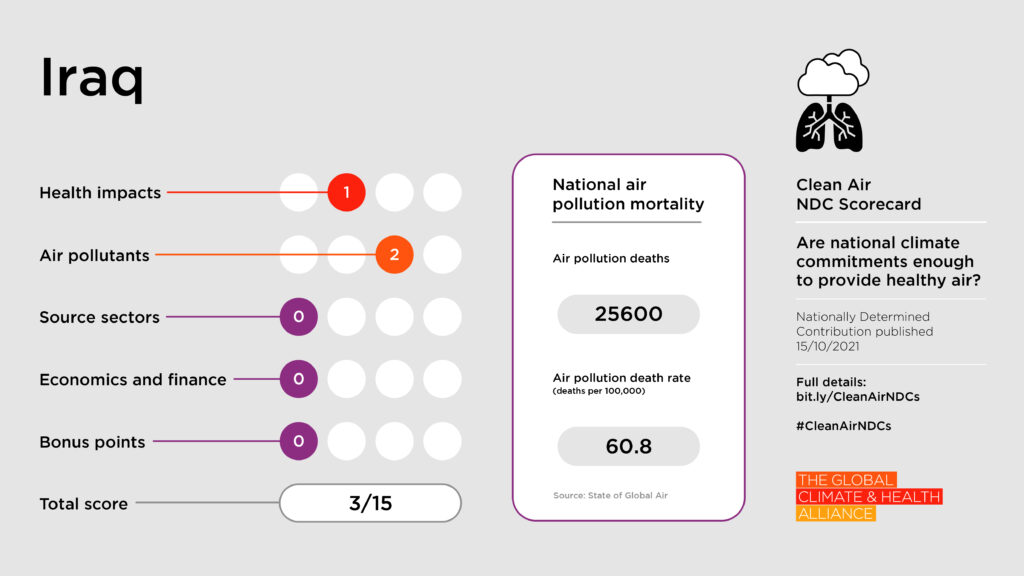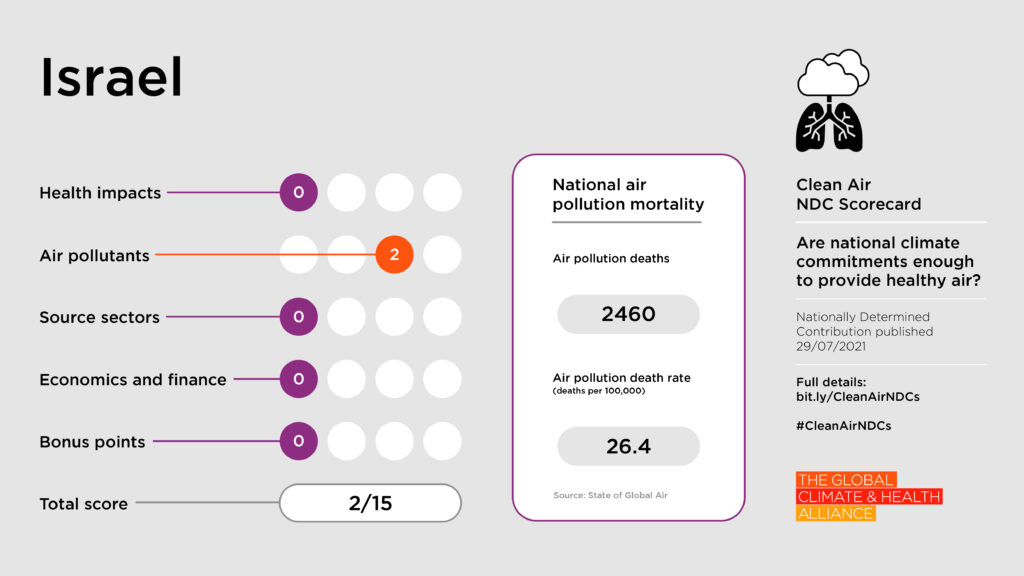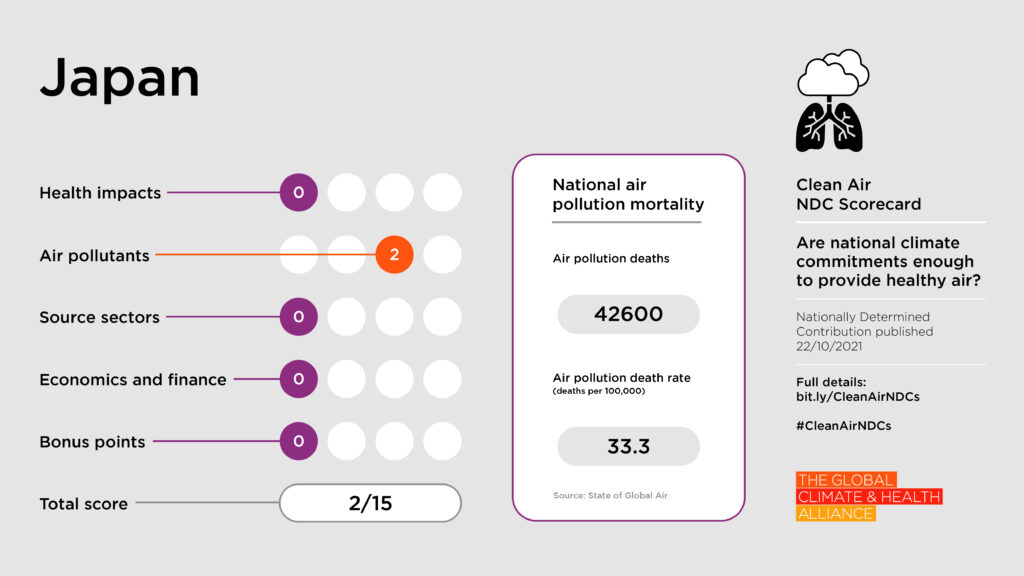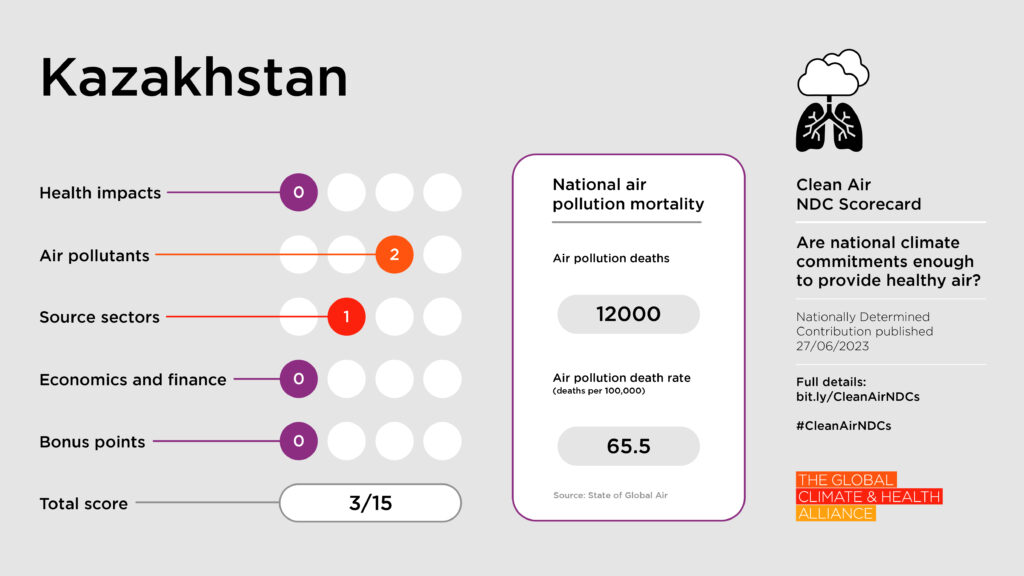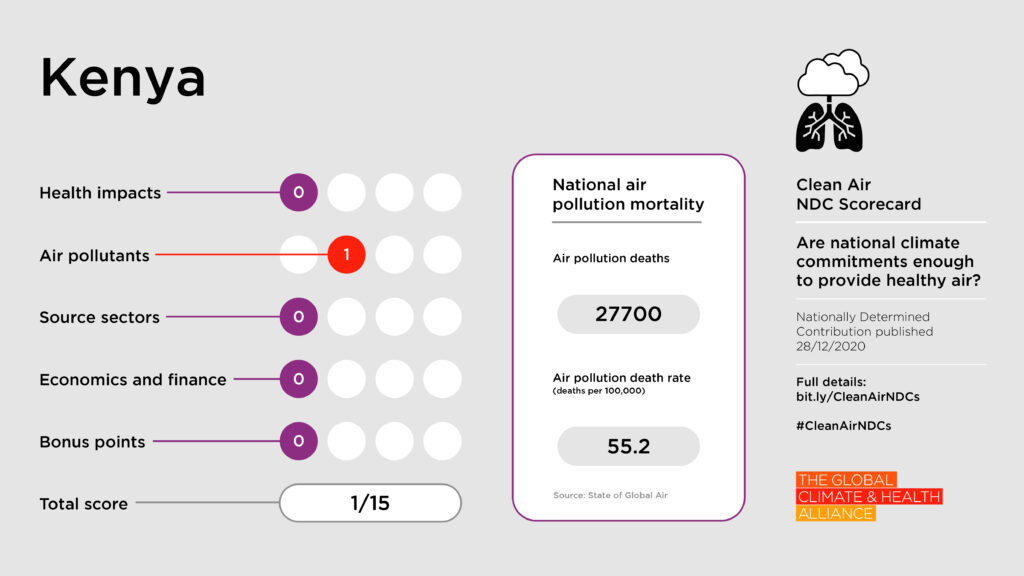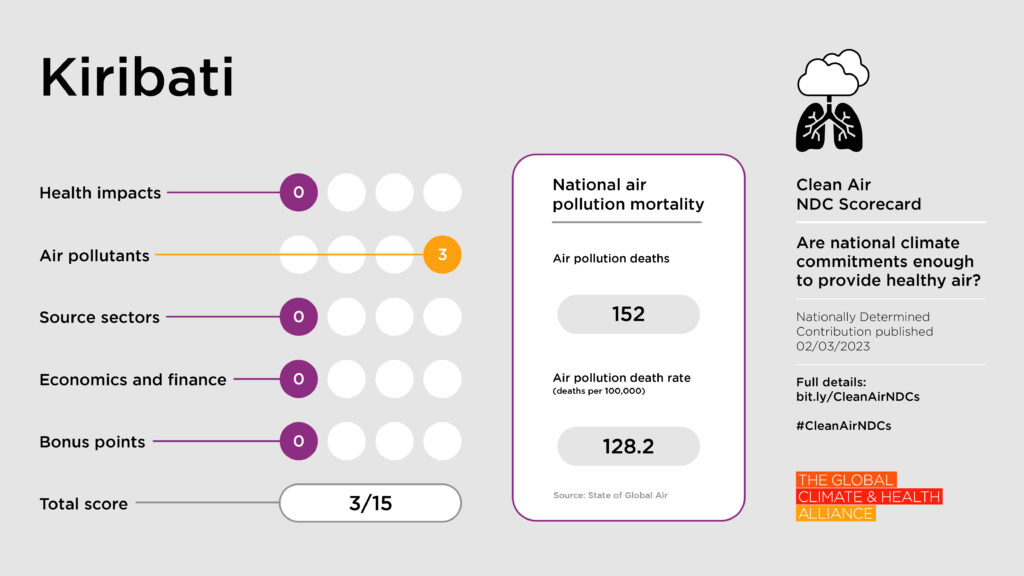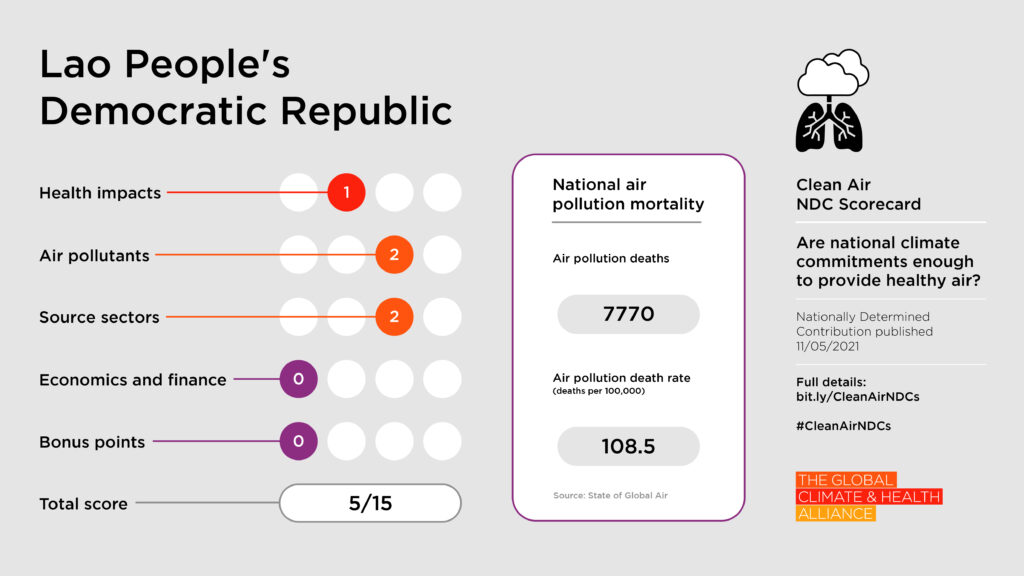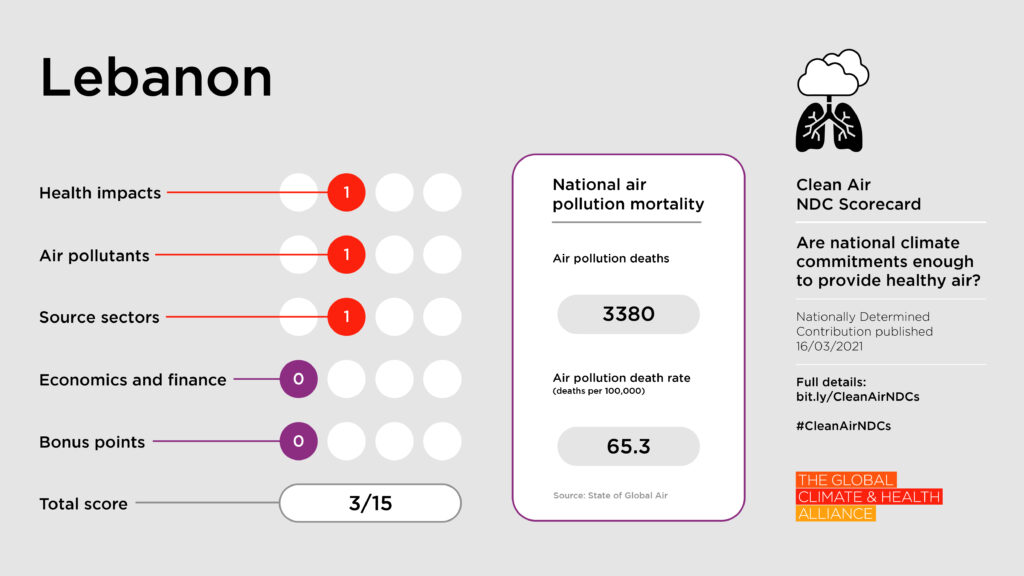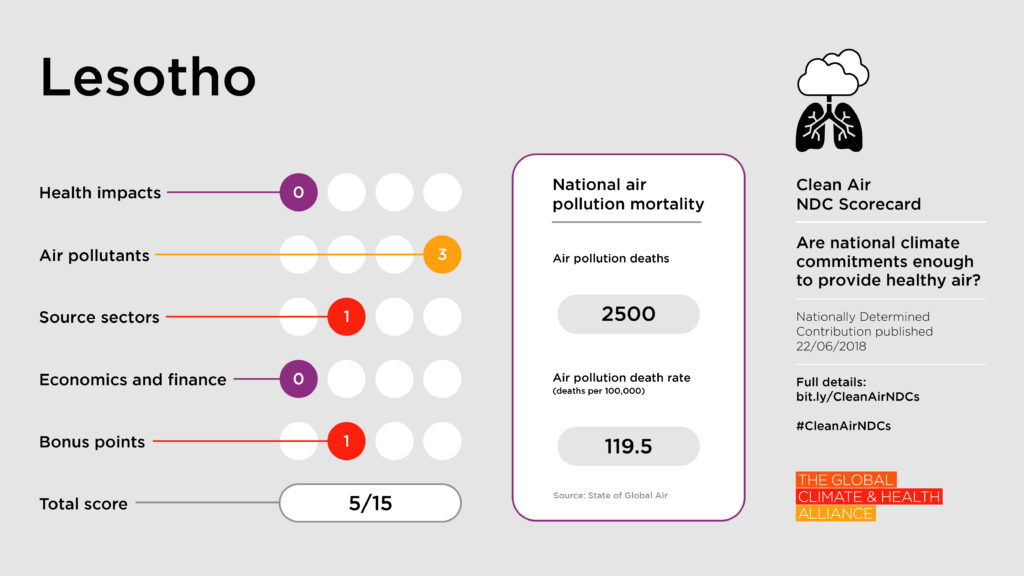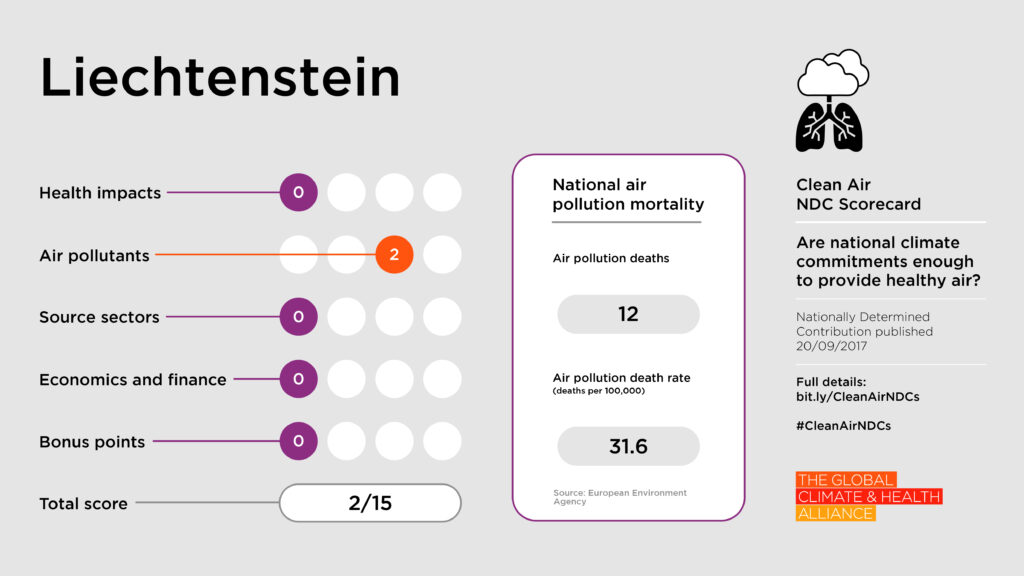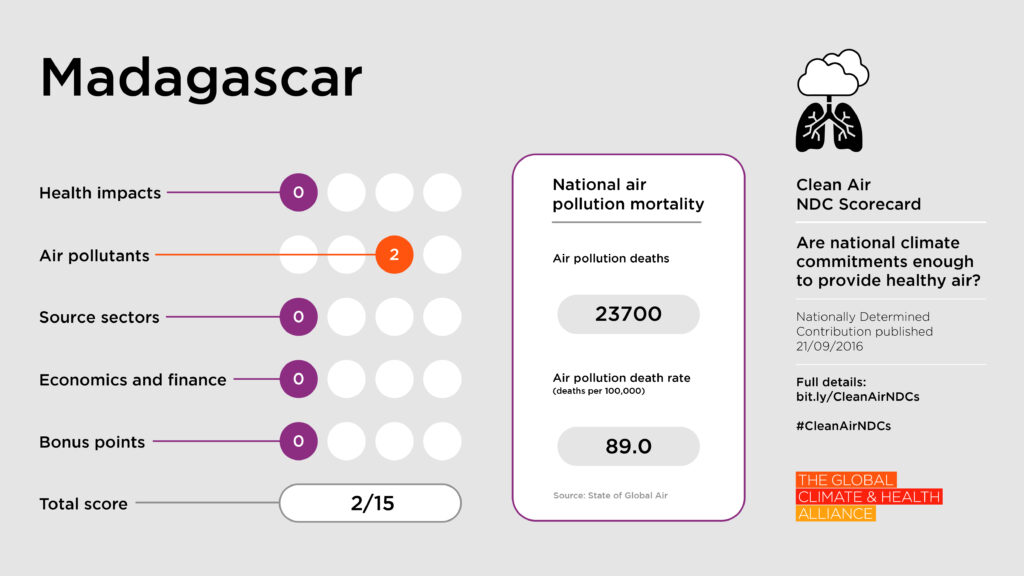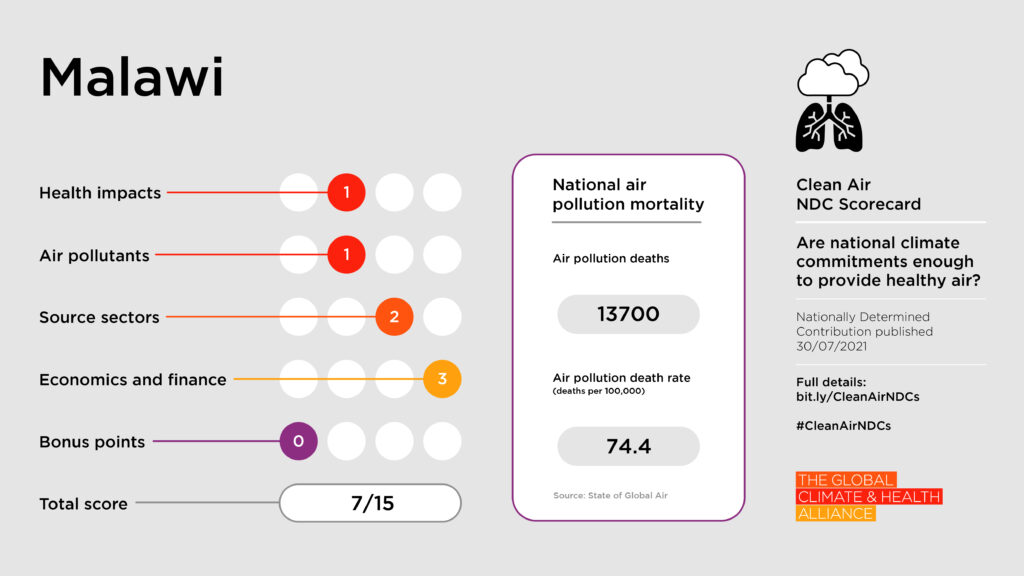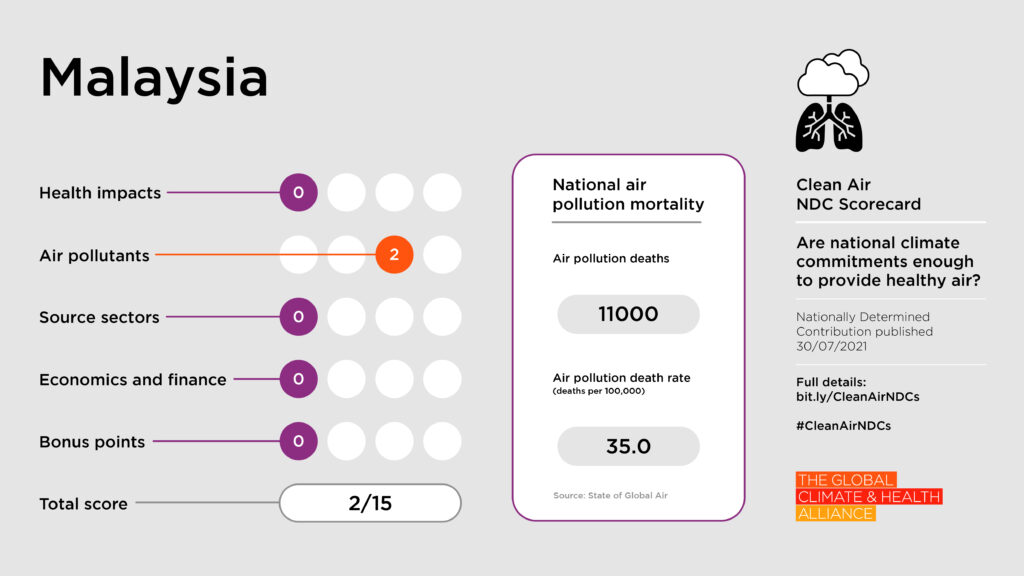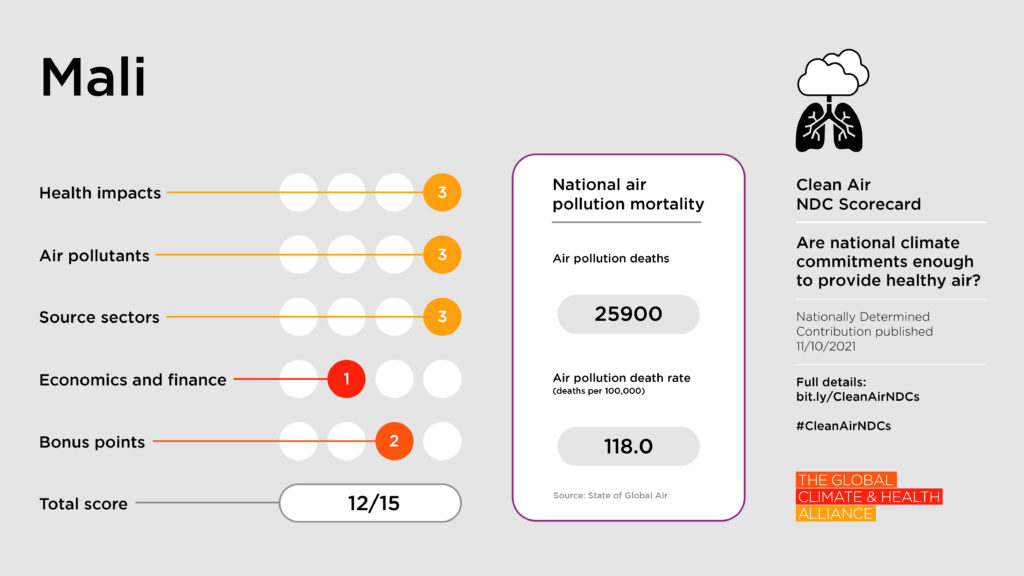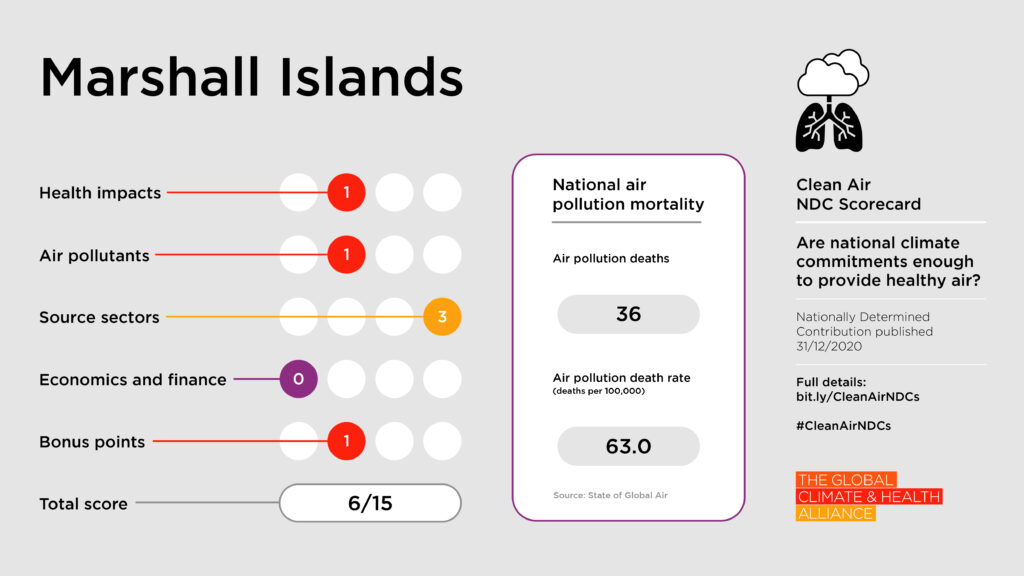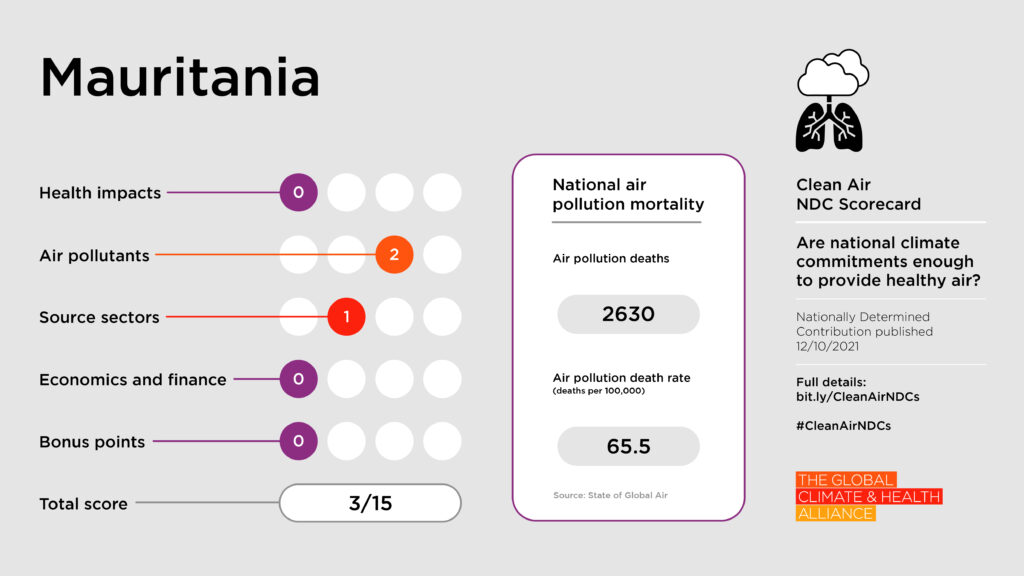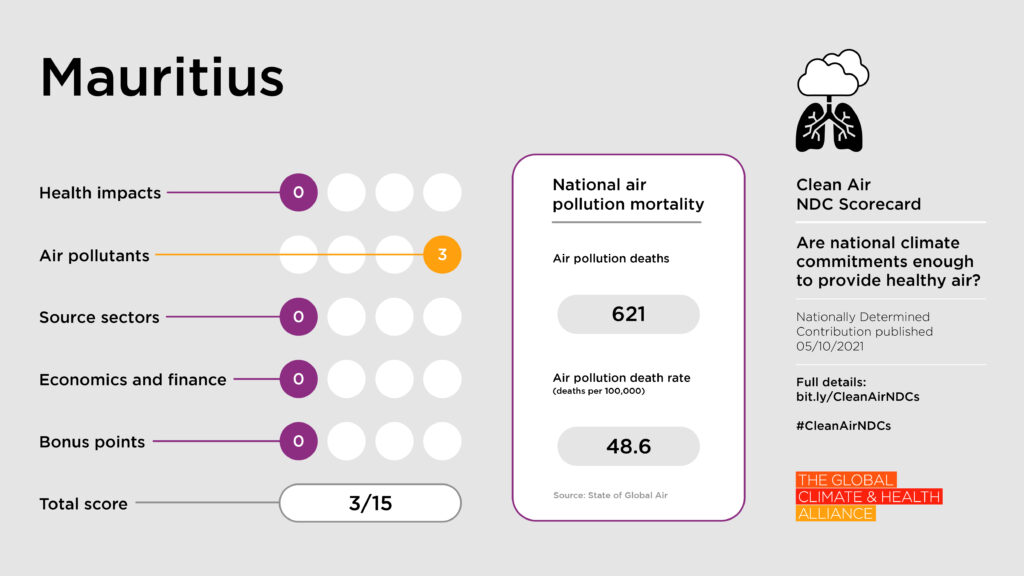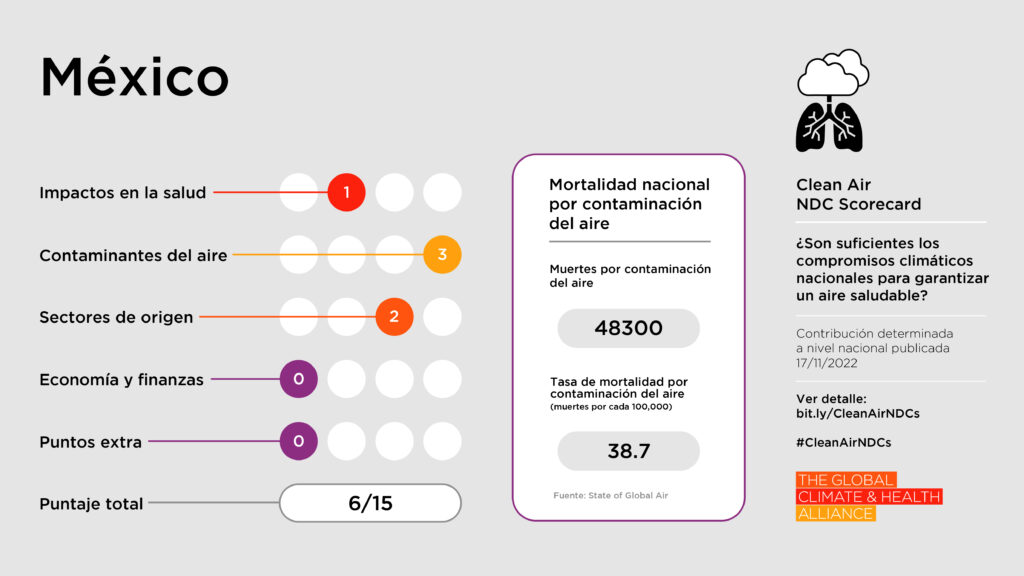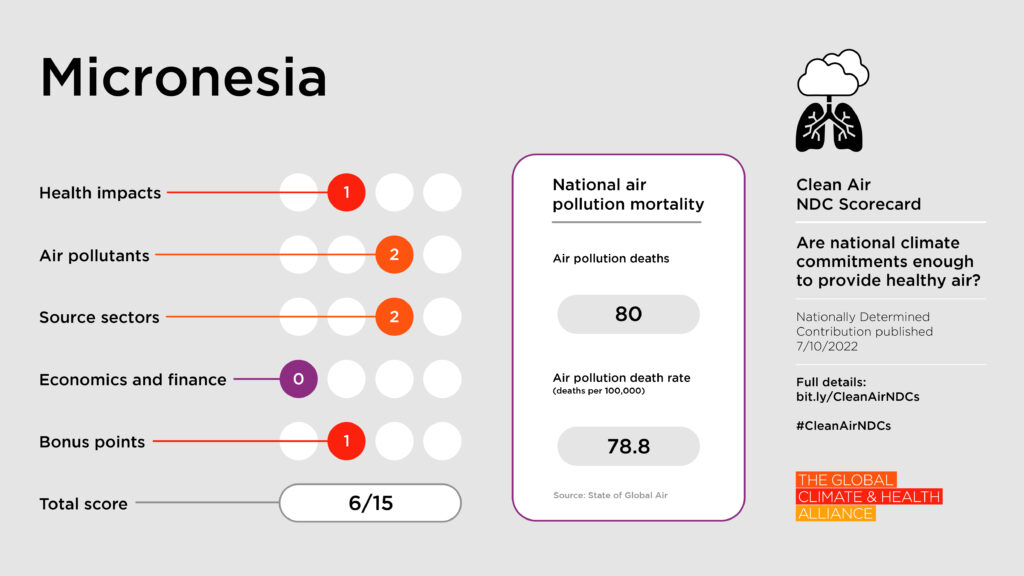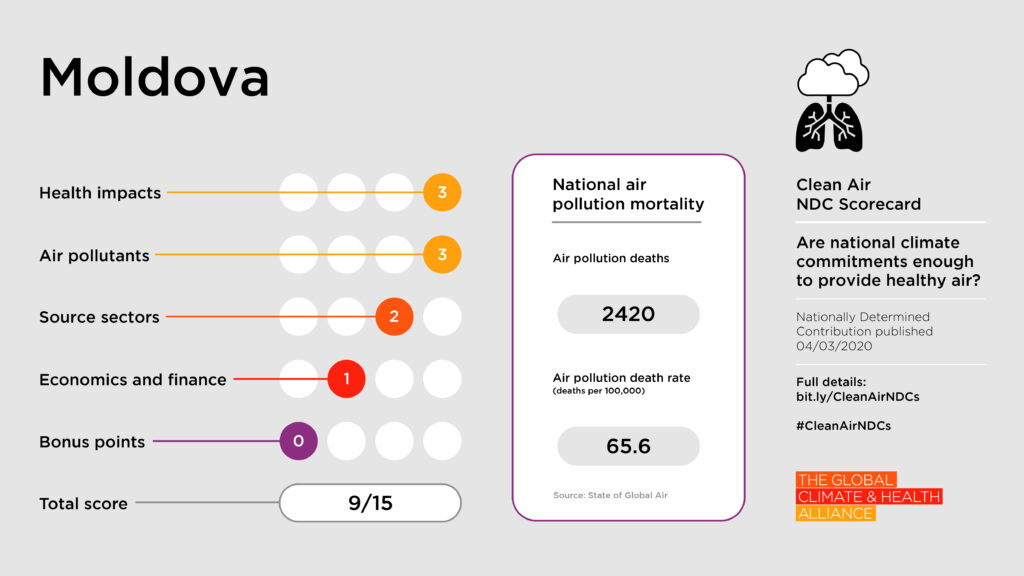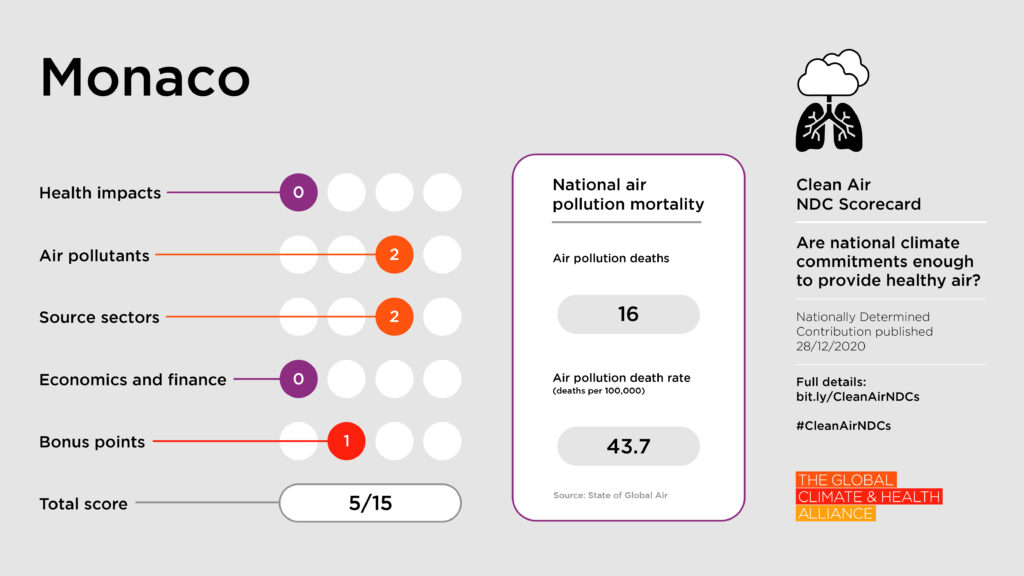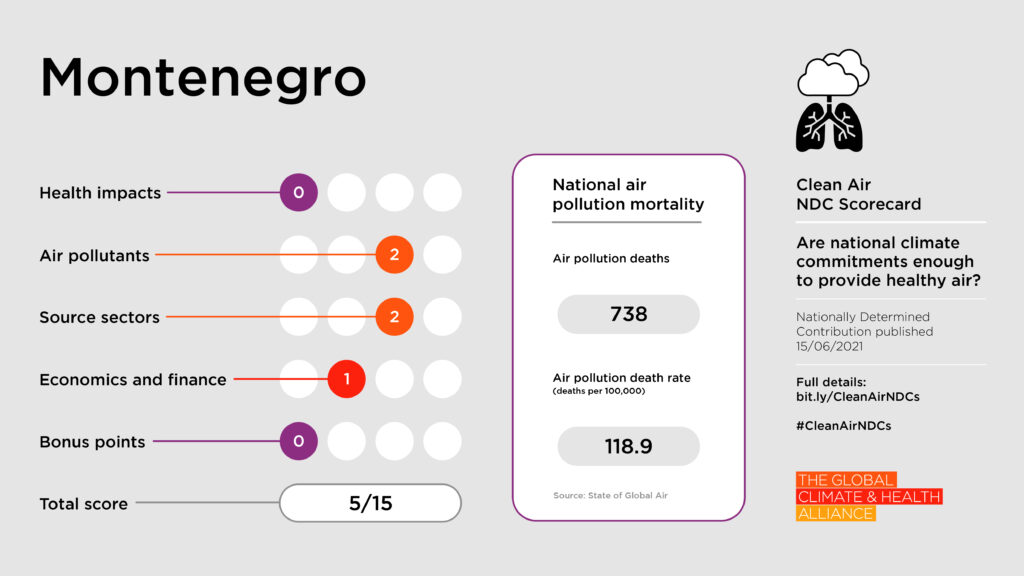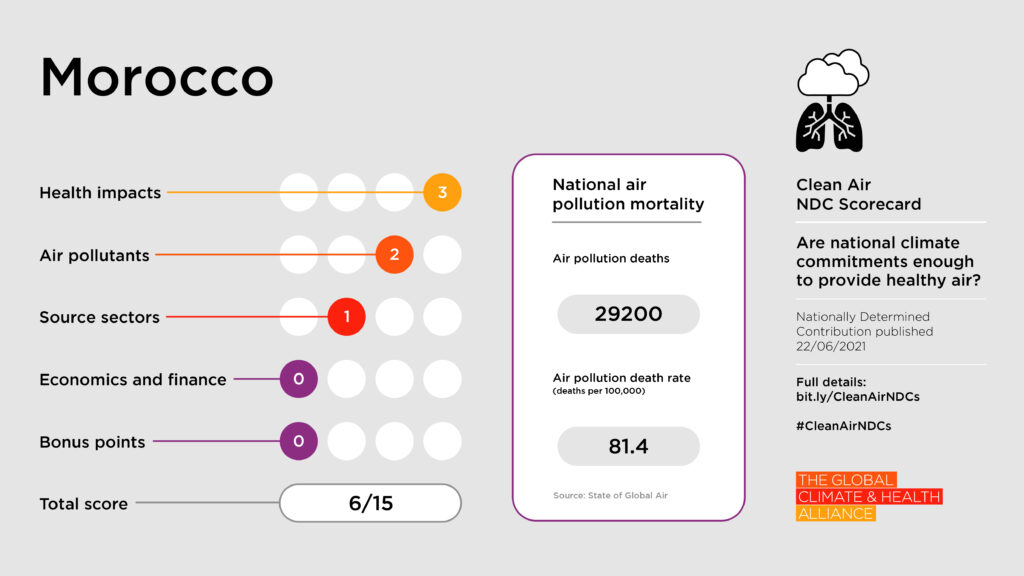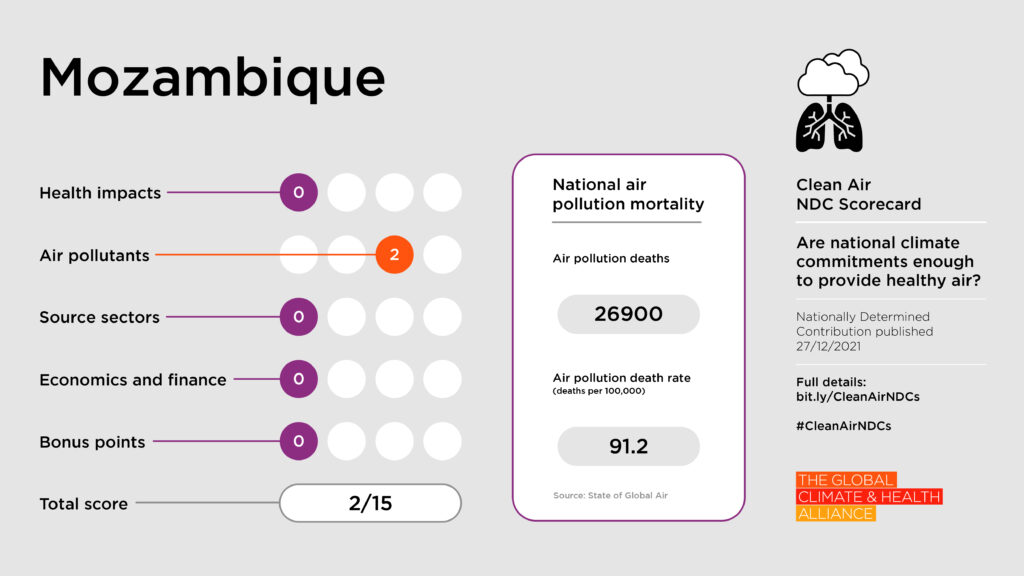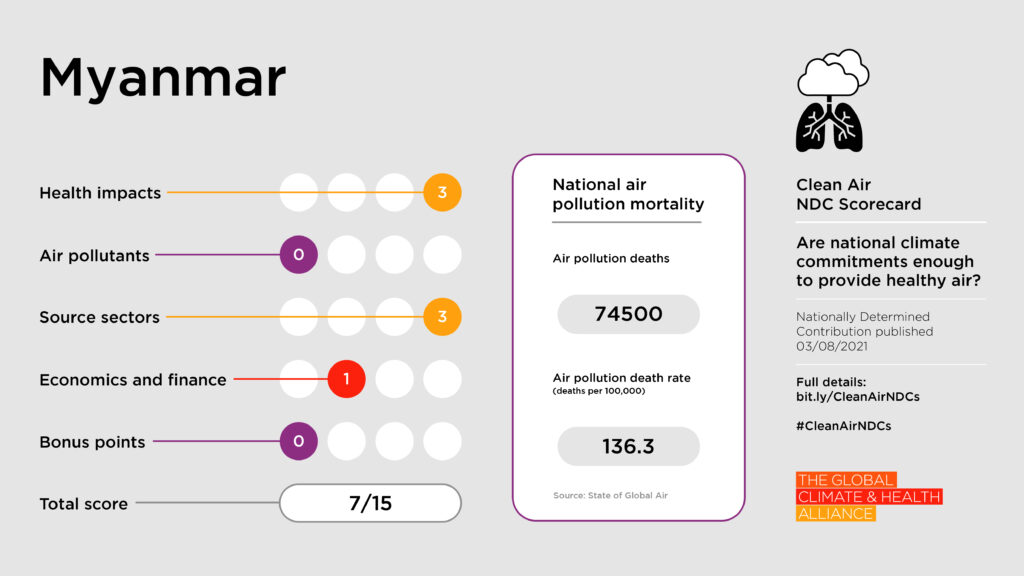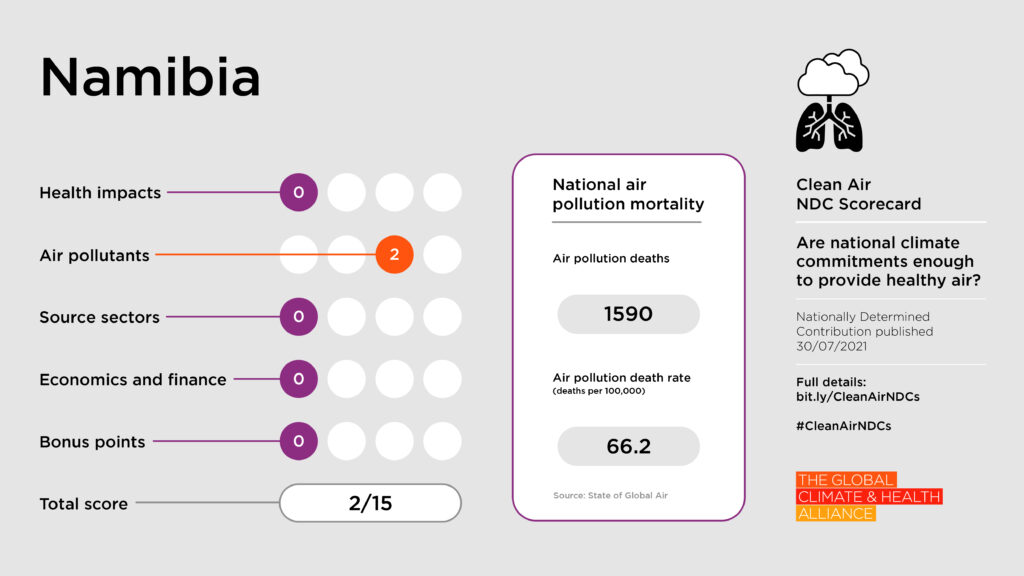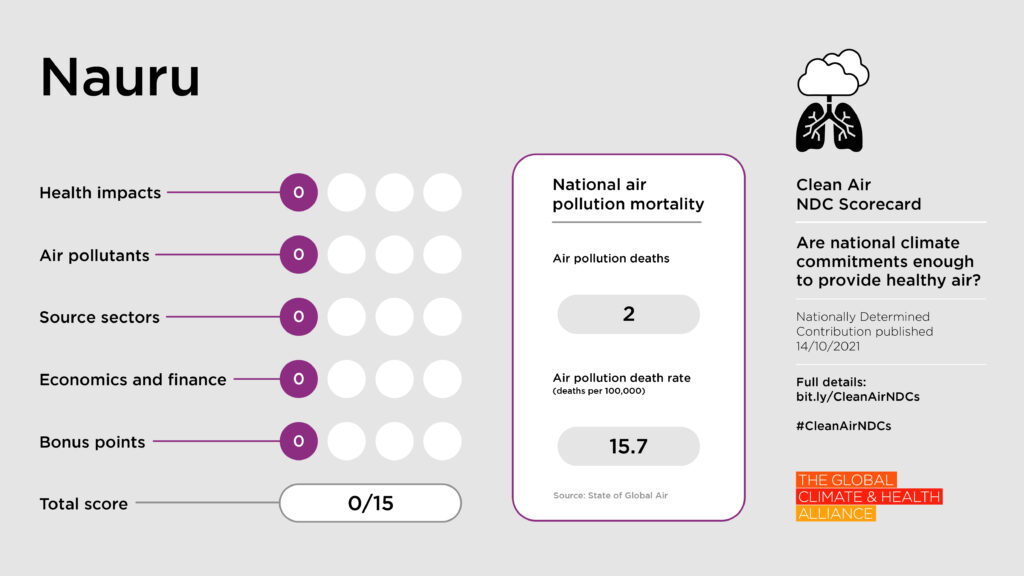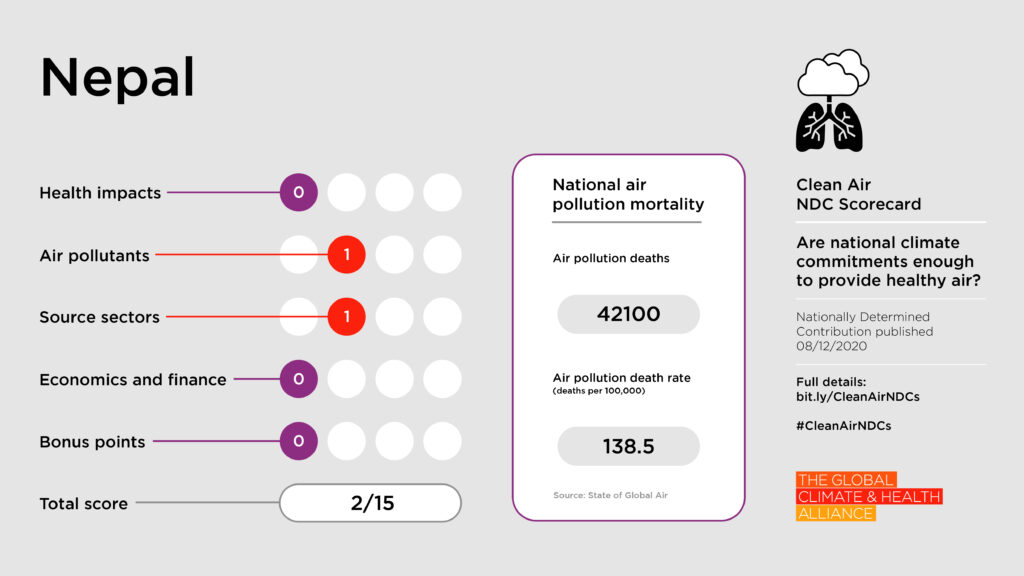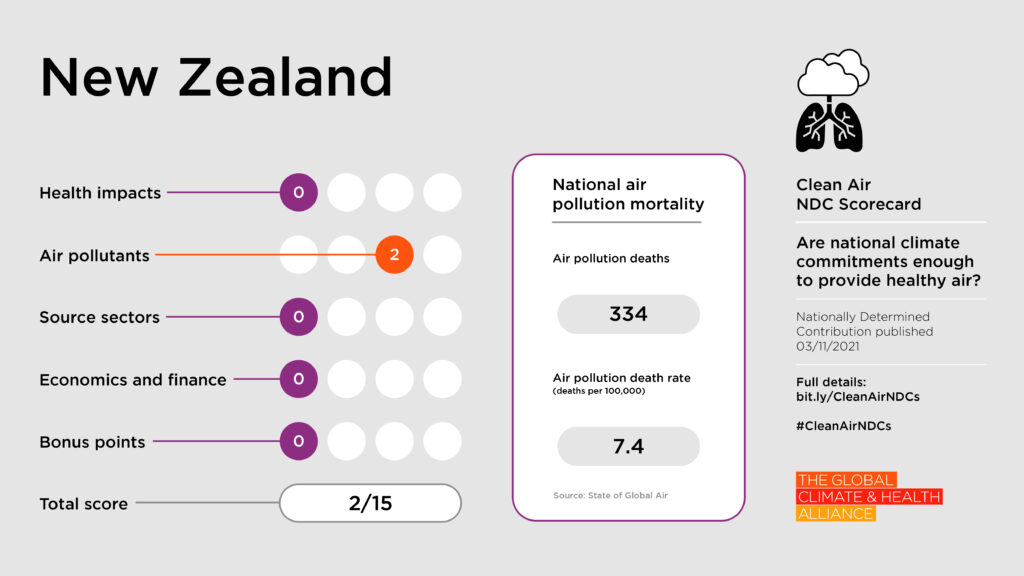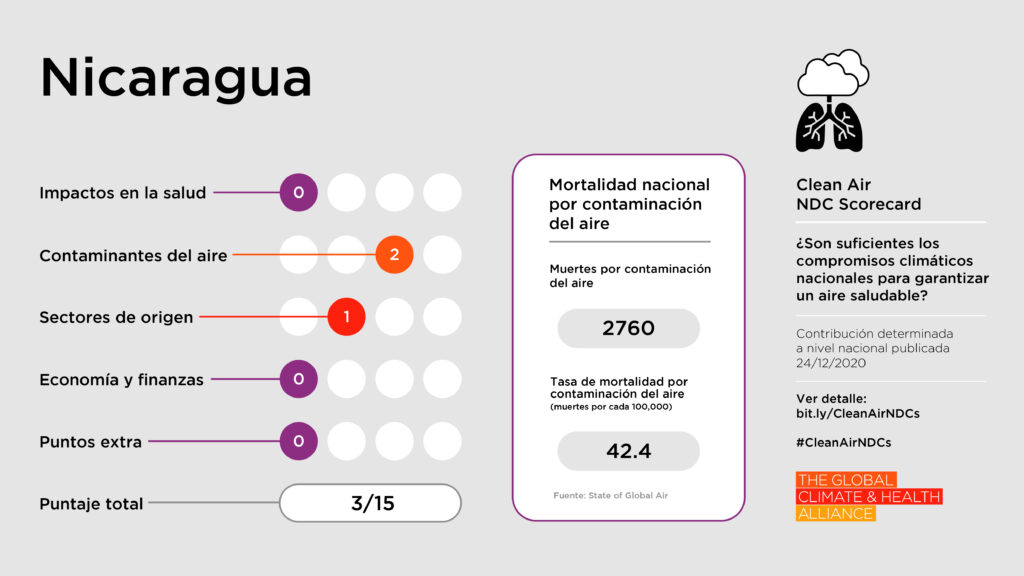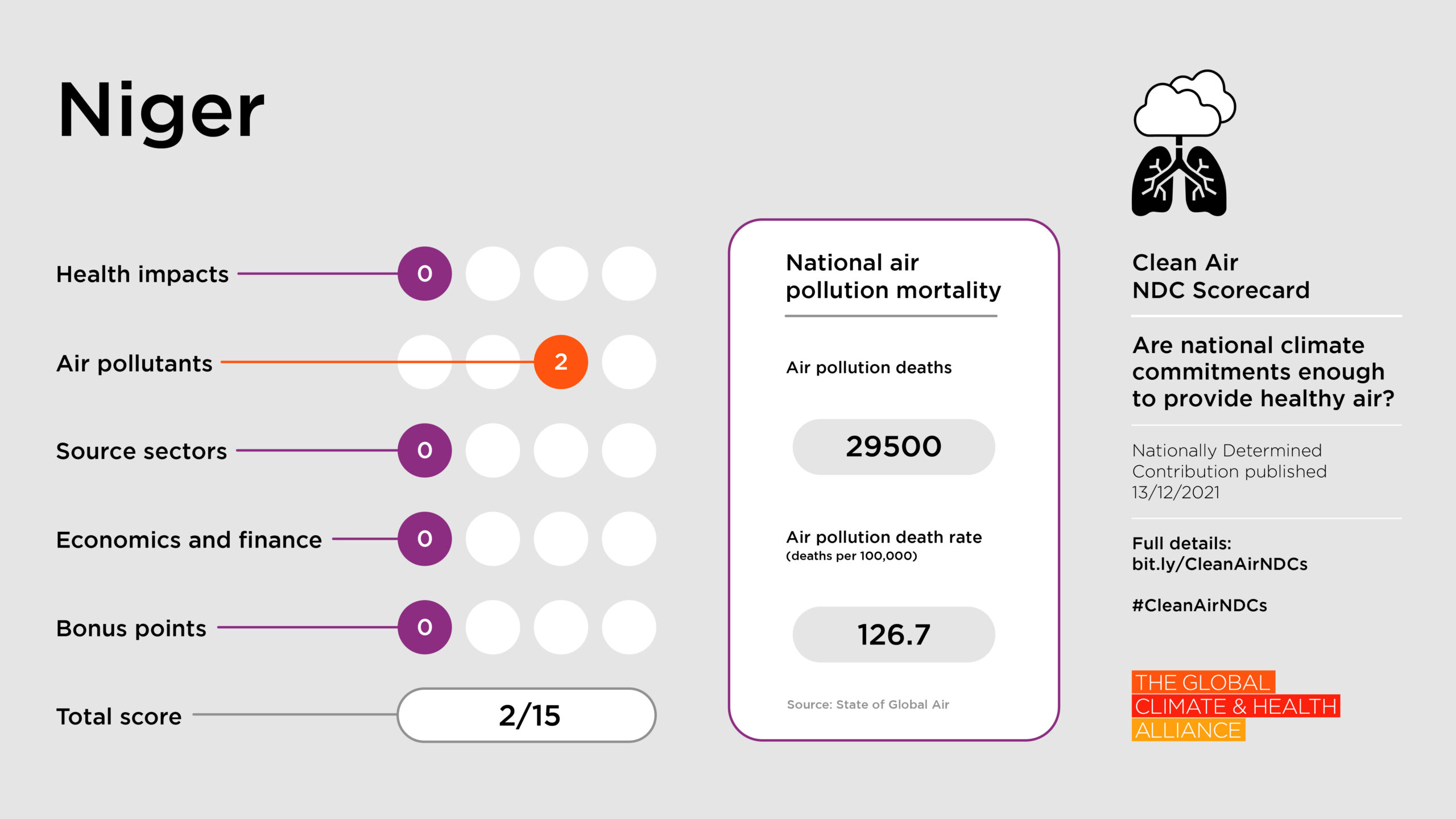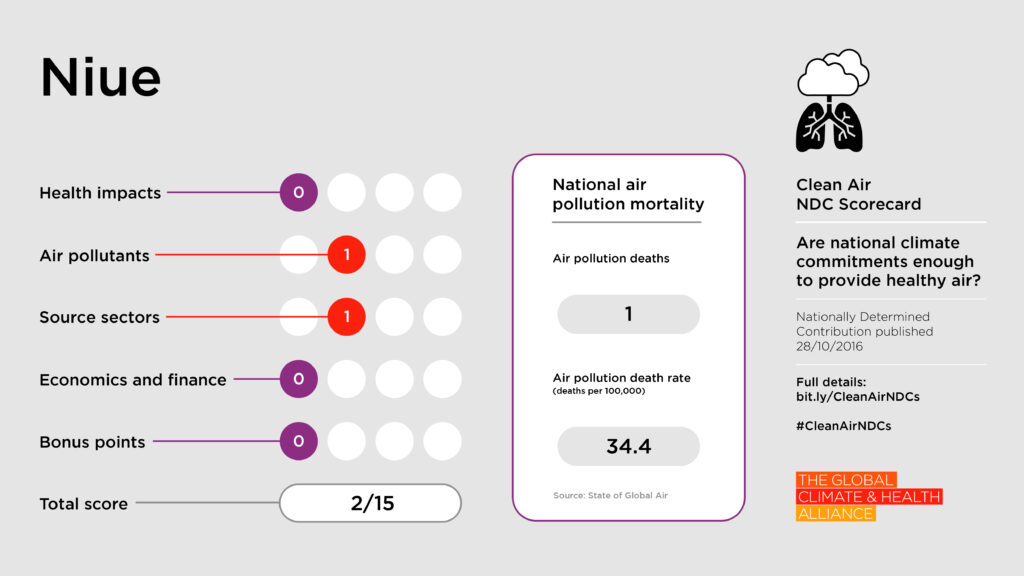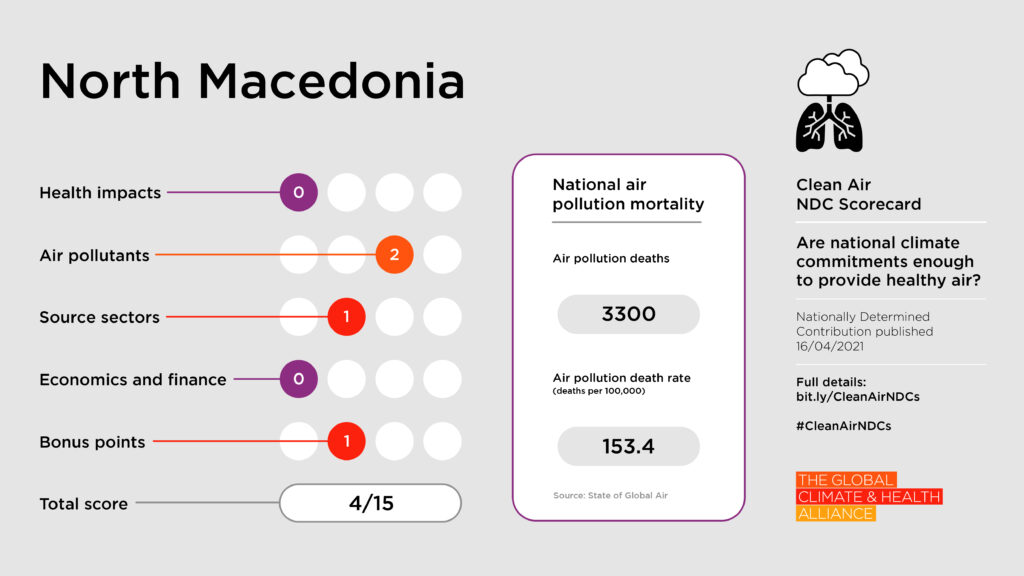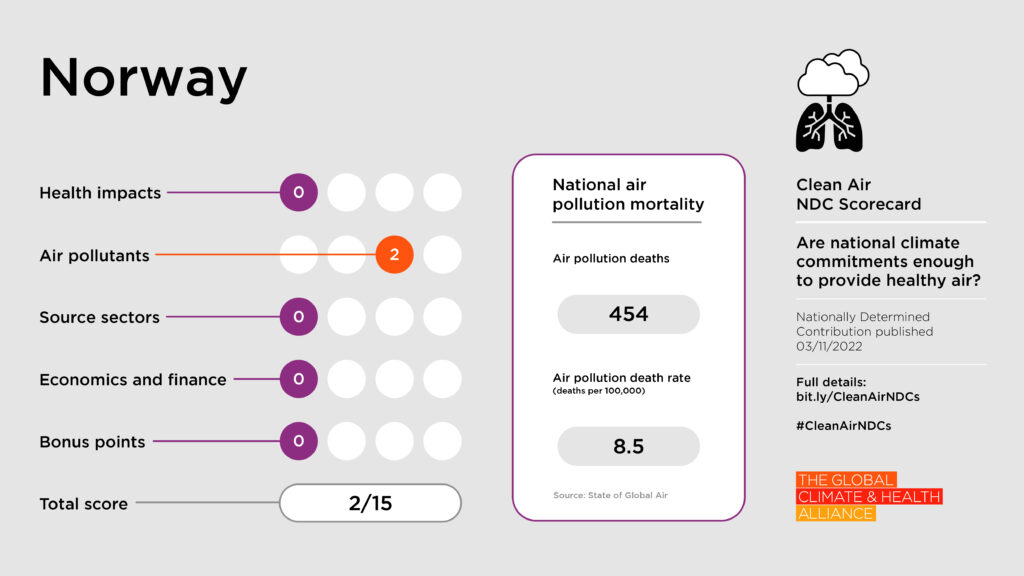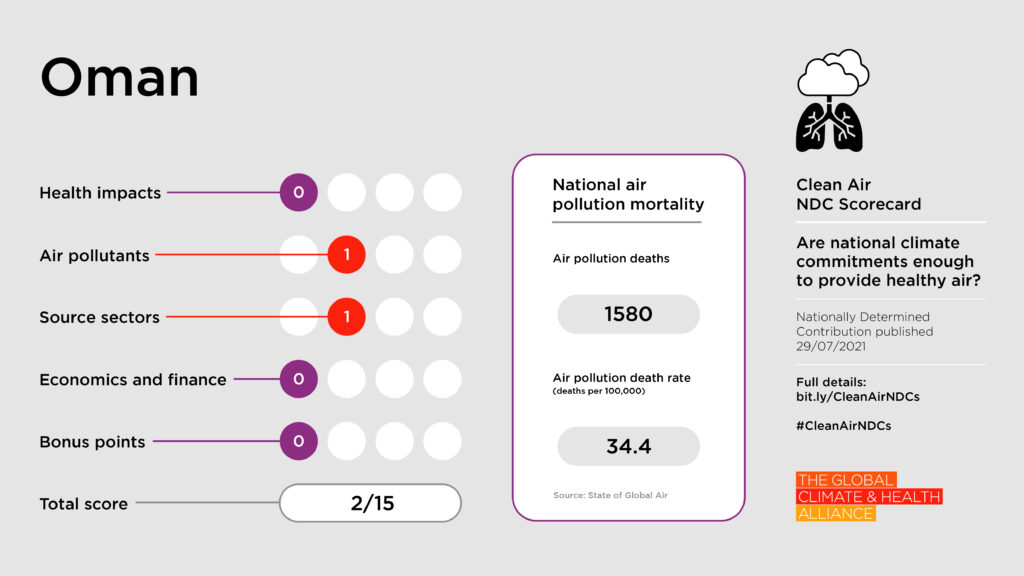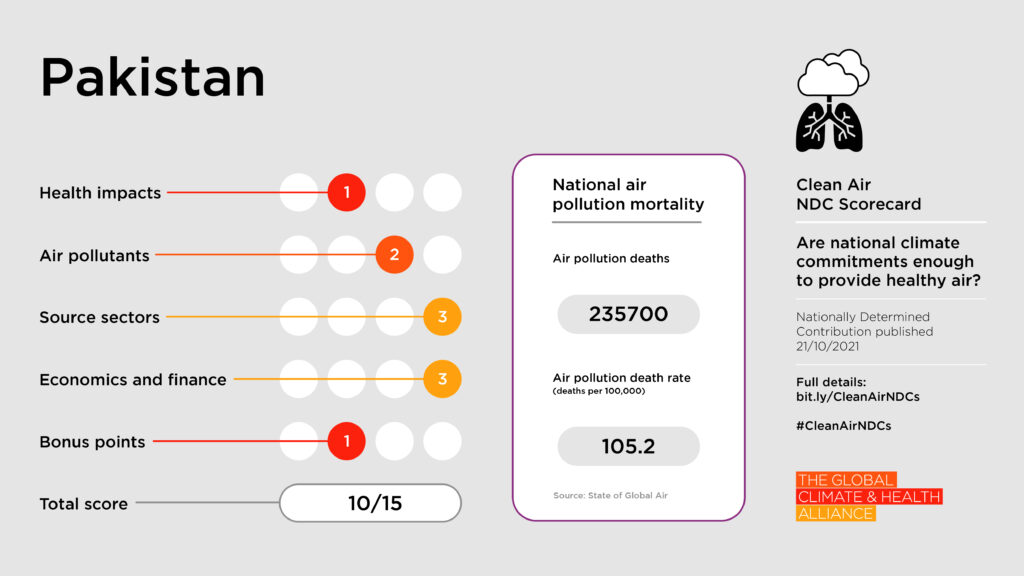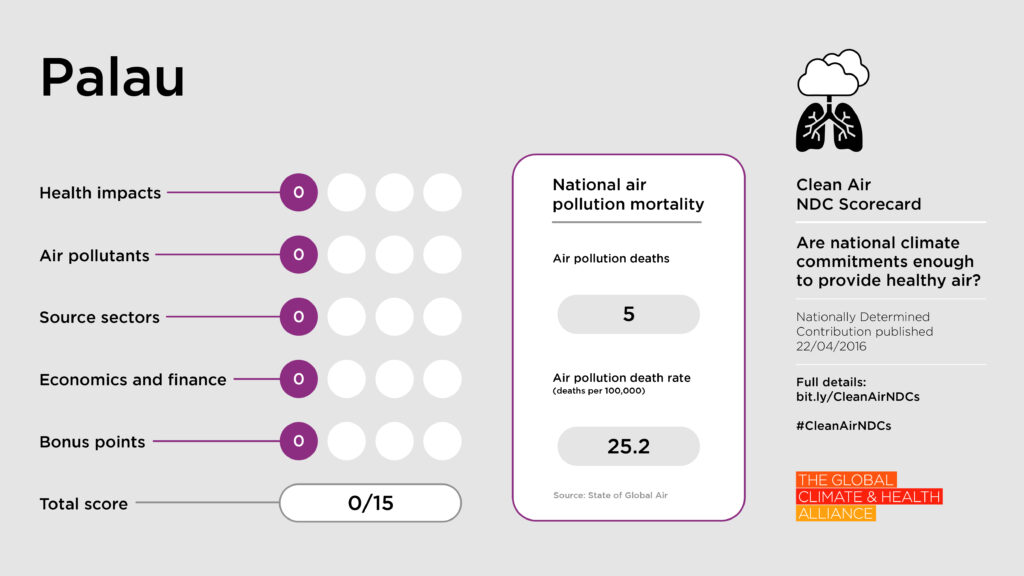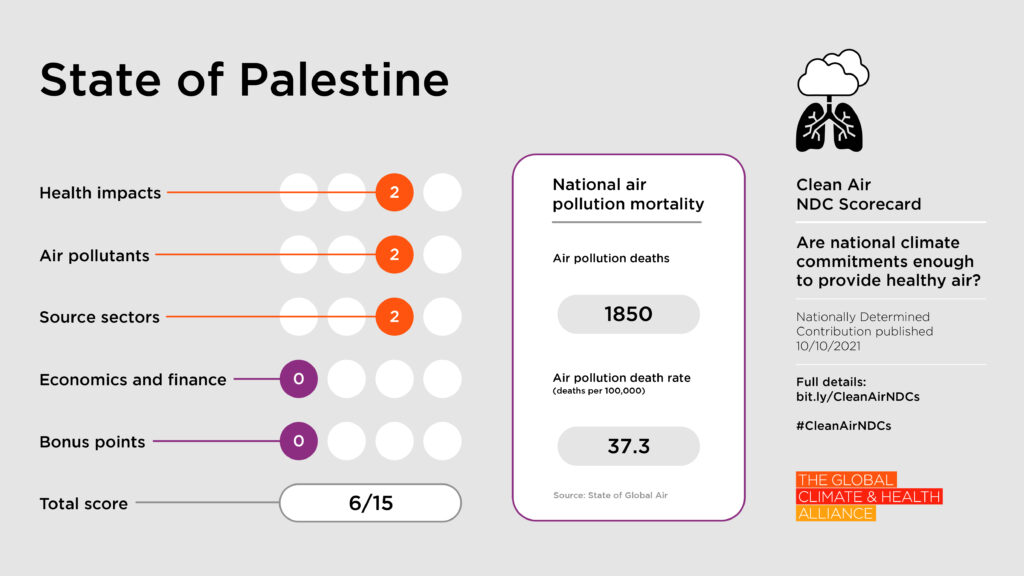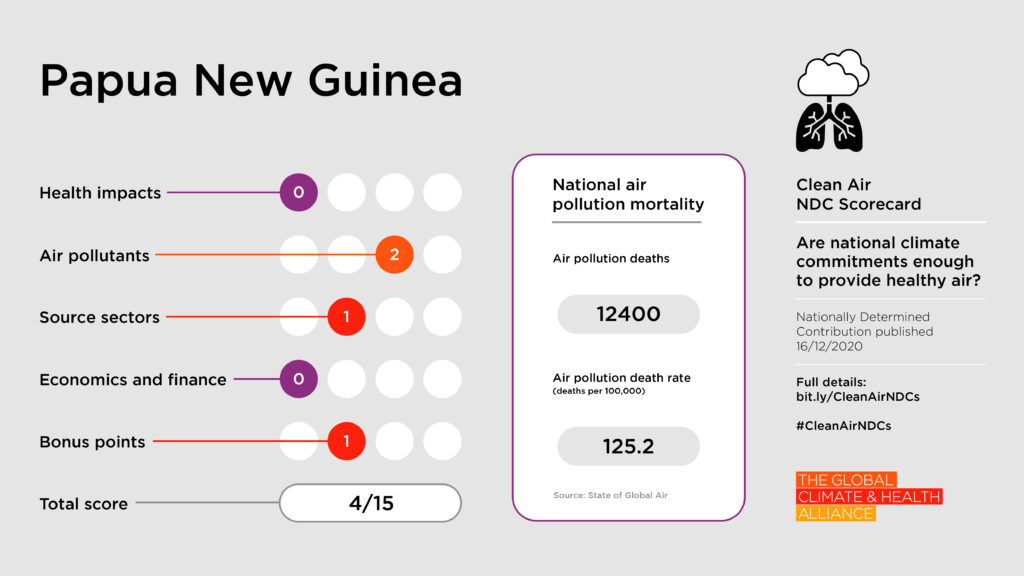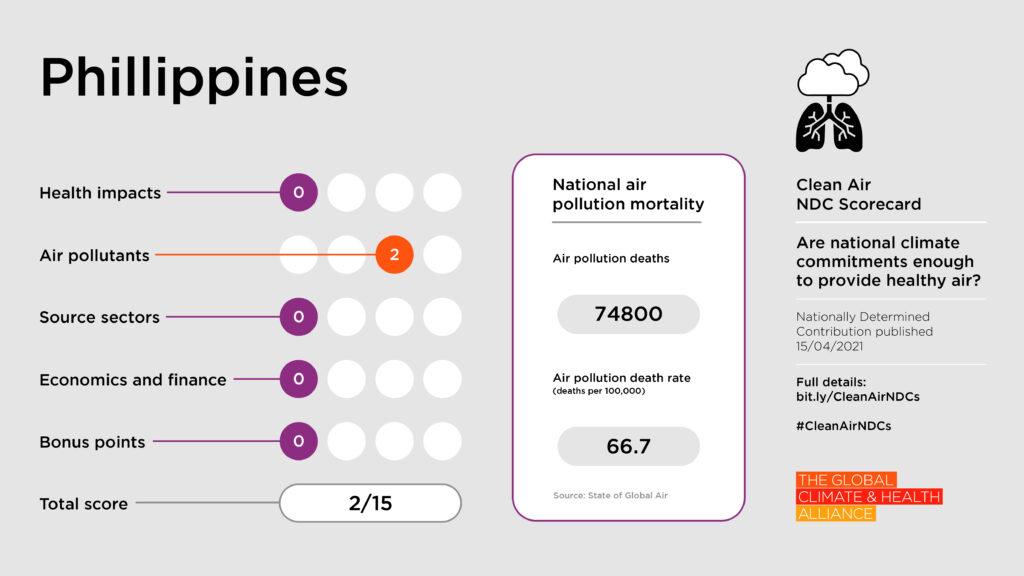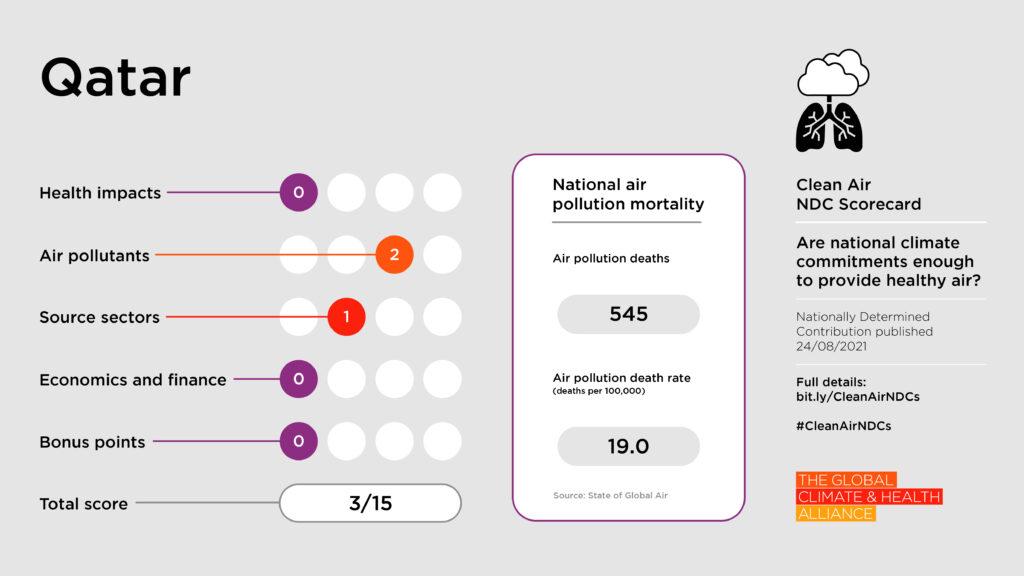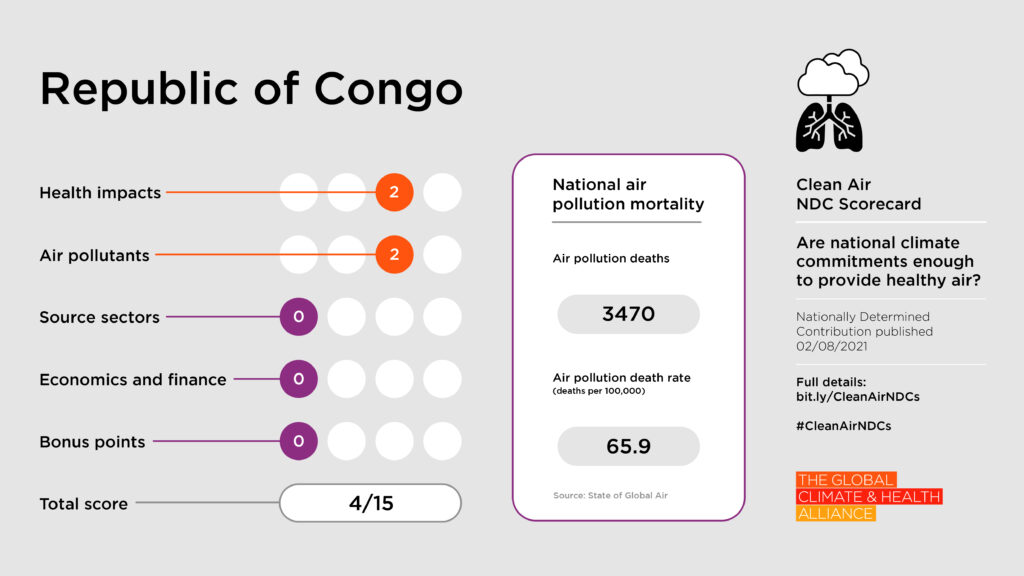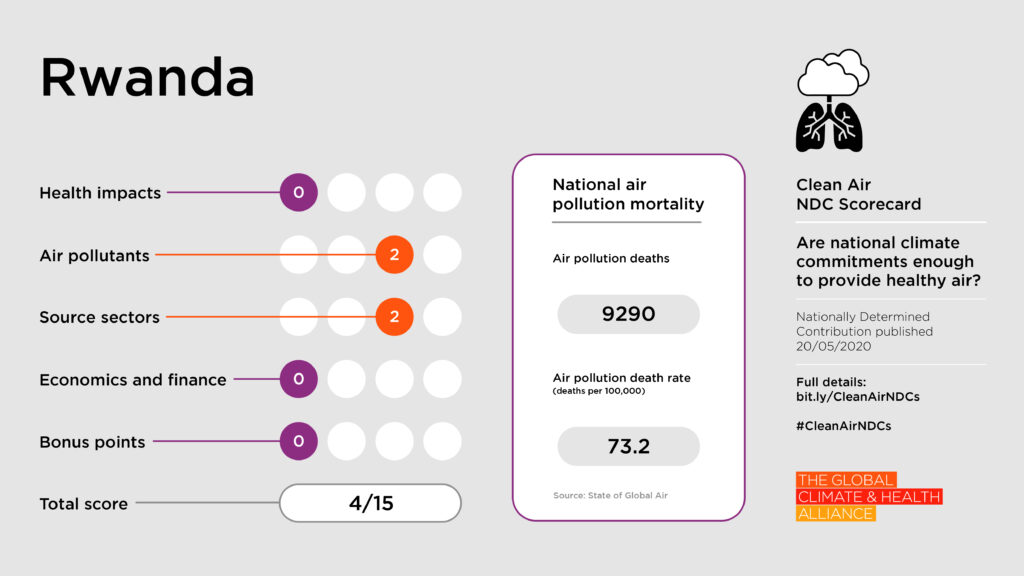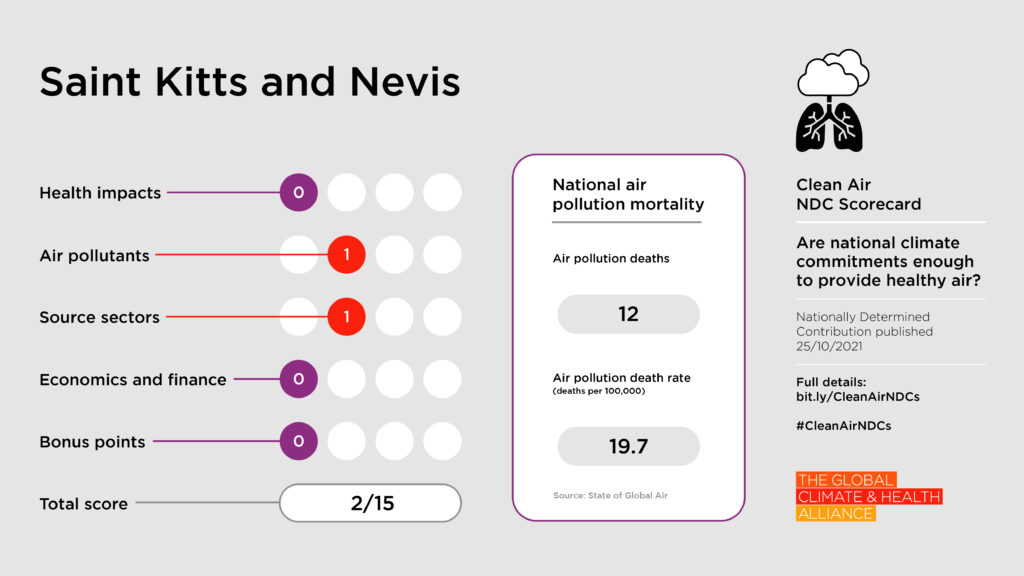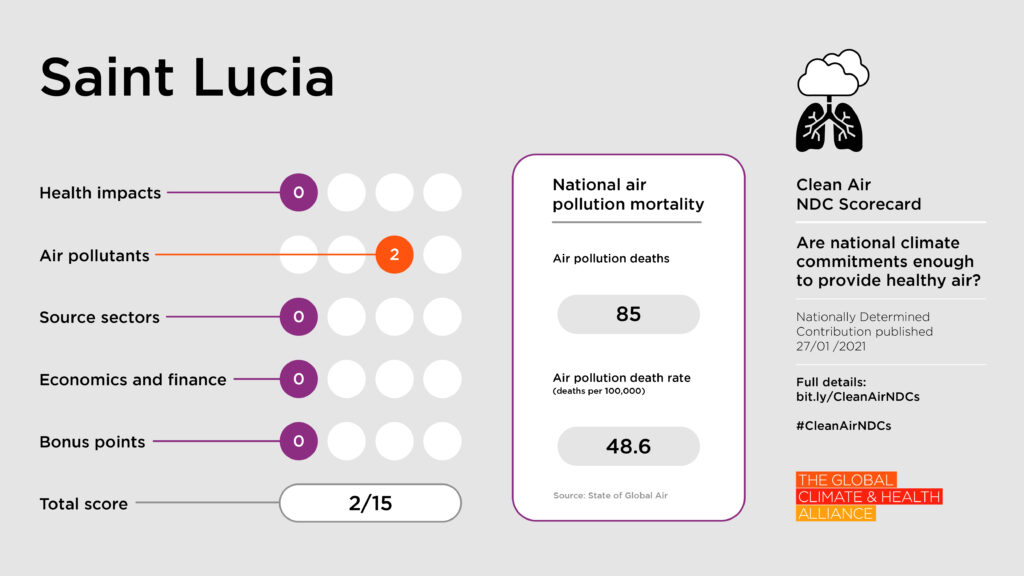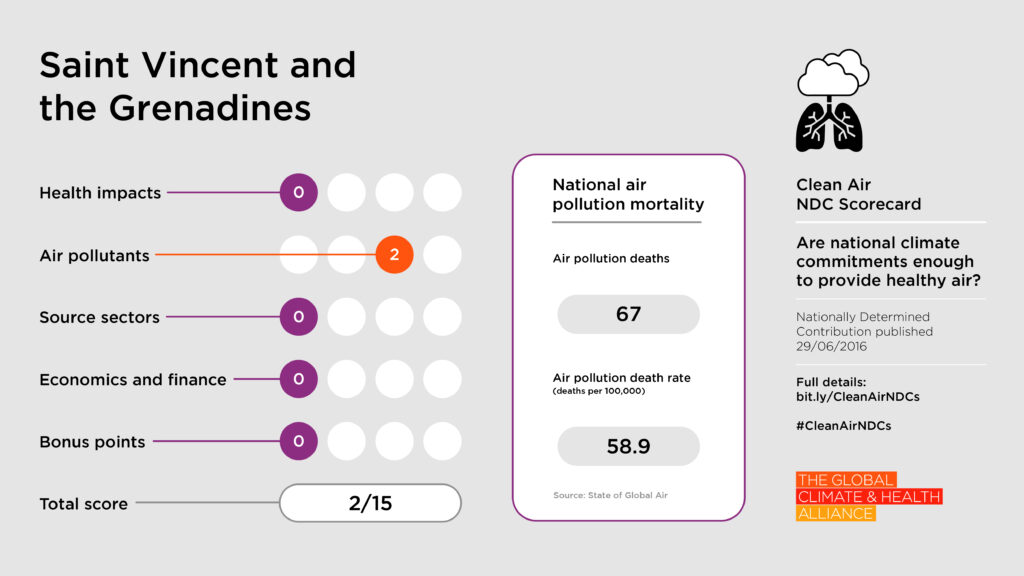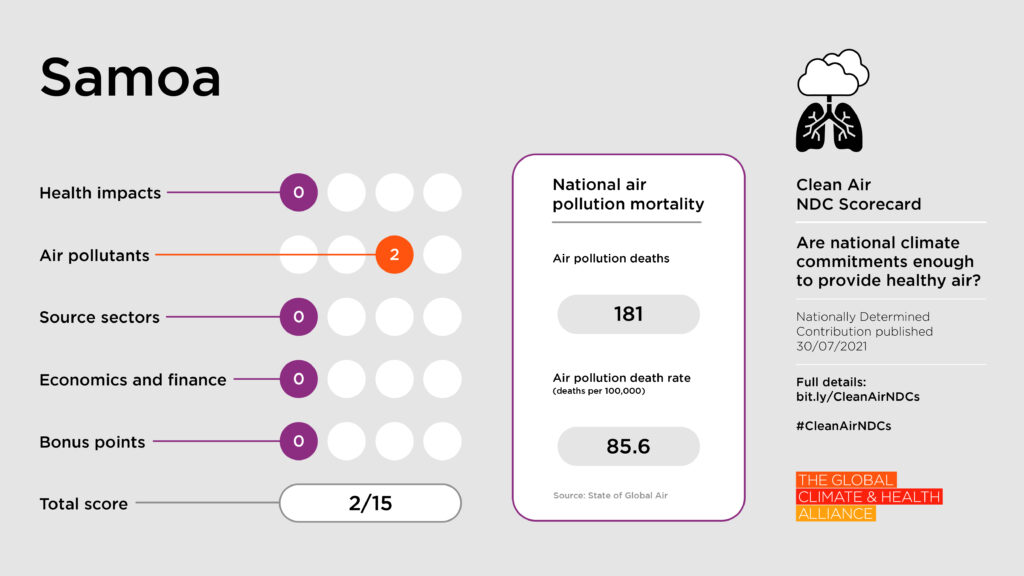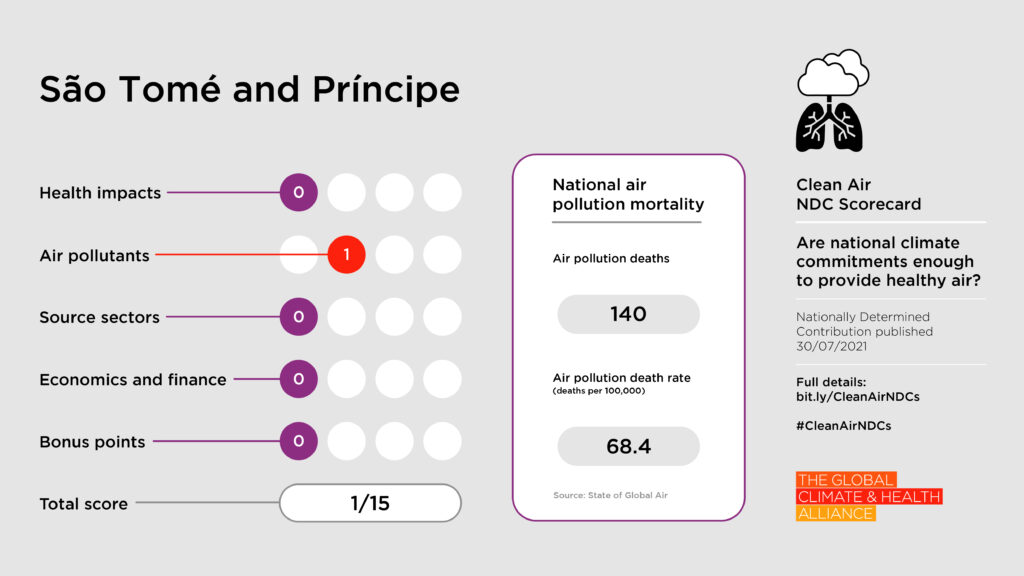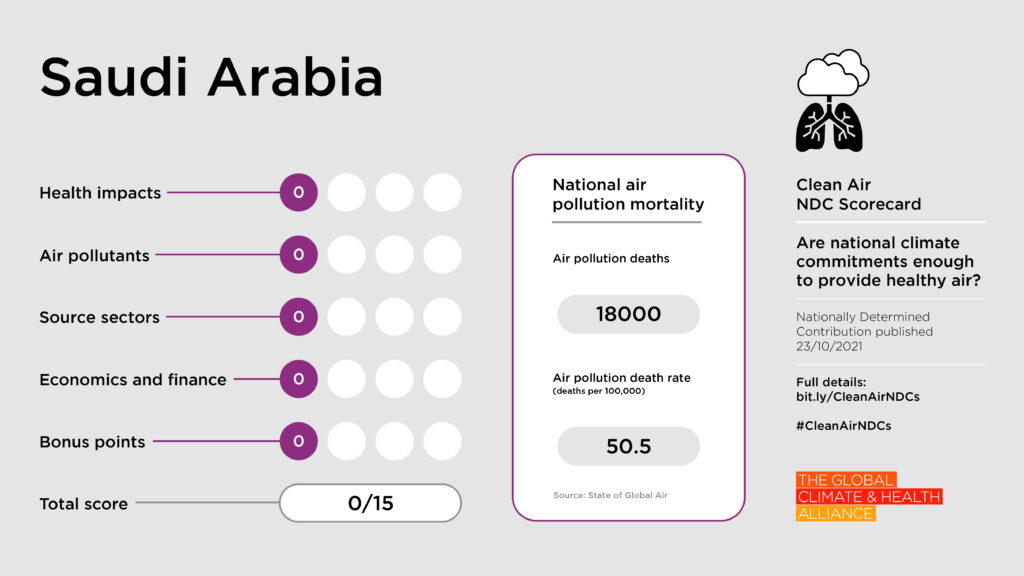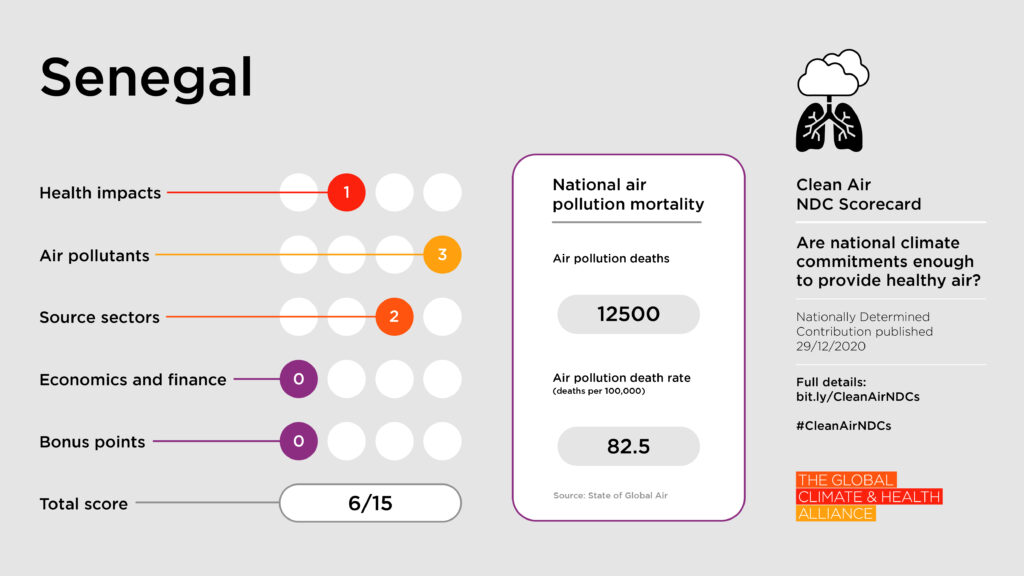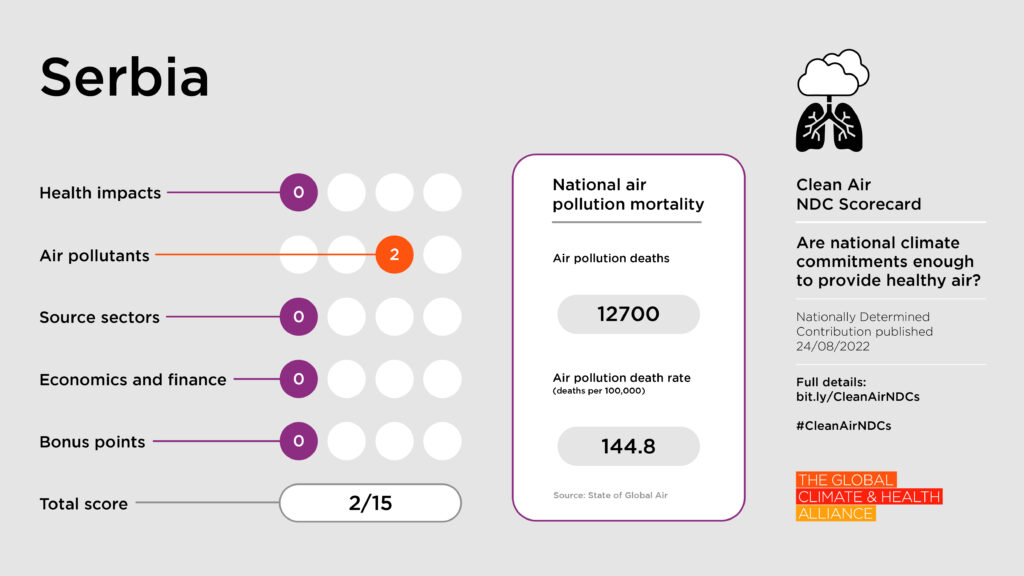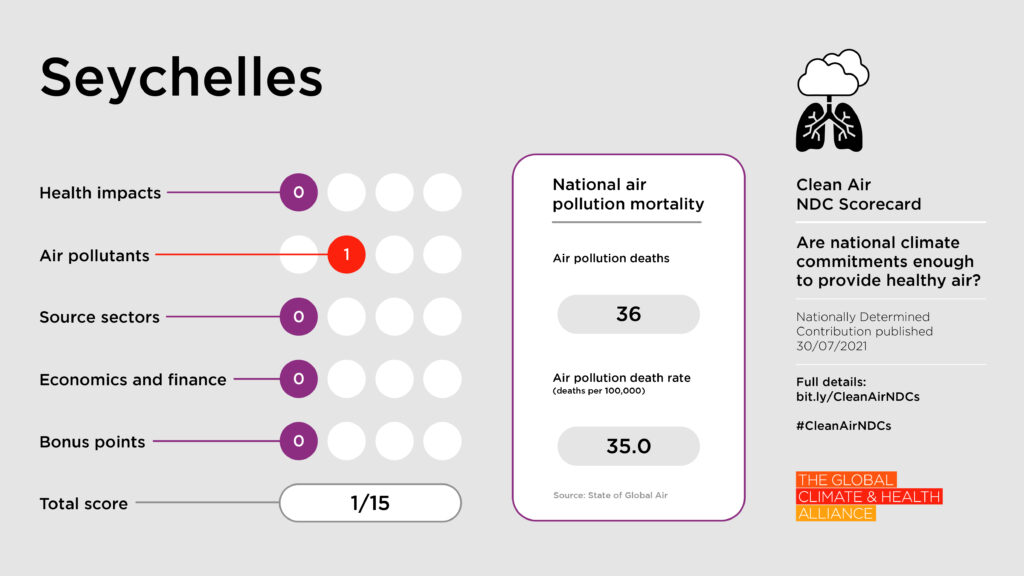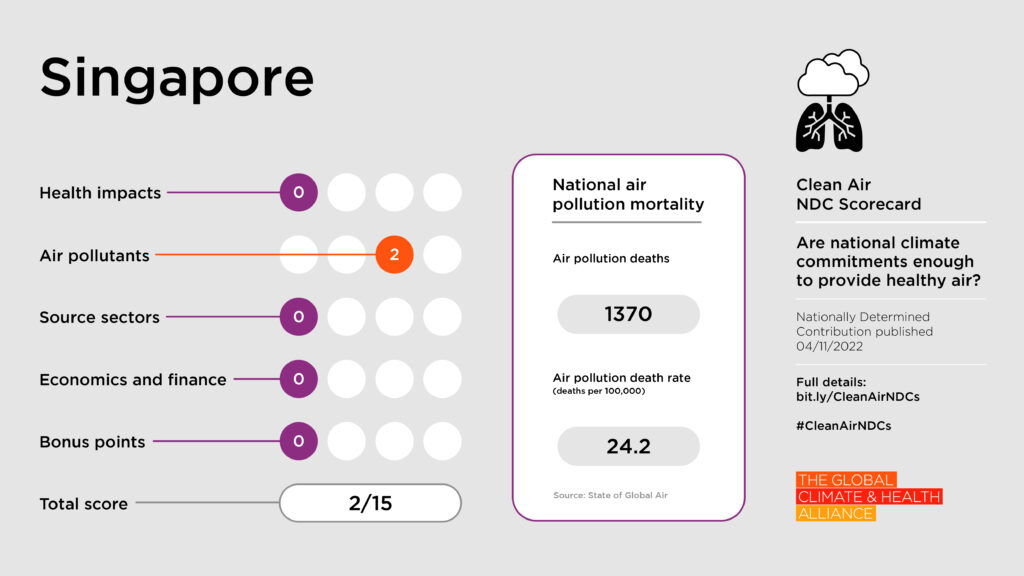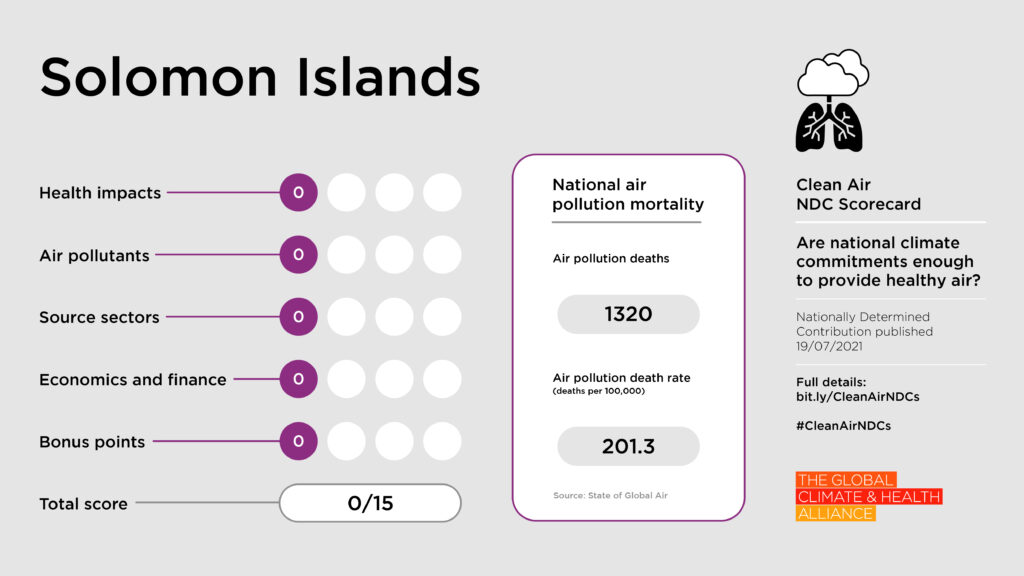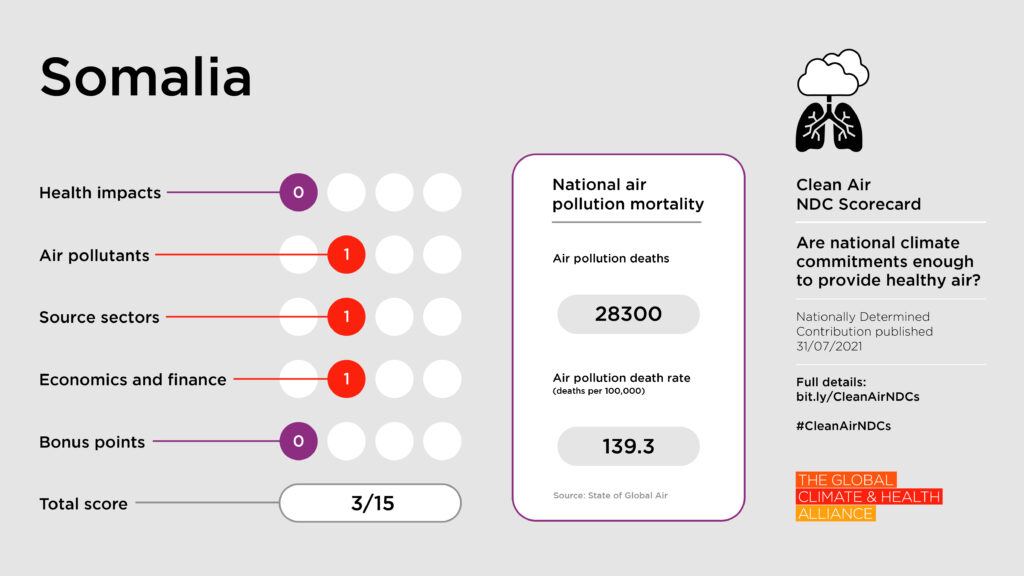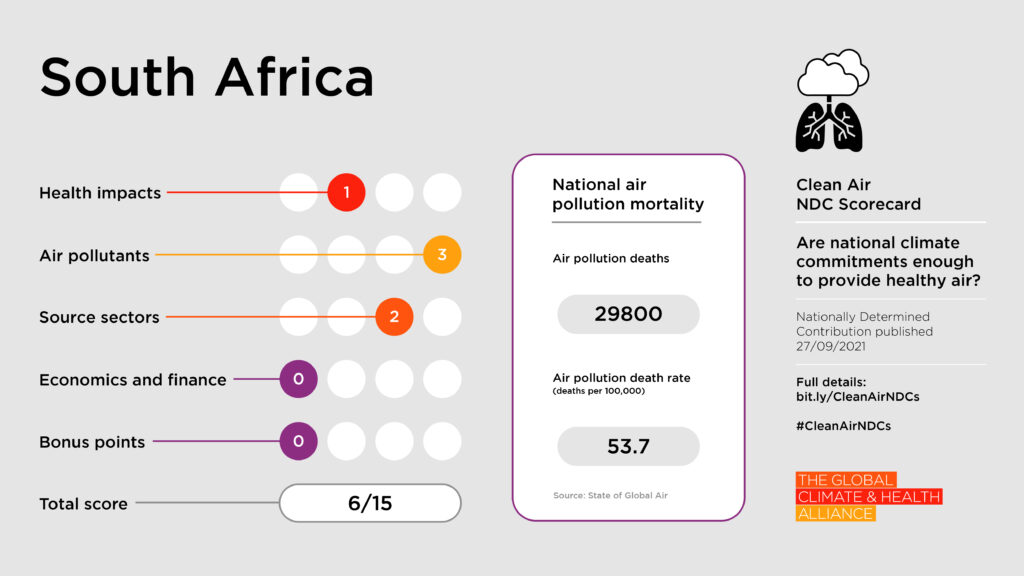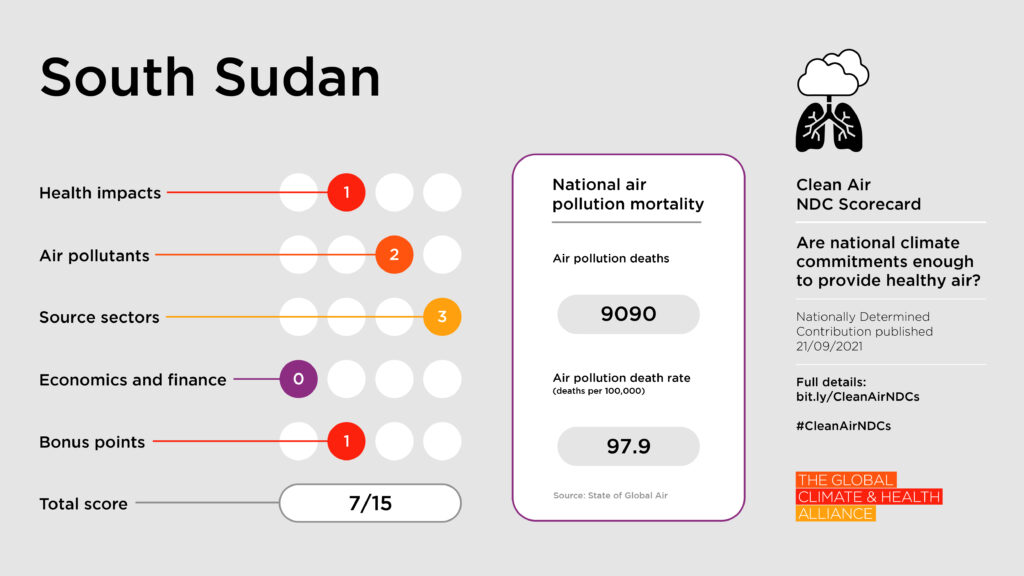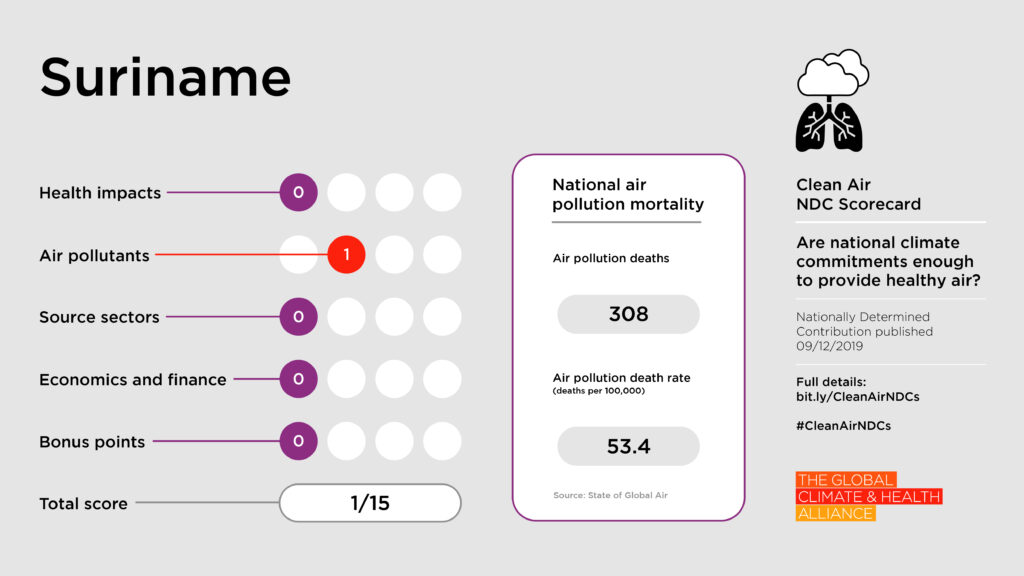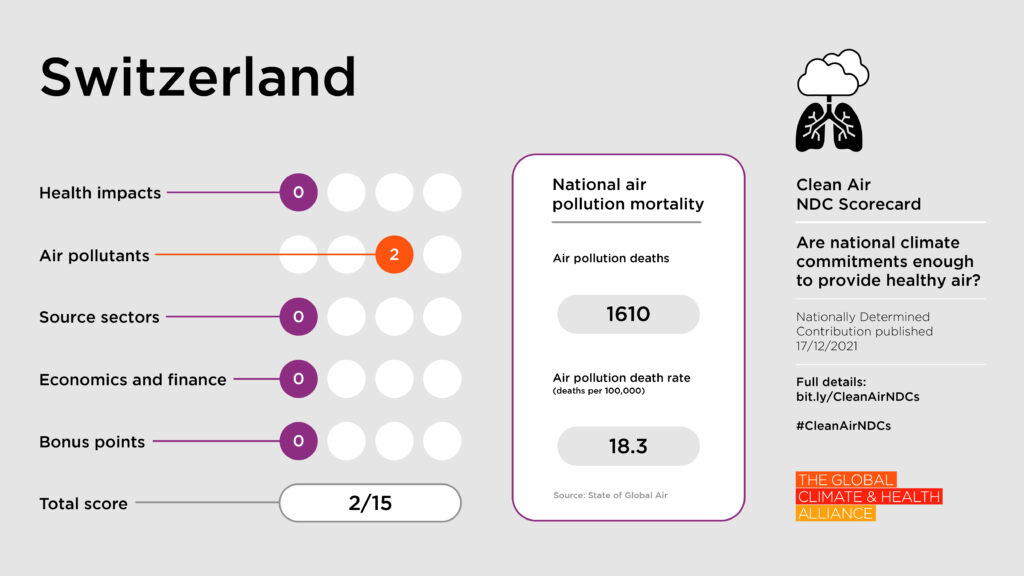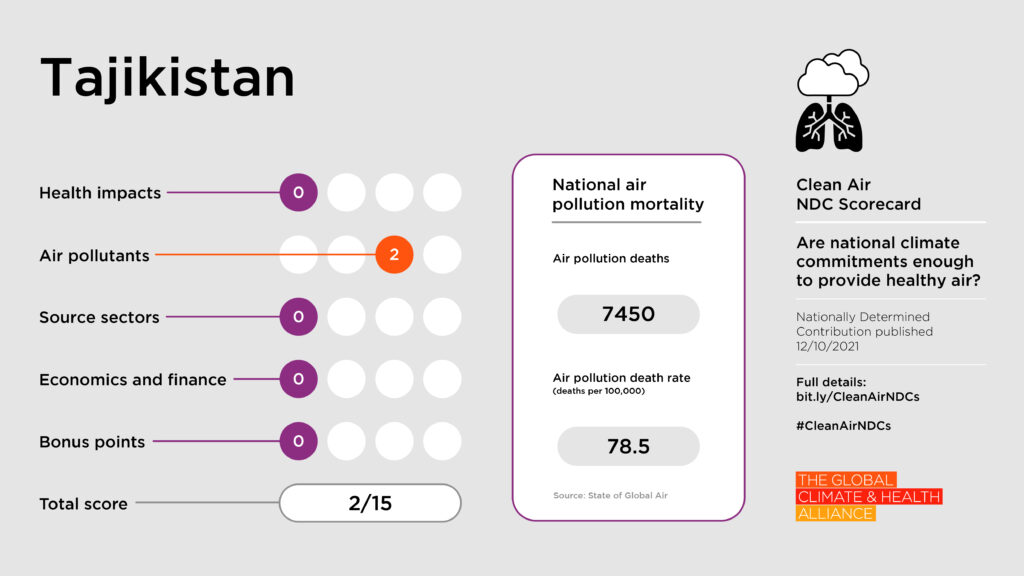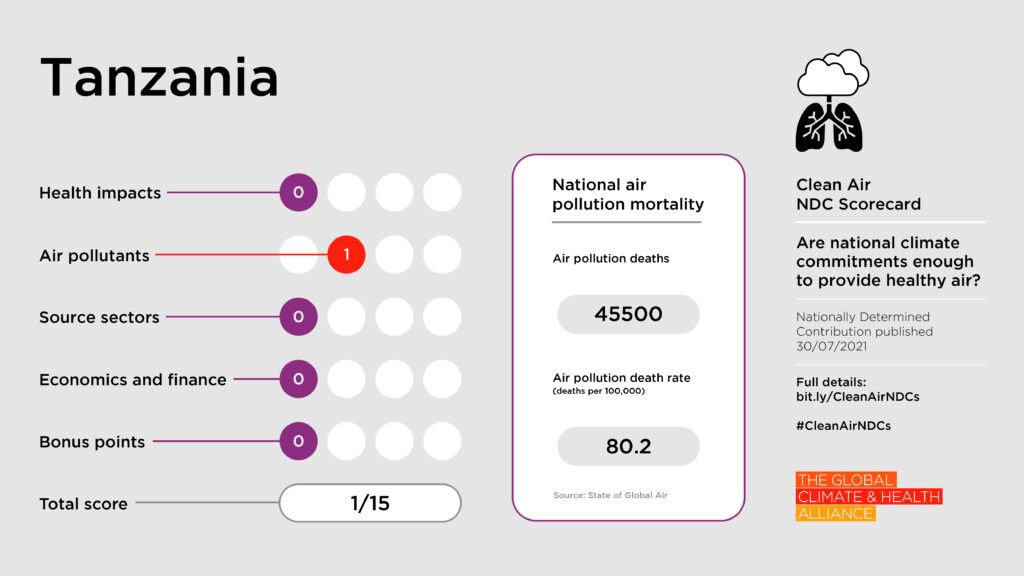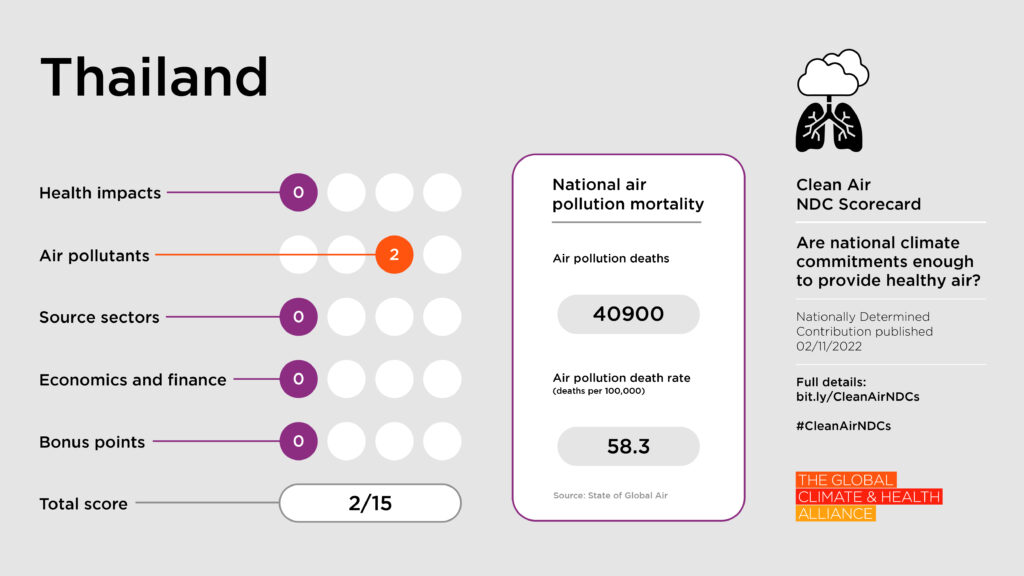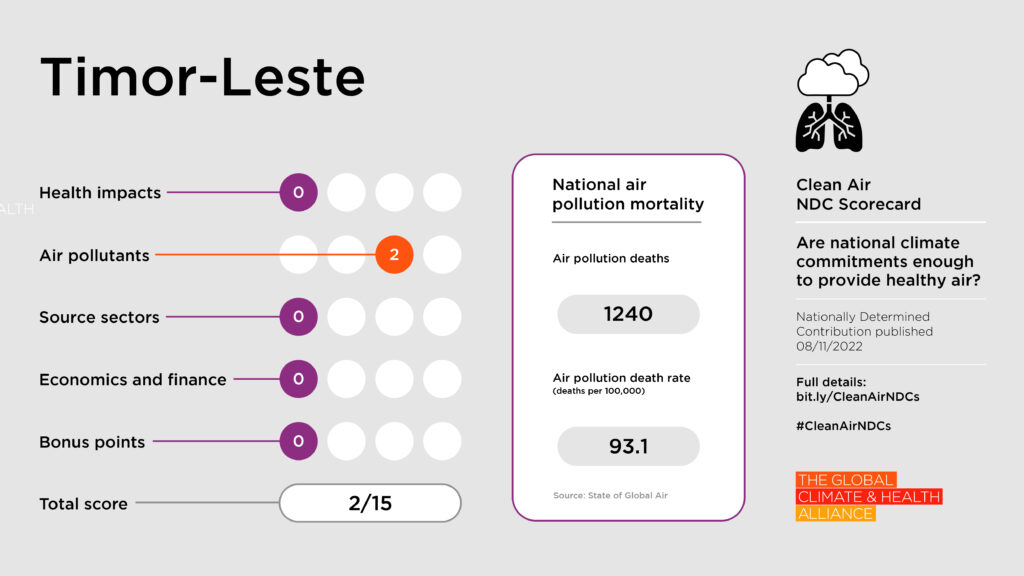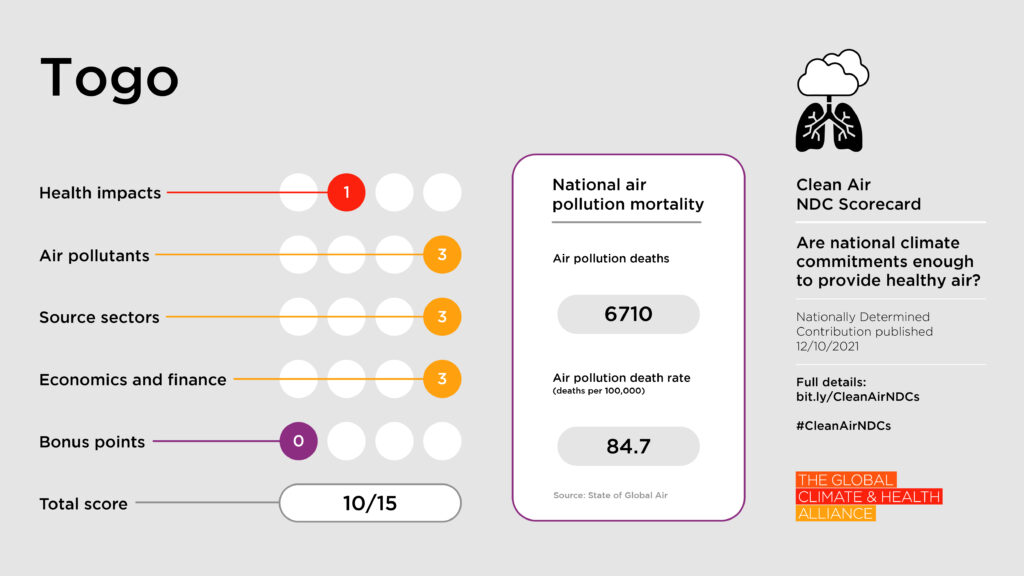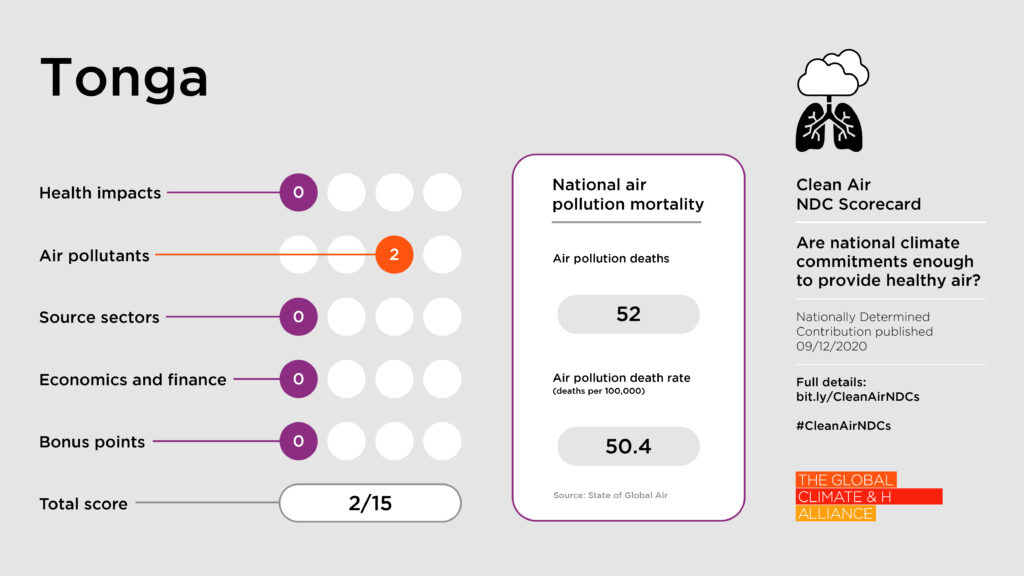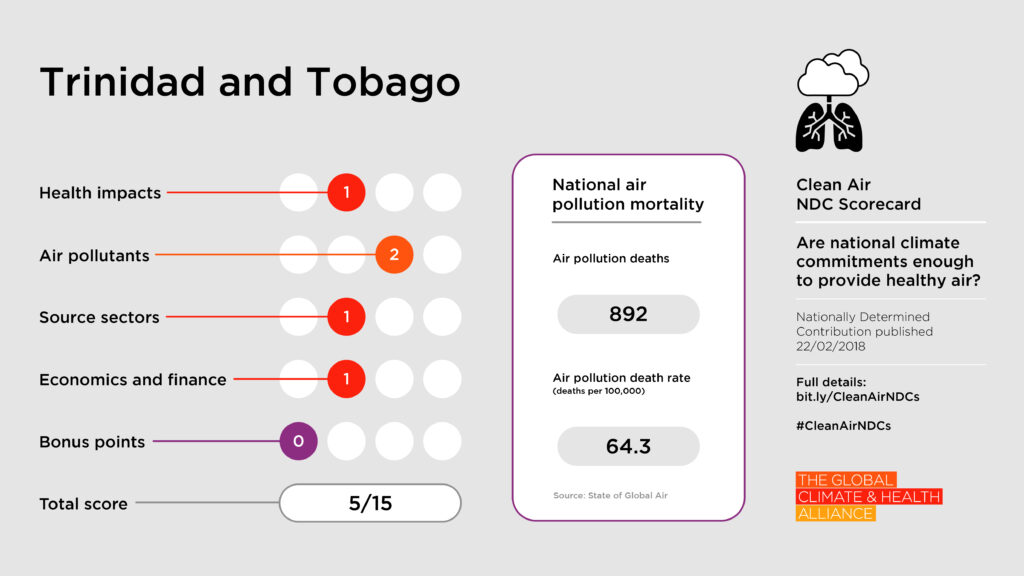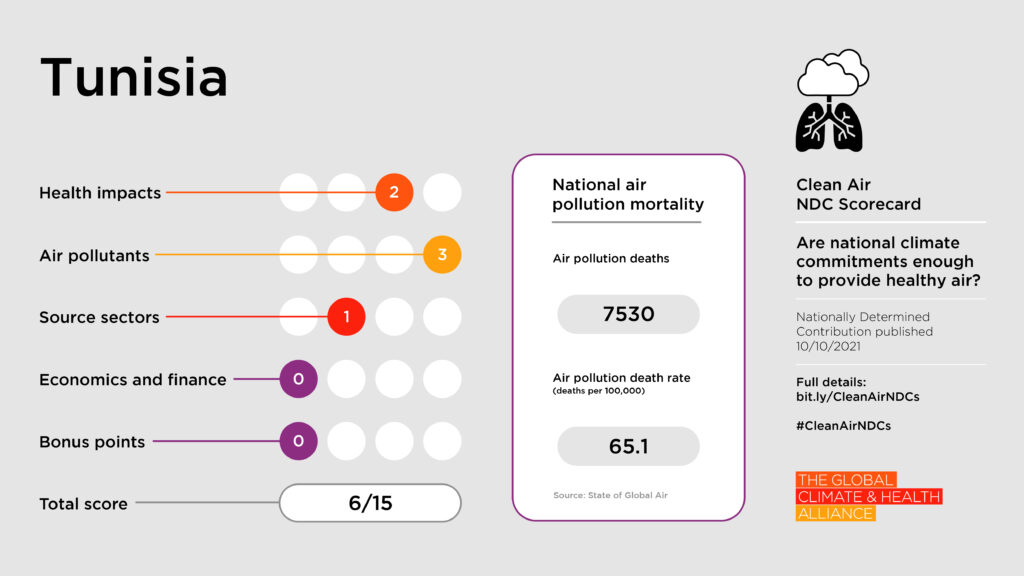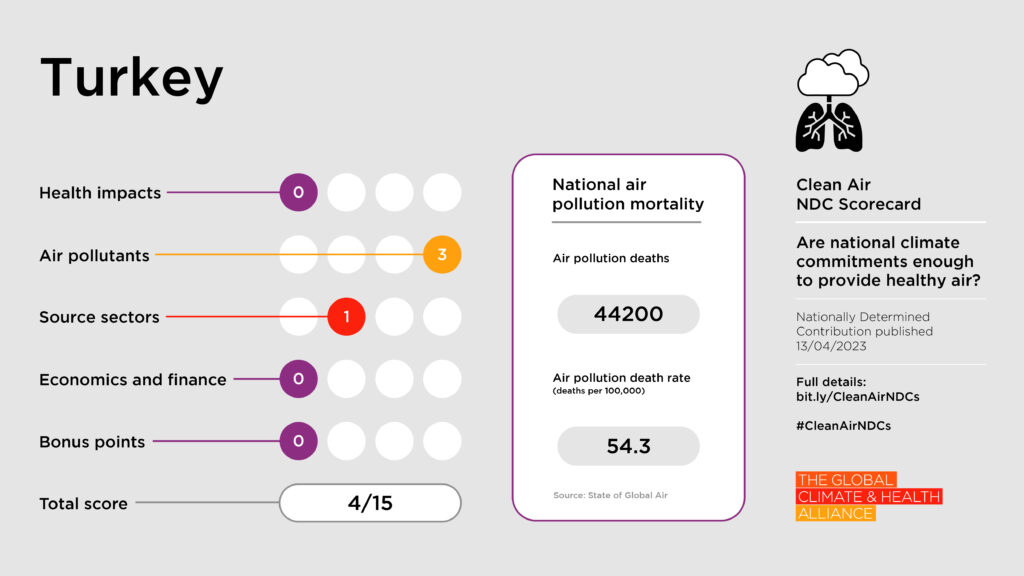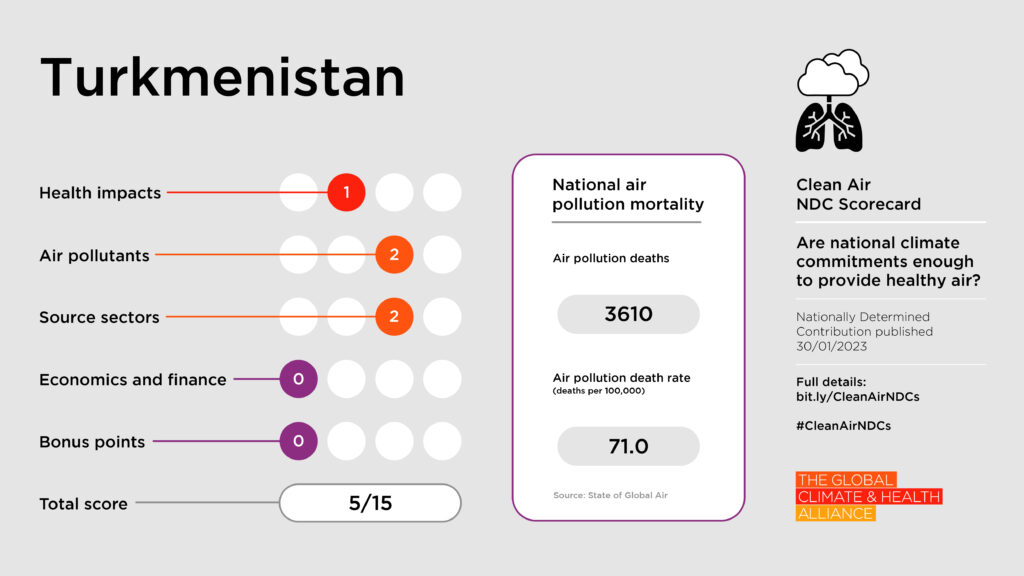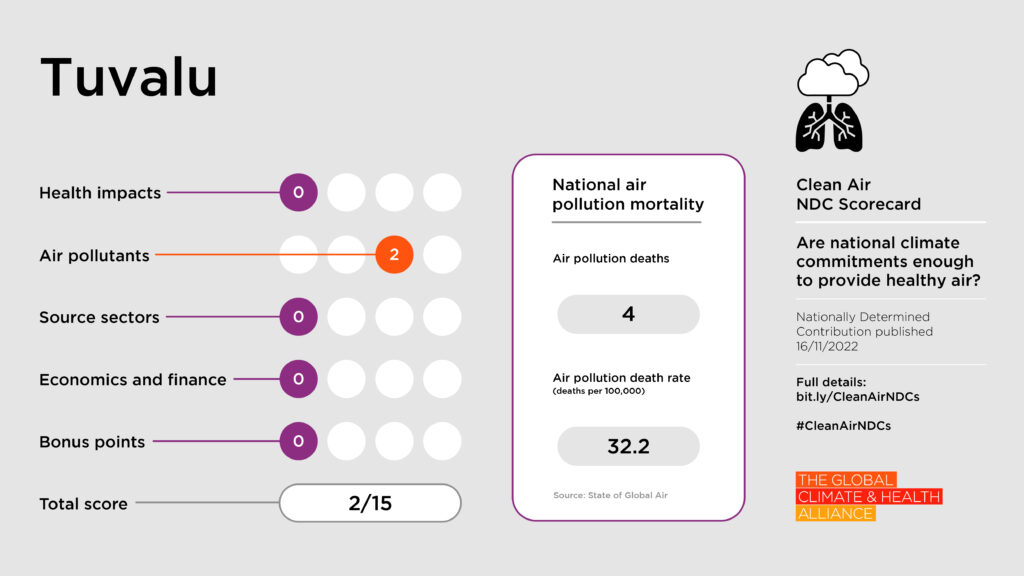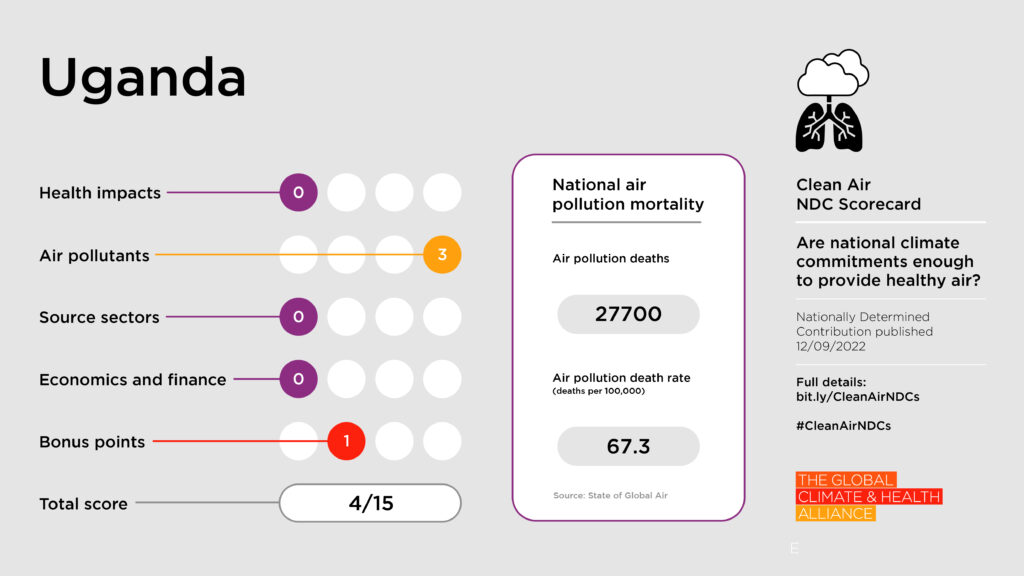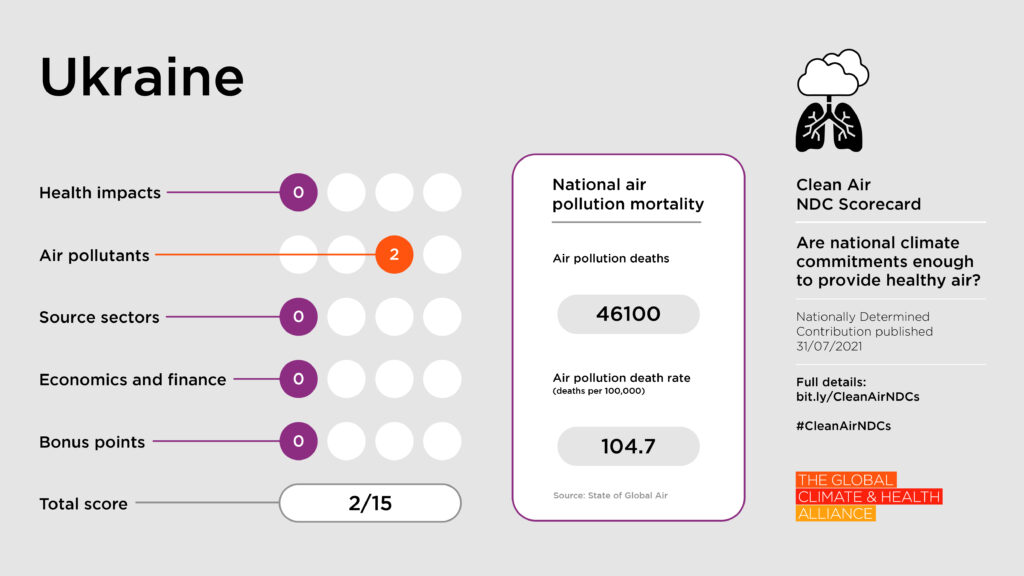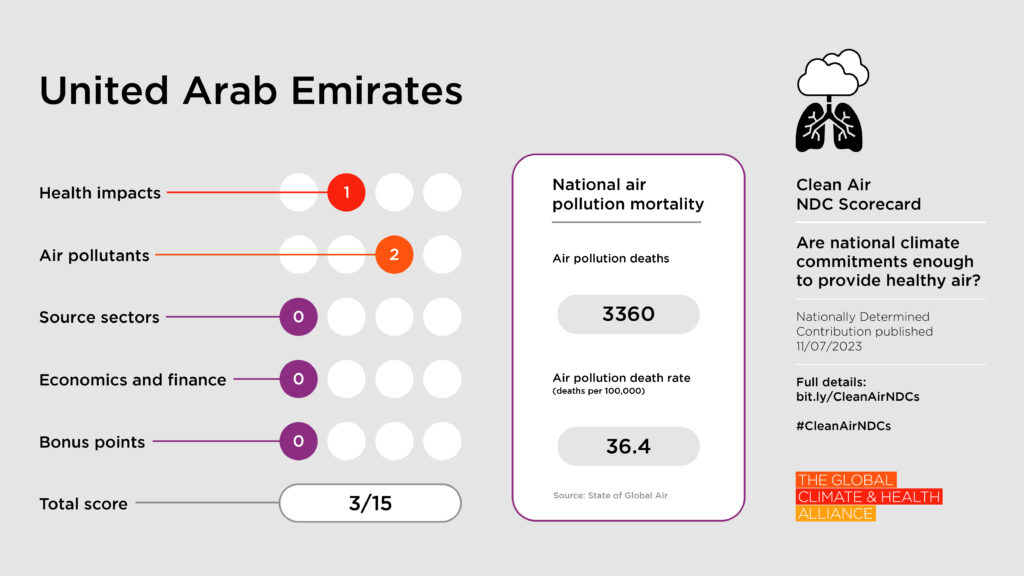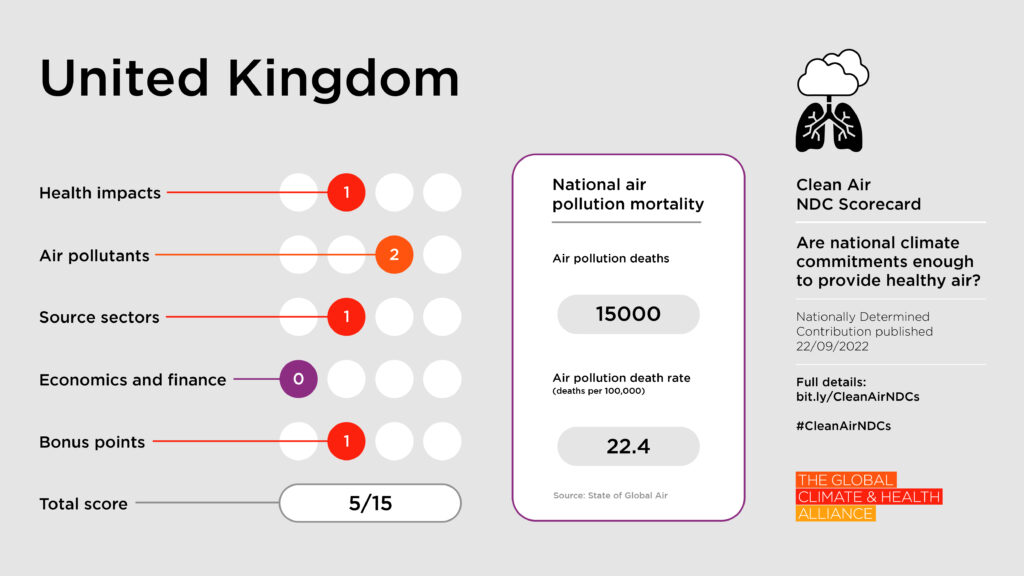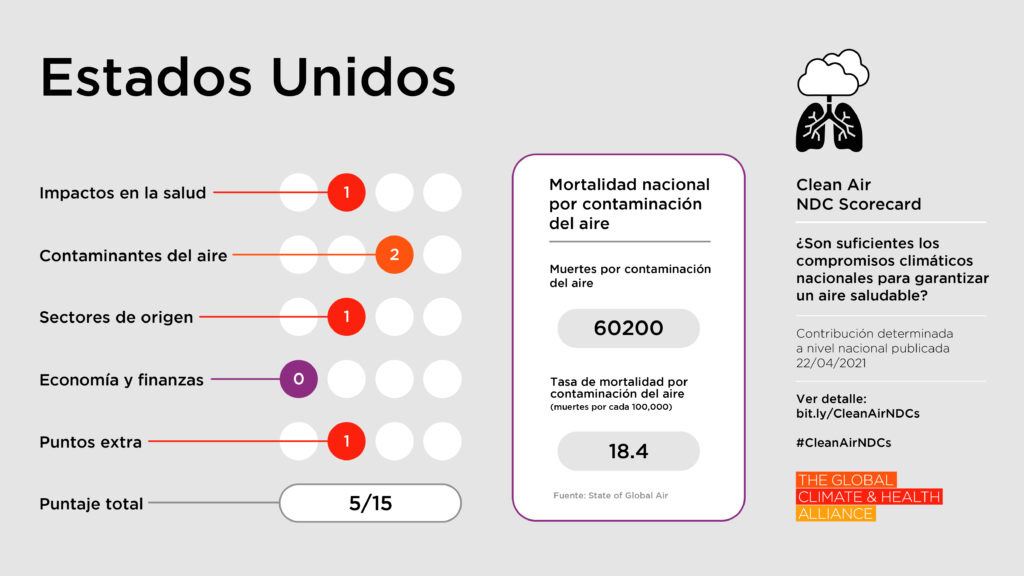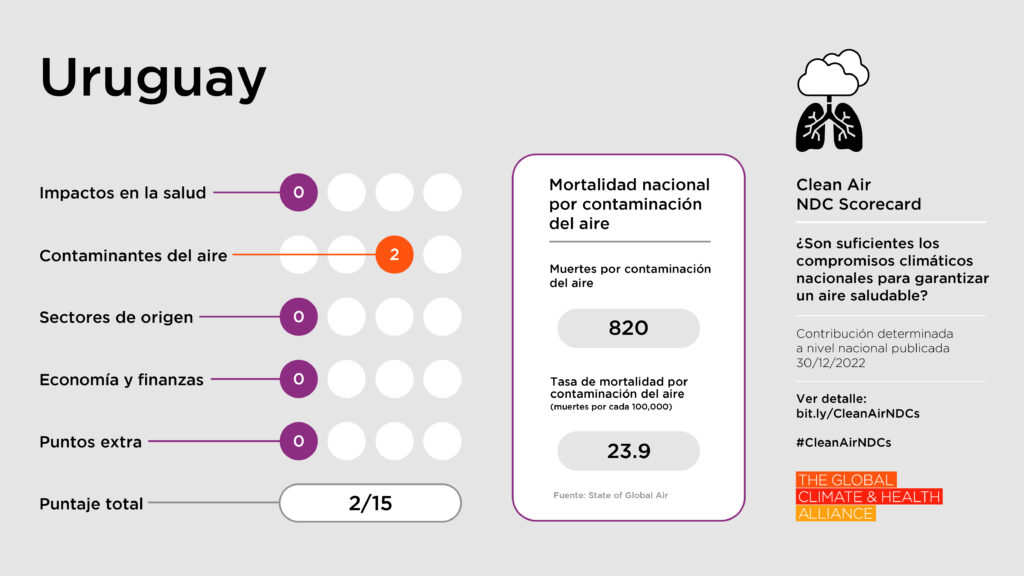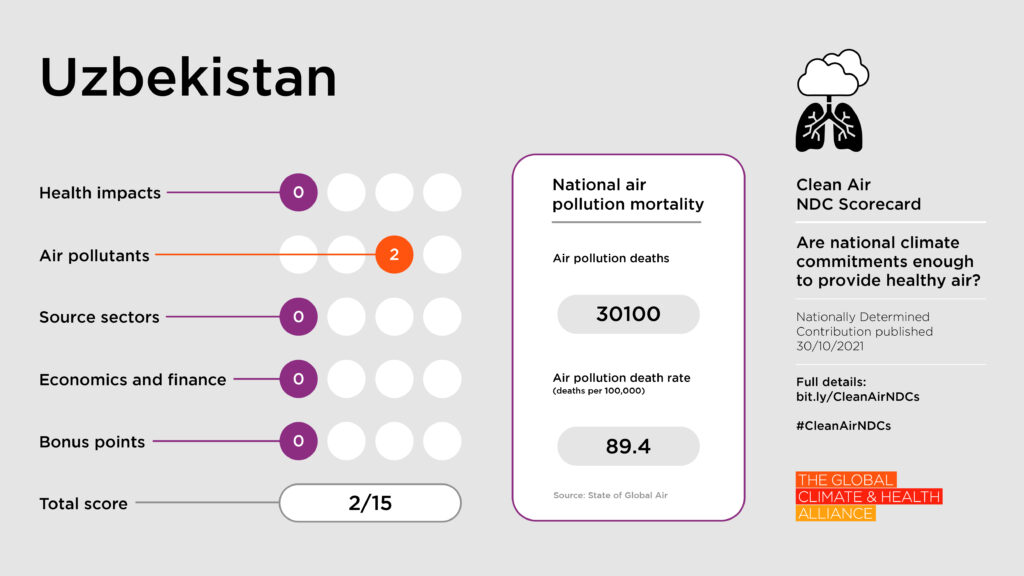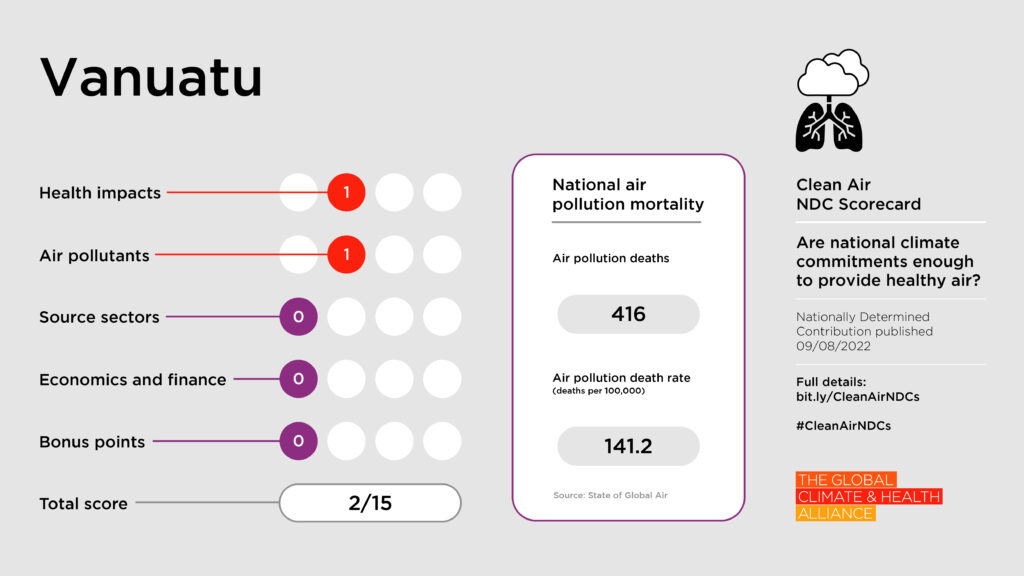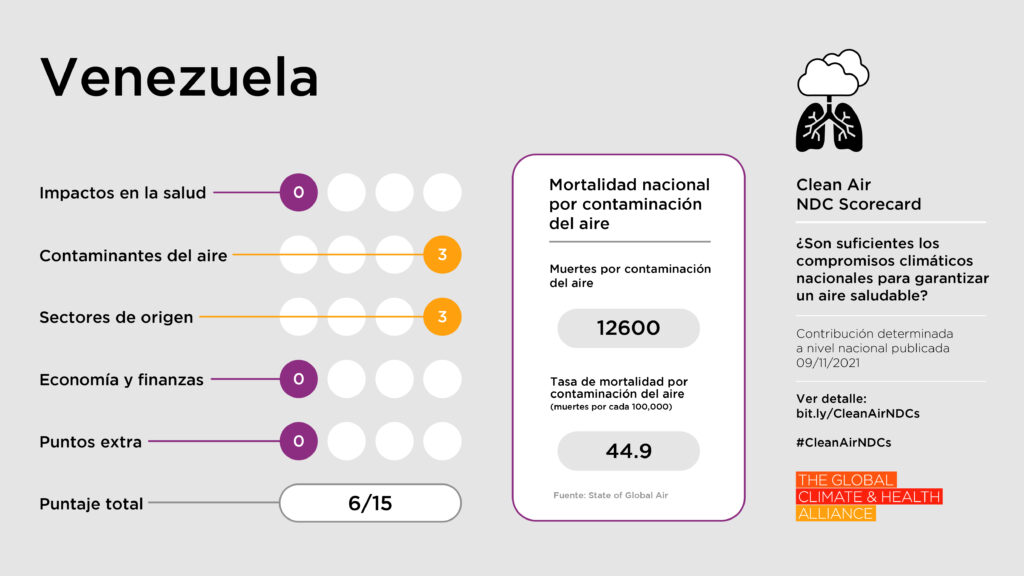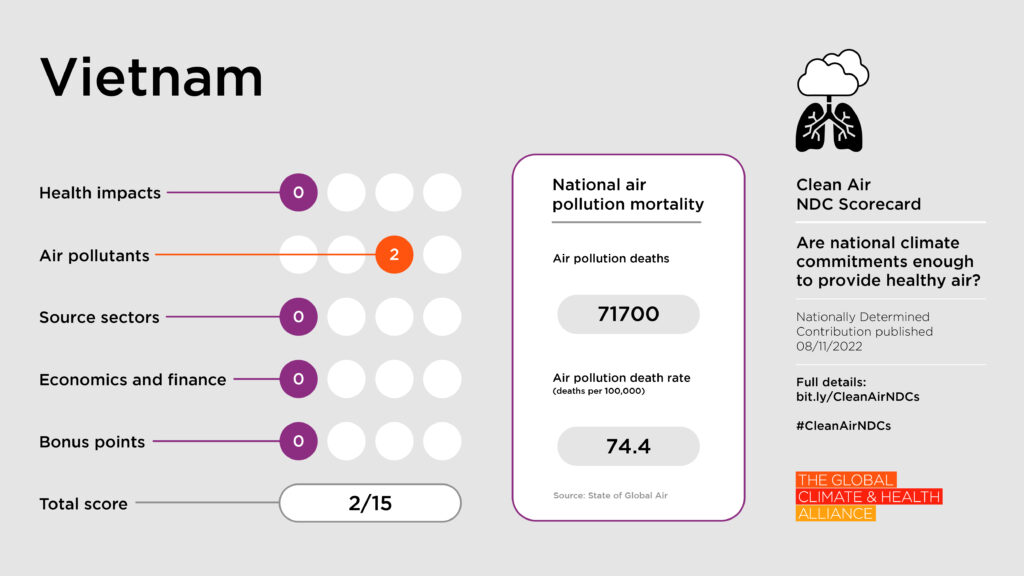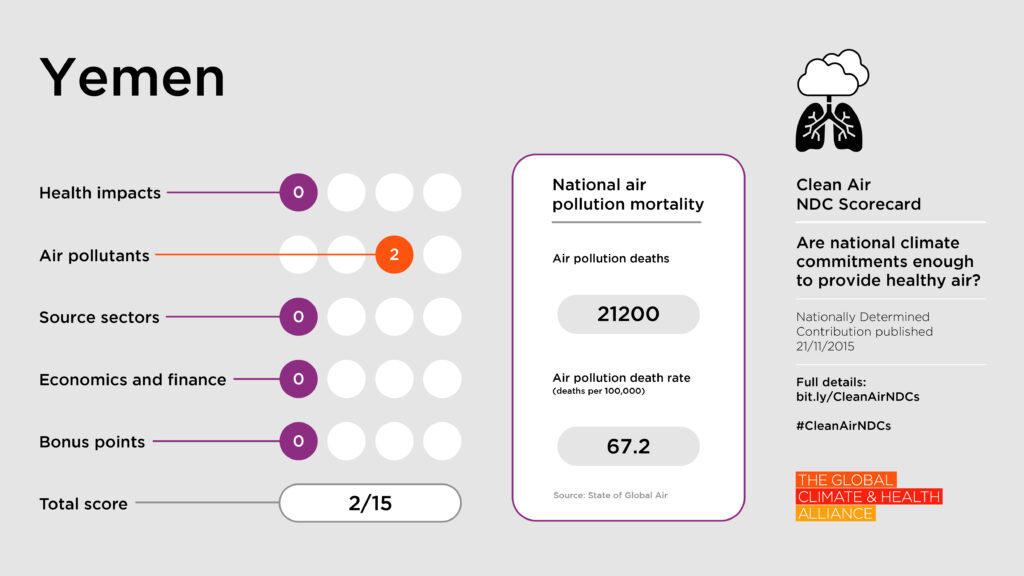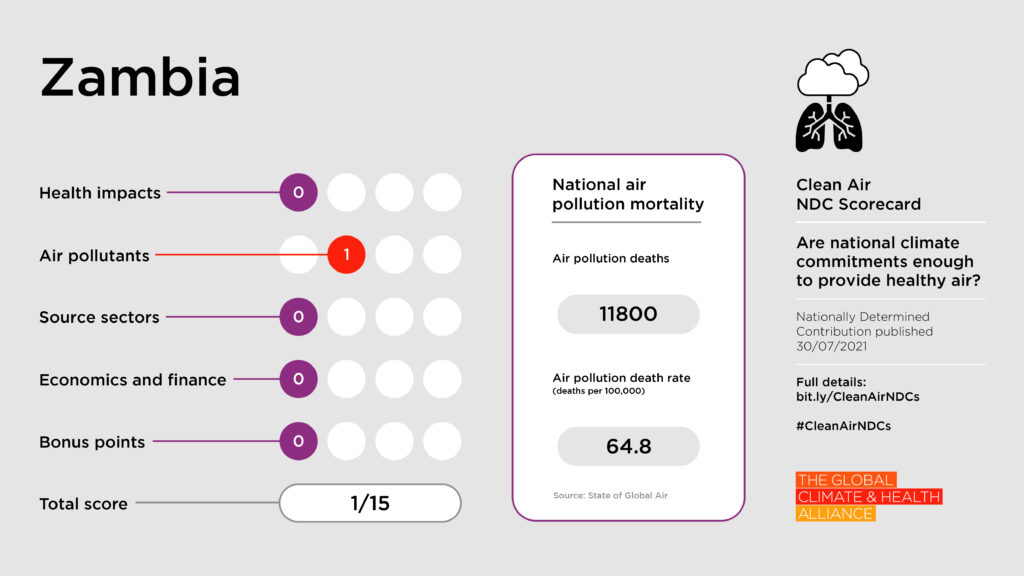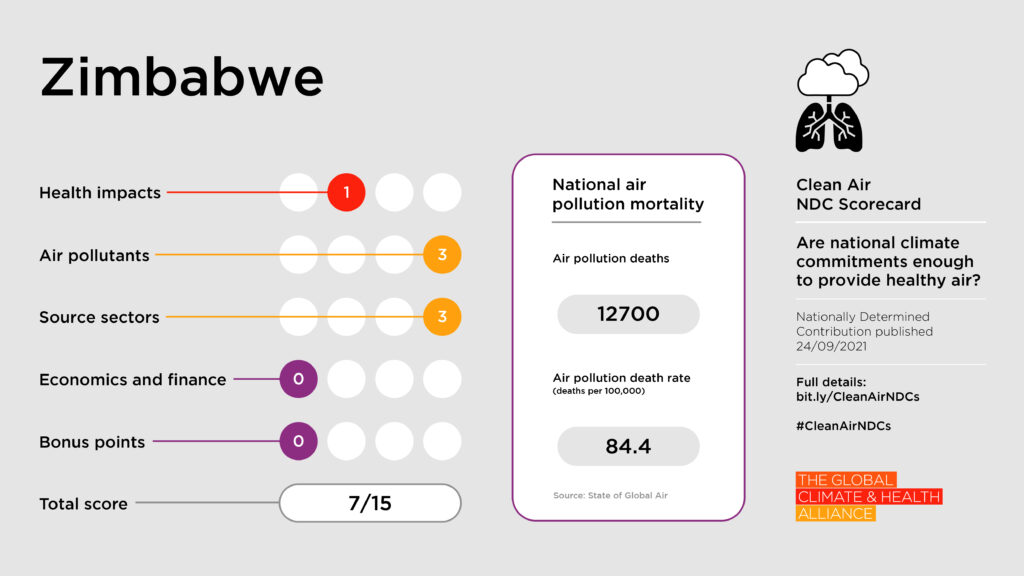Tarjeta de Puntuación NDC de aire limpio
La Puntuación de las NDC del aire limpio evalúa la integración de las consideraciones sobre la calidad del aire en las Contribuciones determinadas a nivel nacional (NDC). Las NDC son compromisos de los países para cumplir el objetivo del Acuerdo de París, limitar el aumento de la temperatura global muy por debajo de 2°C, y preferiblemente a 1,5°C. La contaminación del aire y el cambio climático comparten la combustión de combustibles fósiles como factor común. Al mismo tiempo, el cambio climático empeora la contaminación del aire existente. Estas interrelaciones y los impactos de la mala calidad del aire en la salud humana demuestran la necesidad de incorporar acciones de calidad del aire en las NDC.
La Puntuación de las NDC de aire limpio clasifica a 170 NDC (de 169 países, y la Unión Europea, que presenta una NDC conjunta).
Las NDC se evaluaron en función de su atención a cinco categorías para dar una puntuación total de aire limpio: impactos en la salud, contaminación del aire, sectores fuente, economía y finanzas, y puntos de bonificación. Había tres puntos disponibles para cada categoría, con un total posible de puntuación de aire limpio – 15.
Además, la Puntuación incluye información sobre la mortalidad por contaminación del aire en cada país, lo que revela si las medidas para lograr un aire limpio han sido suficientes. Las NDC se publican en el Sitio web de la CMNUCC. El detalle completo de la metodología y hallazgos se puede encontrar en el informe, y los hallazgos se resumen en el comunicado de prensa.
El contenido de las NDC proporciona una instantánea general de las prioridades de los gobiernos en relación con el cambio climático, y este análisis sirve como barómetro del grado en que se reconocen y abordan los vínculos intrínsecos entre la calidad del aire y el cambio climático. La “puntuación de aire limpio” calculada por GCHA se basa únicamente en el análisis de la NDC de cada país y no en otras políticas más amplias. Por su naturaleza, las NDC se refieren principalmente a planes y objetivos futuros. Si bien el compromiso es un requisito previo para una acción ambiciosa, la calidad del aire y, por ende, la salud humana, sólo se beneficiarán si se cumplen estos compromisos.
GCHA agradece a Blanca Paniello Castillo e Iris Blom por su trabajo en el desarrollo de la metodología y por realizar el análisis de este proyecto, y a Pallavi Pant del Health Effects Institute por su orientación sobre los datos de mortalidad por contaminación del aire. Este trabajo fue posible gracias a una subvención del Clean Air Fund. Si tiene preguntas o comentarios, comuníquese con Jess Beagley a [email protected].
Resultados
De las 170 NDC analizadas, casi todas (164) mencionan en alguna medida la contaminación del aire. Colombia y Malí lideran la integración de consideraciones sobre la contaminación del aire en sus NDC, logrando 12/15 puntos posibles, seguidos por Chile, Costa de Marfil, Togo y Nigeria con 10/15 puntos. Por el contrario, seis NDC obtuvieron 0/15 puntos, a saber, Arabia Saudita (que figura entre los diez principales emisores mundiales en términos de emisiones totales y emisiones per cápita), Corea del Norte (que tiene la tasa más alta de mortalidad por contaminación del aire a nivel mundial), Bahrein (el segundo (mayor emisor per cápita de gases de efecto invernadero a nivel mundial), Nauru, Palau y las Islas Salomón.
COMPARACIONES GLOBALES
- 14 de los 15 países con mejor puntuación son países de ingresos bajos o medios (a saber, Colombia, Malí, Costa de Marfil, Nigeria, Pakistán, Togo, Ghana, Albania, Bangladesh, Camboya, El Salvador, Honduras, Moldavia, Sierra Leona), junto a Chile como el único país de altos ingresos. Estos países muestran compromiso con la acción a favor del aire limpio, el clima y la salud en sus NDC, y están preparados para obtener retornos de la inversión en acciones beneficiosas para todos.
- Varios países africanos obtienen puntuaciones altas: 5 de los 8 países con puntuaciones de 9/15 o más son Malí, Costa de Marfil, Nigeria, Togo y Ghana.
- A nivel mundial, los resultados demuestran un gran margen de mejora: la puntuación media alcanzada en cualquier NDC fue de 3,5/15 puntos.
- Los países de altos ingresos no están logrando cosechar los beneficios colaterales del aire limpio y la oportunidad de maximizar los beneficios para la salud de sus compromisos climáticos, con una puntuación promedio de 2,9/15 puntos. Mientras tanto, los países del G20 que presentaron una NDC individual (todos excepto Alemania e Italia) tienen una puntuación inferior a la media, con una media de 3,3/15 puntos.
- Los diez principales emisores per cápita (Qatar, Bahrein, Brunei Darussalam, Trinidad y Tobago, Kuwait, Emiratos Árabes Unidos, Mongolia, Omán, Australia, Arabia Saudita), muchos de los cuales son importantes productores de combustibles fósiles, obtuvieron una media de sólo 2,4/15 puntos, lo que indica una falta de interés en conectar la eliminación de los combustibles fósiles con el aire limpio y sus posibles beneficios para la salud.
- Mientras tanto, los diez principales emisores totales (China, Estados Unidos, India, Unión Europea, Federación de Rusia, Brasil, Indonesia, Japón, Irán, Arabia Saudita) obtuvieron una puntuación un poco mejor, con una media de 2,7/15 puntos.
- En varios países con puntuaciones más altas, incluidos Malí, Camboya, Pakistán y China, existen altos niveles de mortalidad por contaminación del aire. Una mayor financiación podría permitir a estos países acelerar la implementación de las acciones descritas. Mientras tanto, los países donantes potenciales a menudo no reconocen estos vínculos en sus propias NDC.
- Los diez países con las tasas más altas de mortalidad por contaminación del aire (Corea del Norte, Islas Salomón, Macedonia del Norte, República Centroafricana, Bosnia y Herzegovina, Serbia, Vanuatu, Somalia, Nepal, Myanmar) anotaron una media de 2,5/15 puntos, lo que subraya la impactos en la salud pública por no reconocer los vínculos entre la acción climática y el aire saludable.
Como en iteraciones anteriores de la Puntuación de NDC Saludable, que evaluó la integración de la salud en las NDC, los países de ingresos bajos y medios obtuvieron las puntuaciones más altas. En la Puntuación NDC del Aire Limpio, los países de bajos ingresos tienen las puntuaciones medias más altas, con una media de 3,7/15 puntos. Le siguieron de cerca los países de ingresos medianos bajos, con un promedio de 3,6/15 puntos, mientras que los países de ingresos medianos altos obtuvieron un promedio de 3,4/15 puntos. Los países de altos ingresos obtuvieron un promedio de 2,9/15 puntos.
ENFOQUE EN LOS PAÍSES CON MAYOR PUNTUACIÓN DE AIRE LIMPIO
Colombia tiene una puntuación general de aire limpio de 12/15. Su NDC reconoce la importancia de proteger la salud (incluida específicamente la salud respiratoria) a través de acciones sobre la calidad del aire y de monitorear estos avances. La NDC afirma que la integración de políticas que faciliten este seguimiento se formulará dentro del sector de la salud. La NDC también hace referencia a múltiples contaminantes del aire, incluidas las partículas y los óxidos de nitrógeno, y establece el objetivo de lograr una reducción del 40% del carbono negro. Se identifican múltiples sectores como fuentes de contaminación del aire, incluidos la agricultura, la generación de electricidad, la industria y el transporte. En el sector del transporte, Colombia pretende aumentar la participación modal del uso de bicicletas en un 5,5% para el año 2030 en todas las ciudades, mejorando la movilidad y la calidad del aire para los ciudadanos. Colombia también hace referencia a las desigualdades y vulnerabilidades relacionadas con la contaminación del aire, así como a cuantificar las vidas salvadas utilizando la herramienta CaRBonH.
En su respectiva NDC, que también alcanzó 12/15 puntos, Malí señala que el carbono negro contribuye a tener impactos negativos en la salud humana y que las PM2,5 impactan los sistemas cardiovascular y respiratorio. Planea formar un equipo técnico para monitorear los CCVC en su relación con la salud humana. Además de los CCVC, la NDC hace referencia a muchos otros contaminantes del aire. En varios sectores se mencionan intervenciones para mejorar la calidad del aire. La NDC menciona un precio para reducir la contaminación del aire y del agua relacionada con pesticidas y otros productos nocivos. Malí también hace referencia a la Coalición por el Clima y el Aire Limpio y señala que las mejoras en la calidad del aire podrían evitar 2,4 millones de muertes prematuras de aquí a 2030.
Otros puntajes líderes en aire limpio incluyen a Chile, Costa de Marfil, Nigeria, Pakistán y Togo con 10/15 puntos; Ghana con 9/15 puntos; y Albania, Bangladesh, Camboya, El Salvador, Honduras, Moldavia y Sierra Leona con 8/15 puntos.
IMPACTOS EN LA SALUD
Dentro de la categoría de impactos en la salud, menos de un tercio de las NDC (51) se refieren a los impactos de la contaminación del aire en la salud, cuantifican la carga o especifican alguna acción dentro del sector de la salud relacionada con la prestación de atención para los impactos en la salud relacionados con la contaminación, o acciones de salud pública. La dependencia de los combustibles fósiles es uno de los principales impulsores del cambio climático, la calidad del aire y los impactos en la salud; reconocer estas interrelaciones es un primer paso hacia las transiciones saludables y justas entre sectores necesarios para proteger la calidad del aire y la salud humana. Entre los países que obtienen 0/15 puntos en la categoría de impactos en la salud se encuentran Australia, la Unión Europea, Indonesia y Arabia Saudita, grandes emisores.
CONTAMINANTES DEL AIRE
Los objetivos de calidad del aire son clave para proteger la salud humana. Si bien la mayoría de las NDC (119) consideran al menos dos contaminantes atmosféricos nocivos para la salud, sólo 32 se refieren a objetivos, monitoreos o proyecciones prospectivos. Esto pone de relieve la necesidad de avances y una mayor coherencia en las prácticas de seguimiento.
SECTORES FUENTE
Poco más de un tercio de todas las NDC (62 de 170) se refieren a acciones para reducir los contaminantes del aire en sectores específicos. El transporte surgió como el sector fuente mencionado con más frecuencia, mientras que solo dos NDC (Jordania y Venezuela) vincularon acciones en el sector de la salud con la mejora de la calidad del aire. La generación de energía, una de las principales fuentes de contaminación del aire provocada por combustibles fósiles en muchos países, solo se mencionó como fuente de contaminación en 21 NDC. Es necesaria una acción coordinada entre sectores para mejorar la calidad del aire y proteger la salud. Camboya obtiene una puntuación alta en lo que respecta a la acción intersectorial, que incluye herramientas de planificación urbana para la mitigación del cambio climático y la reducción de la contaminación del aire, además de análisis de riesgos para las infraestructuras eléctricas para mejorar la calidad del aire.
ECONOMÍA Y FINANZAS
Sólo 17 de las 170 NDC mencionan costos o consideraciones presupuestarias, o retornos de la inversión relacionados con la calidad del aire. Por ejemplo, Togo especifica los costes de las acciones, incluido su programa de movilidad verde y la promoción de la bioenergía moderna para cocinar, con 43,7 millones de dólares millónnecesarios para implementar este último. Las consideraciones financieras son cruciales para garantizar que se implementen los compromisos descritos en las NDC.
PUNTOS EXTRA
Sólo 20 países obtuvieron puntos en la categoría de puntos de bonificación. Esto refleja la ausencia de referencias en la mayoría de las NDC a las Directrices sobre la Calidad del Aire de la Organización Mundial de la Salud (OMS) o a la Coalición por el Clima y el Aire Limpio (CCAC), o al cálculo del número de vidas salvadas u otros beneficios para la salud mediante medidas de calidad del aire. La herramienta CLIMAQ-H desarrollada por la OMS en 2023 (anteriormente la herramienta CaRBonH mencionada previamente22 se puede utilizar para calcular los beneficios económicos y de salud asociados con las mejoras en la calidad del aire a partir de acciones de mitigación y, por lo tanto, el retorno de la inversión). De las 20 NDC que lograron puntos en la categoría de bonificación, solo 10 se refieren a los impactos de la contaminación del aire en poblaciones vulnerables. Sudán del Sur se refiere específicamente a la introducción de cocinas mejoradas para mejorar la calidad del aire interior y proteger la salud de las mujeres, que están desproporcionadamente expuestas a la contaminación del aire interior.
MORTALIDAD POR CONTAMINACIÓN DEL AIRE
Varios países llamaron la atención al comparar las puntuaciones del aire limpio con la mortalidad nacional por contaminación del aire, incluidos India y China. India, que tiene una tasa de mortalidad de 119,9 por 100.000 habitantes, recibió 2/15 puntos, lo que demuestra la urgente necesidad de políticas fortalecidas. Mientras tanto, China logró una puntuación más alta de 7/15 puntos, pero continúa experimentando una tasa de mortalidad por contaminación del aire de 129,9 por 100.000 habitantes, lo que deja en claro que los compromisos deben ir acompañados de una acción continua. Entre los países con algunas de las puntuaciones más altas de aire limpio, como Malí, Costa de Marfil, Nigeria, Pakistán y Togo, la mortalidad por contaminación del aire supera las 80 muertes por 100.000, lo que demuestra la necesidad de implementar objetivos de políticas, para lo cual proporcionar la financiación internacional será esencial.
Más allá de los grandes emisores, Corea del Norte y las Islas Salomón tienen la tasa de mortalidad por contaminación del aire más alta de todos los países analizados, y ambos obtuvieron 0/15 puntos. En las Islas Salomón, esto se debe a la contaminación del aire en los hogares, ya que la mayoría de los hogares no tienen acceso a la electricidad y utilizan combustibles sólidos para cocinar. Estas desconexiones sugieren un punto ciego sustancial cuando se trata de que los gobiernos establezcan la conexión entre la contaminación del aire, el cambio climático y la salud, incluso cuando los impactos en la salud son significativos.
The barchart and country scorecards can be downloaded in multiple languages. Please share them on social media, using the hashtag #CleanAirNDCs.
- CAT: Rastreador de acción climática
- HFC: hidrofluorocarbonos
- N2O: óxido nitroso
- NF3: trifluoruro de nitrógeno
- NH3: amoniaco
- NMVOC: compuestos orgánicos volátiles distintos del metano
- NOx: óxidos de nitrógeno
- PM: partículas
- SLCP: contaminante climático de vida corta
- SF6:hexafluoruro de azufre
- SO2: dióxido de azufre
La NDC de Afganistán cubre N2O junto con otros gases. Menciona medidas específicas para abordar las emisiones en el sector agrícola, incluida la reducción de la aplicación de fertilizantes, y en los hogares, incluso a través de estufas y combustibles limpios, que tiene un presupuesto asociado.
Albania cita el impacto de la mala calidad del aire en las condiciones cardiovasculares y respiratorias, especialmente en Tirana y otras ciudades. La NDC se refiere a N2O y HFC, y menciona el monitoreo de la calidad del aire. El documento hace referencia a los pilares del Pacto Verde de la UE para los Balcanes Occidentales, que incluyen la acción climática junto con la lucha contra la contaminación del aire, mientras que también se mencionan medidas sectoriales específicas para los sectores de la agricultura y los residuos.
La NDC de Argelia menciona N2O, pero no obtuvo puntos en ninguna categoría aparte de la categoría de contaminación del aire.
La NDC de Angola se refiere a los impactos negativos de la contaminación del aire en la salud humana, y menciona específicamente N2O. Tanto el sector agrícola como el de residuos se mencionan como fuentes de contaminación del aire, pero no se describen acciones específicas para mejorar la calidad del aire.
La NDC de Antigua y Barbuda se refiere a N2O y HFC, pero no incluye contenido para lograr puntos en ninguna otra categoría.
Argentina menciona los contaminantes atmosféricos nocivos para la salud N2O y HFC, pero no incluye puntos en ninguna otra categoría. Debido a que Argentina menciona en su NDC de 2021 que la única actualización realizada a la NDC de 2020 es el objetivo de reducción de emisiones actualizado, tanto las NDC de 2021 como las de 2020 se analizaron en cuanto al contenido de calidad del aire.
La NDC de Armenia se refiere a N2O, SF6 y HFC. Los sectores agrícola e industrial se mencionan como fuentes de contaminación del aire, pero no se describen acciones para abordarlos.
Australia es un país del G20, uno de los 10 principales emisores per cápita de gases de efecto invernadero y el quinto mayor productor de carbón del mundo. Climate Action Tracker evalúa que la NDC de Australia está en línea con <3°C en comparación con su parte justa. Sin embargo, logra una puntuación de aire limpio de sólo dos puntos, por nombrar los contaminantes del aire N2O, HFC, SF6 y NF3. Australia no logra establecer vínculos en su NDC que puedan justificar la aceleración de la eliminación de los combustibles fósiles.
La NDC de Azerbaiyán incluye múltiples contaminantes del aire, incluido el N2O y HFC. Sin embargo, no logra puntos en otras categorías.
La NDC de Bahamas se refiere a N2O y HFC. Dentro de la categoría de fuentes sectoriales, se mencionan los sectores de generación y transporte de electricidad, vinculando los beneficios en la calidad del aire relacionados con acciones como el uso de vehículos eléctricos, para lo cual también se incluye un costeo de la acción.
A pesar de ser el segundo mayor emisor de gases de efecto invernadero per cápita a nivel mundial, la NDC de Bahréin no incluye ninguna mención a consideraciones sobre la calidad del aire.
La NDC de Bangladesh se refiere a N2O y SLCP, y en concreto también al carbono negro y a los HFC. Se prevé que la NDCreducir las emisiones de carbono negro en un 40%, y también se menciona un objetivo para reducir los HFC en el marco del Protocolo de Montreal. La NDC menciona un Plan de Acción Nacional para Reducir los Contaminantes Climáticos de Vida Corta, que fue desarrollado con la Coalición Clima y Aire Limpio. El plan se centra en identificar e implementar las medidas más rentables para la implementación a gran escala de la mitigación de los SLCP. Las acciones relacionadas con las cocinas limpias y los HFC del aire acondicionado son dos medidas mencionadas para reducir la contaminación del aire de los hogares y edificios, mientras que los fertilizantes a base de nitrógeno se mencionan como una fuente adicional de contaminación del aire.
En su NDC, Barbados nombra los contaminantes del aire, incluido el N2O, HFC y SF6, pero no incluye puntos en ninguna otra categoría.
La NDC de Bielorrusia cubre N2O, HFC y SF6. El documento también hace referencia a una ley de 2008 sobre la protección del aire atmosférico.
En su NDC, Benin observa que la implementación de medidas de mitigación genera beneficios locales con respecto a la exposición a la contaminación del aire y la salud humana al reducir las emisiones de contaminantes, incluido el carbono negro. También se nombran otros contaminantes del aire, incluidos NH3, PM2.5, PM10, NOX y NMVOC. Se prevé que las medidas en el sector energético (que se supone cubren la generación de electricidad) conduzcan a reducciones del 14,2% en el carbono negro para 2030, y el sector residencial también se menciona como una fuente.
En su NDC, Bolivia menciona N2O y HFC entre otros contaminantes del aire. La agricultura se menciona como fuente de N2O de la fermentación entérica.
La NDC de Botswana menciona el contaminante atmosférico N2O, pero no obtiene puntos en ninguna otra categoría.
Brasil se encuentra entre los 10 principales emisores de gases de efecto invernadero del mundo. La NDC de Brasil menciona N2O y HFC, pero no logra puntos en ningún otro tema. Como próximo anfitrión de la COP30, Brasil podría demostrar liderazgo estableciendo vínculos que podrían ayudar a defender la aceleración de muchas reducciones de emisiones, lo que produciría beneficios sustanciales para la salud tanto a nivel local como global.
La NDC de Brunei señala que los crecientes niveles de contaminantes del aire exacerban las enfermedades cardiovasculares y respiratorias. Se hace referencia específica a O3 y N2O.
Burkina Faso reconoce el vínculo entre la contaminación del aire y la salud en relación con las medidas de mitigación en el sector del transporte. Además, la NDC menciona N2O, HFC y SF6.
En su NDC, Burundi hace referencia a las enfermedades resultantes del humo de la combustión de madera y a la contaminación del aire provocada por las emisiones de los vehículos. N2O y NF3 son nombrados en la NDC. Además de nombrar algunas fuentes sectoriales de contaminación del aire, la NDC menciona la mejora de la calidad del aire como un beneficio colateral de la mitigación en todos los sectores, y también se refiere a estufas mejoradas en las escuelas.
El NDC de Camboya incluye N2O y describe planes para establecer monitoreo de la calidad del aire para información pública. La NDC se refiere a medidas para abordar la contaminación del aire en múltiples sectores, incluidos la industria, el transporte, los residuos y la planificación urbana. Algunas acciones notables son el monitoreo de la calidad del aire en las fábricas, inspecciones de emisiones de vehículos para reducir la contaminación del aire y un mejor aislamiento de los edificios para reducir la contaminación del aire por la quema al aire libre de desechos de prendas de vestir, con detalles notables sobre los costos para implementar varias acciones para abordar la calidad del aire.
Además de su documento principal de NDC, Canadá, país del G20, presentó un documento que detalla las proyecciones de emisiones de gases de efecto invernadero y contaminantes atmosféricos, que también fue analizado. La NDC de Canadá describe la calidad del aire como importante para todos los canadienses debido a sus amplios impactos, incluida la salud humana. Canadá se refiere al carbono negro, N2O, HFC, SF6y NF3. En particular, los estándares de calidad del aire ambiental de Canadá están formulados con el objetivo de proteger la salud humana y el medio ambiente. Se hace referencia al compromiso de Canadá y otros Estados del Ártico con un objetivo colectivo y aspiracional de reducir las emisiones de carbono negro entre un 25% y un 33% por debajo de los niveles de 2013 para 2025. Cuando se trata de fuentes sectoriales, se mencionan múltiples sectores, incluidos la agricultura, la generación de electricidad, el transporte, la industria, la planificación urbana y los residuos. Las acciones especificadas en la NDC incluyen el control de las emisiones de COV de los revestimientos arquitectónicos para proteger la salud, así como diversas regulaciones para reducir los contaminantes atmosféricos de los motores de vehículos importados y fabricados en Canadá, y una mención general de acciones para reducir los CCVC como el carbono negro. La puntuación de aire limpio de Canadá de 7 está relacionada con su mortalidad por contaminación del aire relativamente baja, aunque esto también puede estar respaldado por una densidad de población relativamente baja. La mortalidad por contaminación del aire y la carga para la salud global asociada con la ambición climática de Canadá (evaluada por Climate Action Tracker como alineada con un mundo <3°C), podrían reducirse en gran medida mediante una acción nacional más concertada para la eliminación gradual de combustibles fósiles.
Cabo Verde menciona en su NDC que la calidad del aire en muchas localidades se considera insegura y se refiere a afecciones respiratorias causadas por las estufas y el polvo. Los contaminantes del aire nombrados incluyen N2O y HFC. Se describe la contribución de las emisiones de los vehículos en el sector del transporte y la consideración de los ecosistemas periurbanos para garantizar un aire limpio.
La República Centroafricana incluye en su NDC los N2O, HFC, SO2,PM2.5,PM10, NOX, CO, y una referencia más general a los CCVC. La NDC también incluye proyecciones de algunos contaminantes del aire hasta 2030. Sin embargo, no se lograron puntos en ninguna otra categoría.
La NDC de Chile menciona la importancia de vincular los objetivos climáticos con la calidad del aire y permitir que las personas experimenten beneficios en su calidad de vida, además de describir cómo la reducción de las emisiones de carbono negro genera una serie de importantes beneficios colaterales locales, incluida la reducción de las enfermedades respiratorias y otras mejoras en la salud. Se incluyen múltiples contaminantes del aire, incluidos el carbono negro, PM2,5, N2O, HFC, SF6 y NF3. Se describe un objetivo para reducir el carbono negro en un 25% para 2030, en comparación con los niveles de 2016. Se identifican tres sectores como fuentes de contaminación del aire: las viviendas, la industria y el transporte. La NDC también describe acciones que incluyen la regulación del sistema de transporte público y privado, estándares de calidad del aire para industrias contaminantesy la mejora de la eficiencia energética de los hogares. Finalmente, se mencionan los ahorros derivados de la reducción del impacto de la contaminación del aire en la salud, así como la colaboración con la Coalición Clima y Aire Limpio (CCAC).
China es uno de los 10 principales emisores de gases de efecto invernadero a nivel mundial, con ambición climática <°4C. La Comisión Nacional de Salud ha elaborado directrices técnicas para la protección de la salud en caso de contaminación del aire. La NDC cubre SO2, HFC y NOx. La calidad del aire mejorará mediante planes para establecer un seguimiento coordinado. Las intervenciones sectoriales incluyen calefacción limpia y electrificación del transporte público.
La NDC de Colombia, que está alineada con <2°C, reconoce la importancia de proteger la salud (incluida específicamente la salud respiratoria) a través de acciones sobre la calidad del aire y de monitoreo de estos avances. La NDC afirma que la integración de políticas que faciliten este seguimiento se formulará dentro del sector de la salud. La NDC también hace referencia a múltiples contaminantes del aire, incluidas las partículas y los óxidos de nitrógeno, y establece el objetivo de lograr una reducción del 40% del carbono negro. Se identifican múltiples sectores como fuentes de contaminación del aire, incluidos la agricultura, la generación de electricidad, la industria y el transporte. En el sector del transporte, Colombia pretende aumentar la participación modal del uso de bicicletas en un 5,5% para el año 2030 en todas las ciudades, mejorando la movilidad y la calidad del aire para los ciudadanos. Colombia también hace referencia a las desigualdades y vulnerabilidades relacionadas con la contaminación del aire, así como a cuantificar las vidas salvadas utilizando la herramienta CaRBonH.
Las Islas Cook mencionan N2O de la agricultura y HFC de refrigerantes en su NDC pero no identifica acciones en ningún sector.
Costa Rica cubre múltiples gases en su NDC, incluido el N2O, HFC y SF6, pero no logra puntos en ninguna otra categoría.
Costa de Marfil menciona los efectos de los CCVC, debido a la exposición a altos niveles de contaminación interior y exterior, y señala que la implementación de los compromisos descritos en la NDC podría generar beneficios sustanciales en términos de mejora de la calidad del aire y la salud pública. Cita que, según la Organización Mundial de la Salud (OMS), más de 34.000 muertes prematuras al año en Costa de Marfil están asociadas a la contaminación del aire. Además de nombrar contaminantes atmosféricos específicos, la NDC también incluye objetivos para reducir las emisiones de carbono negro en un 58% en 2030; las emisiones de PM en un 64% en 2030; y NOx en un 42% en 2030. La NDC afirma que la contaminación del aire se reducirá significativamente mediante la implementación de medidas de mitigación, incluido el cambio a combustibles más limpios para cocinar, el transporte, la generación de energía y las industrias. Como miembro de la Coalición por el Clima y el Aire Limpio (CCAC) desde 2013, Costa de Marfil reafirma su compromiso con medidas integradas que mejoren simultáneamente la calidad del aire en Costa de Marfil y al mismo tiempo mitiguen el cambio climático. Señala que los efectos de mejorar la calidad del aire interior y exterior podrían evitar 7.000 muertes prematuras en el año 2030.
La República Popular Democrática de Corea tiene la tasa de mortalidad por contaminación del aire más alta del mundo y obtiene una puntuación de cero por integrar consideraciones sobre la calidad del aire en su NDC.
En su NDC, la República Democrática del Congo reconoce el hecho de que la contaminación del aire es un riesgo para la salud y planea movilizar al sector de la salud para responder. El objetivo de reducción de emisiones cubre N2O. Además, con respecto a las implicaciones sectoriales, la NDC especificó la intención de implementar un marco de política energética nacional centrado en estrategias de cocina limpia.
La NDC de la República Dominicana cubre los contaminantes del aire, incluido el N2O, HFC, SF6 y NF3. La rápida urbanización se identifica como un factor de contaminación del aire y existe un marco legal nacional que rige la calidad del aire. La NDC hace referencia a la Coalición por el Clima y el Aire Limpio y a la herramienta LEAP, que permite cuantificar los beneficios para la salud derivados de la acción climática.
La NDC de Ecuador cubre N2O, HFC, SF6, NOx, NMVOC y SO2, pero no logró puntos para ninguna otra categoría.
Egipto, el país anfitrión de la COP27, cubre N2O en su NDC. Se refiere a acciones que incluyen la reducción de las emisiones de vehículos y la mejora de la gestión de residuos sólidos.
El Salvador establece los vínculos entre la contaminación del aire y la salud en su NDC. Busca desarrollar una estrategia de investigación del cambio climático para el sector salud, incluyendo el análisis de contaminantes atmosféricos. La NDC menciona N2O y HFC, así como centros de monitoreo de la calidad del aire. Además de la referencia a la reducción de la contaminación del aire proveniente de los sectores de transporte y agricultura, El Salvador está preparando reglamentos técnicos para la calidad del aire.
La NDC de Eritrea se refiere a N2O en su NDC, pero no se le asignaron puntos por ningún otro contenido.
La NDC de Eswatini cubre los HFC, los CCVC, incluido el carbono negro, las partículas2.5 y PM10,NOx, COVDM, SO2, NH3, y compañía.
La Unión Europea, que está incluida entre los 10 principales emisores totales de gases de efecto invernadero, incluye varios contaminantes del aire en su NDC, a saber, N2O, HFC, SF6 y NF3. Establecer vínculos directos entre la contaminación del aire, la salud y la acción climática en la NDC podría acelerar la reducción de emisiones.
Francia presenta su propia presentación además de la NDC de la UE. La adición francesa cubre N2O, HFC y SF6.
La NDC de Gabón menciona N2O, NOx, CO, NMVOC y SO2. La agricultura es nombrada como fuente de N2O y la generación de electricidad como fuente de SO2, mientras que también se señala la importancia de la naturaleza para mantener la calidad del aire.
La NDC de Georgia menciona N2O, HFC, SF6, NF3, COX y NMVOC, y SOX. Además, la NDC se refiere al artículo 53 de la Ley de Georgia sobre la protección del aire ambiente, que a su vez también cubre cuestiones de gobernanza del cambio climático.
La NDC de Ghana se refiere a las implicaciones para la salud del carbono negro. Se estima que se podrían evitar 2.900 muertes gracias a la mejora de la calidad del aire de aquí a 2030. La NDC menciona el N2O, los CCVC, incluidos los HFC, el carbono negro, el NOX, PM2.5, SO2, COV y CO. La NDC señala que se espera que las estufas y los vehículos eléctricos mejorados reduzcan las emisiones de carbono negro para obtener mejores resultados de salud pública. La NDC en general se enmarca en el objetivo de promover la calidad del aire junto con otras prioridades de desarrollo. La inversión en la adopción de soluciones de cocina más limpias basadas en el mercado se estima en 141,4 millones de dólares. Ghana hace referencia a su colaboración con la Coalición por el Clima y el Aire Limpio.
Granada logra un punto por mencionar los HFC en su NDC, pero no obtiene puntaje en ninguna otra categoría.
La NDC de Guatemala se refiere brevemente a los impactos en la salud de la quema de desechos y cubre N2O.
La NDC de Guinea-Bissau menciona N2O y HFC. También se refiere a medidas para permitir una cocción más limpia.
La NDC de Islandia menciona contaminantes del aire, incluido el N2O, HFC, SF6 y NF3, pero no logra puntos en ninguna otra categoría.
India se encuentra entre los 10 principales emisores totales a nivel mundial. La NDC de la India proporciona información sobre herramientas de seguimiento de la contaminación del aire urbano, así como sobre la necesidad de actuar en el sector de generación de energía. La falta de una integración más profunda de la calidad del aire y las consideraciones de salud, especialmente dada la alta tasa de mortalidad por contaminación del aire, es una grave oportunidad perdida para optimizar la acción integrada sobre el clima y el aire limpio.
Indonesia es uno de los diez principales emisores totales de gases de efecto invernadero a nivel mundial, y con una NDC alineada con un calentamiento de más de 4°C. Siendo su único punto la mención de N2O y HFC, la baja integración de las consideraciones sobre la calidad del aire es una oportunidad perdida para que Indonesia se beneficie de acciones que beneficien simultáneamente el cambio climático, la calidad del aire y la salud.
En su NDC, Irán reconoce el vínculo entre la contaminación del aire y la salud, y menciona múltiples contaminantes del aire, incluido el N2O, SF6, HFC y NF3.
La NDC de Irak reconoce la correlación entre la calidad del aire y la salud, y hace referencia específica al metano a este respecto, así como una mención más general del N2O.
Dentro de su NDC, Israel menciona contaminantes del aire, incluido el N2O, SF6 y HFC. Sin embargo, no logra puntos en otras categorías.
La NDC de Jamaica describe acciones para un aire más limpio, como preservar el bosque y cambiar a energías más limpias. Aborda diversos contaminantes (N2O, HFCs, SF6), incluida su conexión con la salud humana.
Japón se encuentra entre los diez principales emisores totales de gases de efecto invernadero. Se obtuvieron puntos por la mención de contaminantes del aire, incluido el N2O, HFC, SF6 y NF3.
La NDC de Jordania menciona la conexión entre la calidad del aire y la salud, así como el establecimiento de un índice de calidad del aire en el contexto de la salud. Menciona múltiples contaminantes del aire, incluido el N2Oh, CF6, HFC y NMVOC. Además, el sector de la salud se analiza especificando el desarrollo de un sistema de salud sostenible y con bajas emisiones de carbono (incluidas las cadenas de suministro), en el que el sector de la salud desempeña un papel en la reducción de la exposición a la contaminación del aire.
La NDC de Kazajstán incluye N2O, HFC y SF6.Señala que hacer ciudades más verdes y crear cinturones forestales alrededor de las ciudades más grandes mejorará la calidad del aire.
La NDC de Kiribati se refiere a N2O y HFC, e incluye objetivos condicionales e incondicionales de reducción de HFC para 2025.
En su NDC, Kuwait menciona N2O, SF6 y HFC. Kuwait también se refiere al desarrollo de una ley que se ocupe de la contaminación del aire, entre otras cuestiones.
Al reconocer el impacto de la contaminación del aire en la salud, Laos exige la cooperación entre los ministerios para abordar la contaminación del aire, en el marco de la Gestión de la Salud de los Determinantes Ambientales y la Estrategia de Adaptación de la Salud. N2O, HFC y SF6 se mencionan específicamente. Además, se analizan las cocinas limpias y la reducción de la tala y quema en la agricultura como medios para reducir la contaminación del aire.
La NDC del Líbano reconoce las implicaciones de la contaminación del aire para la salud y busca fortalecer las funciones y servicios de salud. La NDC también incluye el contaminante del aire N2O.
La NDC de Lesotho incluye proyecciones para N2O. También se mencionan los niveles de HFC. La NDC menciona la importancia de soluciones de cocina limpia para salvar vidas, mejorar los medios de vida, empoderar a las mujeres y proteger el medio ambiente.
En su NDC, Liberia menciona N2O, HFC, NMVOC y SO2. También promueve la mejora de las cocinas para abordar la calidad del aire.
En su NDC, Liechtenstein hace referencia a una variedad de contaminantes del aire, como el N2Oh, CF6, HFC y NF3, pero no logra puntos en ninguna otra categoría.
La NDC de Madagascar cita contaminantes del aire, incluido el N2O y HFC. Sin embargo, no puntúa en otras categorías.
La NDC de Malawi se refiere a los daños a la salud causados por la contaminación del aire y nombra específicamente N2O. Además, la NDC describe acciones sectoriales que incluyen la producción de carbón vegetal para satisfacer la demanda de energía utilizando menos materia prima de madera mediante el uso de hornos eficientes, lo que resulta en una reducción de emisiones N2O; intervenciones en el sector transporte, con detalle complementario sobre costos y presupuesto requerido.
La NDC de Malasia menciona N2O, CFn6, HFC y NF3. Sin embargo, no obtiene puntos en otras categorías.
Maldivas señala la relación entre las enfermedades no transmisibles y la mala calidad del aire, y promueve la investigación para comprender las cuestiones relacionadas con el cambio climático y la salud, incluida la calidad del aire. La NDC también se refiere específicamente a N2O.
Malí señala que el carbono negro contribuye a tener efectos negativos en la salud humana y que las PM2,5 afectan a los sistemas cardiovascular y respiratorio. Planea formar un equipo técnico para monitorear los CCVC en su relación con la salud humana. Además de los CCVC, la NDC se refiere a N2O, SO2,NOX y NH3. En varios sectores se mencionan intervenciones para mejorar la calidad del aire. La NDC menciona un precio para reducir la contaminación del aire y del agua relacionada con pesticidas y otros productos nocivos. Malí también hace referencia a la Coalición por el Clima y el Aire Limpio y señala que las mejoras en la calidad del aire podrían evitar 2,4 millones de muertes prematuras de aquí a 2030.
Las Islas Marshall señalan la amenaza que supone para la salud la contaminación del aire en los hogares. Se hace referencia específica a N2O. Para abordar la contaminación del aire en los hogares, las Islas Marshall están implementando un proyecto titulado «Una estufa sin humo por hogar», y en la NDC se destaca la importancia de abordar la vulnerabilidad de las mujeres y los niños. En el sector del transporte, se destacan los beneficios de caminar y andar en bicicleta para la contaminación del aire y la salud pública. El sector de los residuos también se identifica como una fuente de contaminación del aire.
En su NDC, las Islas Marshall reconocen el impacto que la contaminación del aire tiene en la salud, junto con las preocupaciones particulares de salud pública que tienen las mujeres y los niños, conectando así las desigualdades con la calidad del aire. Además, se identifican múltiples sectores como fuentes de contaminación del aire, como la electricidad doméstica y las cocinas limpias, el transporte y la promoción de vehículos públicos, y los residuos. Además, aborda el contaminante del aire N2O.
Dentro de su NDC, Mauritania cita diversos contaminantes del aire, incluidos N2O, HFC, SO2, NOx, NMVOC y CO. También reconoce las oportunidades para mejorar la calidad del aire a través de medidas de mitigación en todos los sectores.
La NDC de México reconoce las implicaciones para la salud de la contaminación del aire como los CCVC. La NDC cubre N2O, HFC y SF6. Se incluye un objetivo reducir las emisiones de carbono negro en un 51% de forma incondicional para 2030 y en un 70% de forma condicional. Los sectores del transporte y los residuos se identifican como fuentes de contaminación del aire, mientras que el teletrabajo puede ofrecer una solución parcial para reducir la contaminación del sector del transporte.
La NDC de Micronesia reconoce la importancia de abordar la contaminación del aire para proteger la salud y el bienestar. Se refiere al metano (incluidos los impactos específicos en la salud a través de la generación de ozono troposférico), los HFC y el carbono negro. La NDC describe planes para reducir los CCVC de manera más general, incluso mediante la rápida sustitución de fuentes de energía de combustibles fósiles por fuentes de energía renovables. Finalmente, la NDC menciona cómo Micronesia es socio de la Coalición por el Clima y el Aire Limpio.
Moldavia reconoce los mayores riesgos para la salud y las muertes prematuras relacionados con la exposición a la contaminación del aire. Se están desarrollando estaciones de monitoreo de la calidad del aire (con la inversión requerida especificada), y se describen medidas de sensibilización, educación y prevención para informar al público en general sobre el peligro de la contaminación del aire. La NDC cubre N2O, HFC, SF6y NF3. Los datos sobre la calidad del aire se monitorean y evalúan. Moldavia tiene la intención de reducir la contaminación del aire en un 30% mediante el desarrollo de un transporte sostenible.
La NDC de Mónaco se refiere a N2O, HFC, SF6 y NF3. Las acciones sectoriales para abordar la contaminación del aire incluyen una transición a vehículos eléctricos y una mayor infraestructura urbana verde. La NDC menciona la asociación entre Mónaco y la Coalición por el Clima y el Aire Limpio.
En su NDC, Mongolia menciona diversos contaminantes del aire, incluido el N2O y HFC. Sin embargo, no obtiene puntos en otras categorías.
La NDC de Montenegro se refiere a N2O, HFC y SF6. La NDC señala que algunas medidas de mitigación climática, como el transporte sostenible y las mejoras tecnológicas en una instalación de producción de aluminio, tendrán beneficios colaterales sustanciales para la reducción de los contaminantes del aire. En materia económica y financiera, se definen 100.000 euros para la compra de vehículos eléctricos e híbridos.
En su NDC, Marruecos describe el aumento de la carga de enfermedades respiratorias como resultado de la contaminación del aire. Se refiere a la necesidad de fortalecer las capacidades del sistema de salud mediante el establecimiento de mecanismos y herramientas de alerta para mejorar la información y advertir a las personas durante períodos de alta contaminación del aire, así como reforzar acciones para monitorear las consecuencias de la calidad del aire en la salud. La NDC cubre N2O, HFC, NOX, SO2, NMVOC y CO. La NDC se refiere a estándares mejorados de emisiones de los vehículos y a la obligación de los fabricantes de automóviles de producir automóviles con que cumplan con las tasas de emisión PM y NOx.
La NDC de Myanmar reconoce los riesgos para la salud de la contaminación del aire y señala que la contaminación del aire ambiental en todo el mundo representa hasta el 29% de todas las muertes por cáncer de pulmón y el 43% de las enfermedades pulmonares obstructivas crónicas. La NDC identifica acciones que mejorarían la calidad del aire, incluyendo cocinas limpias, transporte activo e inversión en transporte público (se especifica una suma de 200 millones de dólares para el sector del transporte), y conservación y expansión de espacios verdes periurbanos y urbanos.
La NDC de Nauru no menciona la contaminación del aire, lo que da como resultado una puntuación de cero puntos en todas las categorías.
En su NDC, Nepal menciona el N2O y la adopción de tecnologías de bajas emisiones en las industrias del ladrillo y el cemento para reducir el consumo de carbón y la contaminación del aire.
En su NDC, Nueva Zelanda menciona contaminantes del aire, incluido el N.2Oh, NF3, SF6 y HFC. Sin embargo, no consigue puntos en otras categorías.
La NDC de Níger menciona contaminantes del aire, incluido el N2O, y gases fluorados. Sin embargo, no logra puntos en otras categorías.
La NDC de Nigeria reconoce que el aumento de los contaminantes climáticos de vida corta tiene implicaciones para el cambio climático y la salud humana. Proyecta que para 2030 podrían perderse 97.000 vidas debido a la mala calidad del aire en el hogar. Los contaminantes del aire nombrados incluyen N2O, HFC, PM, NOX, SO2, NH3, NMVOC, carbono negro, monóxido de carbono y SLCP. Los planes nacionales de reducción de CCVC respaldan una reducción del 83% de carbono negro para 2030 y una reducción del 80% de HFC para 2047. La NDC señala los beneficios particulares de una cocina más limpia para las mujeres, con el potencial de salvar 30.000 vidas en total para 2030.
En su NDC, Niue destaca que mitigar las emisiones de gases de efecto invernadero puede tener beneficios sustanciales, incluida una mejor calidad del aire local. Además, se refiere específicamente a N2O.
La NDC de Macedonia del Norte menciona a N2O, HFC, CO, NOX, COVNM, SO2, NH3 y SF6. La necesidad de abordar la contaminación del aire se describe en términos de proteger el crecimiento económico y prevenir la regresión en la reducción de la pobreza.
La NDC de Noruega menciona múltiples contaminantes del aire, incluido el N2Oh, CF6, NF3 y HFC. Sin embargo, no consigue puntos en otras categorías.
En su NDC, Omán menciona los beneficios colaterales de la reducción de los contaminantes del aire y nombra N2O.
La NDC de Pakistán reconoce los riesgos para la salud de la contaminación del aire. Se mencionan de manera más general el N2O, los HFC y los SLCP. Se espera que los vehículos eléctricos y las normas de emisiones en el sector del transporte reduzcan la contaminación del aire, al igual que una mayor eficiencia energética. También se sugiere abordar la contaminación del aire como tema transversal de la NDC.
Palau no incluye ninguna consideración sobre la calidad del aire en su NDC, lo que resulta en una puntuación de cero puntos en todas las categorías.
La NDC del Estado de Palestina reconoce los mayores riesgos para la salud que plantea la contaminación del aire, incluidos los problemas respiratorios y cardíacos causados por las fugas de metano, y los problemas respiratorios, el agotamiento y la insolación relacionados con la contaminación del aire procedente del transporte por carretera, que también exacerba el efecto de isla de calor urbana. La NDC señala que los vehículos más antiguos utilizados en Palestina emiten mucho más PM y NOX que los vehículos más nuevos. La NDC también menciona N2O. En el sector energético, la NDC describe la necesidad de mejorar la seguridad energética mediante la promoción de la producción nacional de energía renovable y mejorar la eficiencia energética, con beneficios colaterales para la calidad del aire.
La NDC de Panamá reconoce los mayores riesgos para la salud asociados con la contaminación del aire, brindando detalles sobre su impacto en el sistema respiratorio, con cuantificación económica de la carga evitable. La NDC enumera varios contaminantes del aire, incluido el N2O y HFC. Beneficios particulares están asociados con las transiciones en el sector energético. La NDC menciona el ahorro de costes para el sistema sanitario gracias a las actuaciones para mejorar la calidad del aire.
La NDC de Papúa Nueva Guinea incluye a N2O, HFC y SF6, entre otros contaminantes del aire. La NDC señala que el acceso a la electricidad o a energías renovables asequibles beneficiará en particular a las mujeres y a los jóvenes, incluso a través de una mejor calidad del aire, debido a su exposición a la contaminación del aire relacionada con la cocina.
En su NDC, Paraguay menciona la necesidad de reducir el polvo de los hornos industriales para mejorar la calidad del aire. Cubre N2O, PFC, SF6 y HFC.
En su NDC, Perú se refiere a las ciudades como fuente de contaminación del aire y menciona N2O, CF6, y HFC.
Qatar es uno de los países con mayores emisiones per cápita en todo el mundo. En su NDC, Qatar menciona los vínculos entre la fuente de combustible y la salud. La NDC incluye N2O y se refiere a la medición de la calidad del aire y un índice.
La NDC de la República del Congo reconoce los mayores riesgos para la salud asociados con la contaminación del aire y la necesidad relacionada de garantizar la sostenibilidad de las funciones y servicios de salud. La NDC menciona varios contaminantes del aire, incluidos N2O, SF6 y HFC.
La NDC de Corea del Sur, que el Climate Action Tracker evalúa como consistente con <4°C de calentamiento, menciona una variedad de contaminantes del aire, en particular los HFC, el N2O, NF3, SF6, pero no suma puntos en ninguna otra categoría.
Rusia es uno de los 10 principales emisores mundiales, con una clasificación CAT NDC de >4°C. Si bien las NDC de Rusia incluyen múltiples contaminantes del aire como N2Oh, CF6, NF3 y HFC, no consigue ningún punto en otras categorías.
La NDC de Ruanda cubre N2O y HFC. En el sector industrial, las medidas para aumentar la eficiencia de los hornos de ladrillos están vinculadas a una reducción de la contaminación del aire. Además, Ruanda está tomando medidas para mitigar la contaminación relacionada con el transporte aumentando los impuestos sobre los automóviles usados importados y promoviendo los vehículos eléctricos en el marco del programa de «movilidad eléctrica».
Dentro de su NDC, Saint Kitts y Nevis menciona el sector agrícola como fuente de contaminación del aire y aborda el contaminante del aire CO.
La NDC de Santa Lucía menciona N2O y NMVOC. Sin embargo, no consigue ningún punto en otras categorías.
San Vicente y las Granadinas menciona N2O, y HFC en su NDC. Sin embargo, no consigue puntos en las categorías restantes.
La NDC de Samoa incluye múltiples contaminantes del aire como el N2O, CO, SO2, NOX y NMVOC. Sin embargo, no consigue ningún punto en otras categorías.
Arabia Saudita se encuentra entre los 10 principales países del mundo en emisiones per cápita y totales de gases de efecto invernadero. Su NDC, que está alineada con 4+°C, no menciona consideraciones sobre la calidad del aire, lo que resulta en una puntuación de cero puntos en todas las categorías.
En su NDC, Senegal señala que el uso de formas modernas de energía en los hogares y la gestión sostenible de los residuos urbanos permitirán limitar la contaminación atmosférica y, en consecuencia, reducir los efectos nocivos para la salud de las poblaciones. La NDC menciona y monitorea N2O y HFC.
La NDC de Serbia hace referencia a múltiples contaminantes del aire, incluido el N2O, HFC, SF6 y NF3. Sin embargo, no consigue puntos en otras categorías.
La NDC de Sierra Leona reconoce que la contaminación del aire es una causa de impactos en la salud, como enfermedades respiratorias, específicamente en relación con la quema de biomasa. La NDC incluye proyecciones para N2O y también menciona NO2 y SO2. La NDC se refiere a medidas generales para reducir la contaminación del aire, y también a una estrategia nacional de cocina limpia y un plan de acción desarrollado en 2020 y acciones de actores de la industria pública y privada. El sector de los residuos también se menciona como una fuente adicional de contaminación del aire.
La NDC de Singapur menciona múltiples contaminantes del aire, incluido el N2O, HFC, SF6 y NF3. Sin embargo, no consigue ningún punto en otras categorías.
La NDC de las Islas Salomón no incluye consideraciones sobre la calidad del aire en ninguna categoría, a pesar de tener una de las tasas más altas de mortalidad por contaminación del aire a nivel mundial.
En su NDC, Somalia menciona el sector energético doméstico como fuente de contaminación del aire y analiza la cocina limpia y energéticamente eficiente, que requiere una inversión de 1.290 millones de dólares. La NDC también se refiere a N2O.
La NDC de Sudáfrica contextualiza el Plan Integrado de Recursos (que implica una transición a la energía renovable) como relevante para reducir la contaminación del aire y mejorar la salud. La NDC incluye N2O y HFC, entre otros gases, y se elaboran planes nacionales anuales de prevención de la contaminación.
La NDC de Sudán del Sur señala que el cambio climático afecta la calidad del aire, con un efecto negativo en la salud humana en todo el mundo. Se hace referencia específica a N2O, y la contaminación del aire se monitorea de manera más general, mientras que la NDC también menciona estándares de contaminación del aire ambiental. En el sector industrial, Sudán del Sur hace referencia a normas para el tratamiento de efluentes y la gestión de residuos sólidos y peligrosos y a la contaminación del aire, así como al desarrollo de normas sobre emisiones vehiculares en el sector del transporte. Sudán del Sur busca integrar una perspectiva de género en las intervenciones de mitigación y adaptación al cambio climático, y establece esta conexión con respecto a las estufas limpias para reducir la contaminación del aire interior.
Sri Lanka señala que la contaminación del aire puede empeorar las enfermedades respiratorias. Está prevista la adopción de medidas para abordar la contaminación del aire en el sector de la salud. Se menciona al sector del transporte como una fuente de contaminación del aire, mientras que la mejora de la eficiencia energética en el sector se reconoce como una forma de reducir la contaminación del aire local y global.
La NDC de Sudán menciona N2O del sector del transporte y, más en general, de la contaminación del aire procedente del sector de residuos, pero no identifica acciones para abordar este problema.
La NDC de Siria vincula su flota de automóviles con la contaminación del aire, pero no gana puntos en otros lugares.
En su NDC, Togo reconoce los vínculos entre la salud y la calidad del aire. Se mencionan múltiples contaminantes del aire: N2O, CCVC, incluidos los HFC y el carbono negro, PM2.5y PM10, NOX, COV y CO. Togo señala que se espera que la implementación de la NDC genere beneficios sustanciales en términos de reducción de los contaminantes climáticos de vida corta y los contaminantes del aire, mejorando la calidad del aire y la salud pública. En concreto, se espera que los NOx disminuyan un 51% para 2030; el carbón negro – un 80%; PM – 58% y HFC – 9%. Se describen medidas de calidad del aire que incluyen cocinas limpias, vehículos eléctricos y una mejor gestión de residuos, con costos incluidos para implementar varias acciones sectoriales para abordar la contaminación del aire.
En su NDC, Trinidad y Tobago reconoce los argumentos sanitarios para actuar sobre la contaminación del aire y hace referencia a los costos de salud pública asociados, así como a las oportunidades de acción en todos los sectores. La NDC también enumera varios contaminantes del aire: N2O, HFC y SF6.
Túnez observa el agravamiento de las enfermedades relacionadas con la contaminación del aire en el contexto del cambio climático, incluidas las enfermedades respiratorias exacerbadas por las partículas finas y el ozono combinado con el polen. La NDC se refiere a N2O y HFC, así como la necesidad de monitorear la calidad del aire. La NDC también describe cómo la creación de bosques y parques urbanos y periurbanos puede mejorar la calidad del aire.
La NDC de Turquía se refiere a N2O, HFC, SF6 y NF3. Se han establecido calendarios para la reducción de los HFC. Los esfuerzos de monitoreo de la calidad del aire incluyen la Red Nacional de Monitoreo de la Calidad del Aire y acciones relacionadas con el Reglamento de Evaluación y Gestión de la Calidad del Aire de 2008. En el sector del transporte, las regulaciones de emisiones para vehículos se han alineado con las normas de la UE para reducir la contaminación del aire.
Turkmenistán se refiere a enfermedades respiratorias exacerbadas por los impactos climáticos, y los combustibles fósiles se identifican como una fuente importante no sólo de emisiones de GEI, sino también de contaminación del aire en general. El documento enumera varios contaminantes, incluido el N2O, CO, NMVOC, SO2, y NOX del sector transporte. La NDC propone medidas como el desarrollo del transporte público, la optimización del flujo de tráfico, la mejora de la infraestructura de transporte, la renovación de la flota de vehículos y la exploración de alternativas de combustibles más limpios para mitigar estos efectos, además de referirse a una ley intersectorial sobre la Protección del Aire Atmosférico.
La NDC de Tuvalu menciona N2O, CO, SO2, NMVOC y NOX, pero no logra puntos en ninguna otra categoría.
Uganda tiene la intención de desarrollar un inventario nacional de emisiones de CCVC, como el carbono negro y los HFC. La NDC también menciona que Uganda se unió a la Coalición por el Clima y el Aire Limpio en 2021.
Los Emiratos Árabes Unidos, anfitriones de la COP28, reconocen la exacerbación de los problemas respiratorios debido al cambio climático y señalan que los contaminantes del aire pueden irritar el sistema respiratorio y empeorar afecciones como el asma. La Agencia Espacial de los EAU ha iniciado el proyecto Space Analytics and Solutions, cuyo objetivo es fortalecer la recopilación de inventarios de GEI y calidad del aire. A pesar de este contenido y acción, la NDC de los EAU está en línea con la NDC <4°C, según Climate Action Tracker. De hecho, la NDC cubre N2O, pero notablemente no cubre los HFC, mientras que muchos otros países optan por incorporar estos gases en sus NDC.
La NDC del Reino Unido identifica la contaminación del aire como el principal riesgo ambiental para la salud humana. La NDC hace referencia a la Estrategia de Aire Limpio del Reino Unido, que describe medidas para abordar diversos contaminantes del aire, con el objetivo de mejorar la calidad del aire y reducir las desigualdades en salud. El Reino Unido se refiere a gases N2O, HFC, SF6 y NF3. La Estrategia de Aire Limpio del Reino Unido establece cómo el Reino Unido abordará todos los tipos de contaminación del aire, haciendo que el aire sea más saludable para respirar y protegiendo la naturaleza. Se señala que la Estrategia de Aire Limpio salvará vidas y reducirá las desigualdades en salud, en consonancia con la protección del derecho a la salud establecido en el Acuerdo de París. Este reconocimiento de los vínculos entre la calidad del aire y la salud debería traducirse en acciones para aumentar la ambición climática del Reino Unido con respecto a la calificación menor que 3C otorgada por el CAT, incluso mediante la eliminación acelerada de los combustibles fósiles.
Estados Unidos se encuentra entre los 10 principales emisores totales de gases de efecto invernadero en todo el mundo. La NDC de EE. UU. se refiere a la justificación de reducir la contaminación del aire para mejorar la salud y menciona N2O, y CCVC, incluidos los HFC. En términos de acción en todos los sectores, la NDC señala que las soluciones libres de carbono en los Estados Unidos crearán buenos empleos y mejorarán la salud de las familias y comunidades, y menciona el objetivo de alcanzar electricidad 100 por ciento libre de contaminación de carbono para 2035, y que La eliminación de los gases de efecto invernadero del sector eléctrico también reducirá la contaminación del aire y del agua, mejorando la salud pública y al mismo tiempo respaldando buenos empleos construyendo infraestructura moderna. Se proyecta que las reducciones de la contaminación del aire local asociadas con las acciones en la NDC evitarán decenas de miles de muertes prematuras para 2030, mientras que las acciones sobre la calidad del aire están vinculadas a la equidad intergeneracional. La ambición climática de Estados Unidos (evaluada por CAT como alineada con un mundo <3°C), podría mejorarse en gran medida mediante una acción nacional más concertada para la eliminación gradual de combustibles fósiles.
La NDC de Vanuatu destaca la importancia crítica de la biodiversidad para los medios de vida de la nación, enfatizando la amenaza del cambio climático a las contribuciones de la naturaleza al aire fresco y la supervivencia humana. La NDC también menciona NO2.
Además de mencionar el CO, Venezuela establece objetivos para reducir las emisiones de NOx y PM. Las acciones sectoriales identificadas para mejorar la calidad del aire incluyen la construcción de viviendas con materiales locales, la reducción de las emisiones contaminantes del transporte público y el control de la calidad del aire de los incineradores de atención médica.
La NDC de Zimbabwe señala el vínculo entre la calidad del aire y la salud. N2O, HFC, carbono negro y SLCP, PM2.5, NOX, SO2, se mencionan los NMVOC y el CO. También se especifican las reducciones esperadas de emisiones de varios contaminantes para 2030. Los beneficios colaterales de la calidad del aire se reconocen a partir de acciones en varios sectores.
Ver el comunicado de prensa
Consultas de prensa a Dave Walsh: [email protected]
